

19 Epic Road Trips from Las Vegas to National Parks (2024)
I love visiting Las Vegas and not for the casinos! Las Vegas is the ultimate destination for embarking on road trips to some of the best national parks in the United States.
Las Vegas is conveniently located near several National Parks, National Recreation Areas, National Monuments, and other protected National preserves.
Discover both popular and underrated road trips from Las Vegas to National Parks in the states of Nevada, Arizona, Utah, and California.
Which are the most popular National Parks near Las Vegas?
Some of the most popular National Parks near Las Vegas are Zion, Grand Canyon, Bryce Canyon, Death Valley, Arches, Joshua Tree, and Yosemite.
But there are also some lesser-known National Parks near Las Vegas, like Canyonlands, Petrified Forest, Great Basin, Capitol Reef, Sequoia, and Kings Canyon.
In this article, discover road trips to the most popular National Parks near Las Vegas as well as many other hidden gems, how far they are from Vegas, the best time to visit, top things to do there, and where to stay.
➡ You will need a rental car for your road trip from Las Vegas! I recommend checking rental car rates and availability at Discover Cars as they provide the best deals with top car rental brands!
19 Best Road Trips from Las Vegas to National Parks
This list covers National Parks in Nevada, California, Arizona, and Utah that are within driving distance (2 to 7 hours) from Las Vegas.
Some of these National Parks near Las Vegas, like Death Valley, Zion, and Red Rock Canyon can be day excursions from Las Vegas , but others like Joshua, Grand Canyon, Bryce, Arches, Antelope Canyon, and others can be overnight or multi-day road trips.
Make sure to add some of these road trips to your Las Vegas itinerary with family or friends trip to Vegas .
1. Death Valley National Park
Visiting Death Valley in California is a popular day trip from Las Vegas. Death Valley is one of the most impressive and unique National Parks near Las Vegas and in the United States, as it is the lowest point in North America.
Distance and travel time from Las Vegas to Death Valley
- Distance from Las Vegas to Death Valley: About 142 miles
- Travel time from Las Vegas to Death Valley: Around 2 hours drive
Death Valley National Park is only about 142 mi or a 2-hour drive from Las Vegas. Visiting Death Valley from Las Vegas by car is a must for nature lovers.
There are several road trip routes from Las Vegas to Death Valley . The shortest route from Las Vegas to Death Valley is via Pahrump to Death Valley Junction. It is not a scenic route, but it takes only 2 hours.
The longest and the most scenic route is from Las Vegas via Pahrump to Ashford Junction. It takes 4 hours to reach Death Valley.
➡ Alternatively, you can take this Death Valley Small Group Day Adventure From Las Vegas which will ensure you see all the highlights of Death Valley in one day!
Top things to do in Death Valley
Regardless of the route, visiting Death Valley means seeing one of the most spectacular places on earth. Death Valley covers an impressive area of 3.3 million acres. Besides that, the landscapes of Death Valley are unique.

The most important and must-see sites in Death Valley are Zabriskie Point, Furnace Creek, Badwater Basin, Artist Palette, Devil’s Golf Course, Ubehebe Crater, Racetrack Playa, and Mesquite Sand Dunes.
The Furnace Creek hosts the Furnace Visitor Centre , where you can pick up a Death Valley map and get all the needed info for visiting Death Valley.
The heart of Death Valley is the Badwater Basin, which is 272 feet below sea level. Badwater Basin is the lowest place in North America.
In addition, Death Valley’s Devil’s Golf Course is a large area of sharp salt formations reminiscent of the lake that had existed a hundred years ago.
Mesquite Sand Dunes are breathtaking dunes, and Ubehebe Crater is a thousands-year-old volcanic crater in Death Valley.
Last Kind Words Salon & Steakhouse is a good dining place for grabbing quick bites inside the park.
Best time to visit Death Valley
The best time to visit Death Valley is from mid-October to mid-May since summers in Death Valley see unbearable heat. Death Valley is a must-visit National Park in California.
Where to stay for Death Valley National Park
Consider booking a room in the 4-star The Ranch at Death Valley if you wish to spend more than one day in Death Valley. The hotel has an outdoor swimming pool and sports facilities, and it is one of the best and rare places to stay in the park.
➡ Check rates and availability at The Ranch at Death Valley
Contributed by Milijana of World Travel Connector
2. Zion National Park
Zion National Park is one of the most popular National Parks near Las Vegas and is known for its spectacular canyon views and excellent hiking trails.
At just under three hours from Las Vegas, a road trip to Zion National Park makes a perfect weekend getaway. It is also one of the best things to do in Las Vegas !
Distance and Travel time from Las Vegas to Zion
- Distance from Las Vegas to Zion: About 160 miles
- Travel time from Las Vegas to Zion: around 2 hours 40 minutes drive
If you have time, spend a night or two inside the park, but even if you only have time to drive through Zion, do it. It’s worth it!
We stopped at Valley of Fire State Park on our way to Zion. This park has the most amazing red sandstone landscape which is a must-see! The Fire Wave hiking trail was cool with the red and white striped pattern on the rocks.
➡ Alternatively, you can take this 3-Day National Parks Tour: Zion, Bryce Canyon, Monument Valley and Grand Canyon – covers 4 iconic National parks, with camping accommodations and option to upgrade to lodging.
Top things to do in Zion National Park
The most popular and strenuous hike in Zion National Park is the Angels Landing hike, and you now require a permit reservation to hike this trail.
Kolob Canyons is a great option if time is short. The five-mile scenic drive showcases the narrow crimson box canyons, Navajo sandstone, and mountain creeks Zion is famous for. Get out and stretch your legs at the one-mile Timber Creek Overlook Trail .
If you have more time, hop on one of the Zion Canyon Shuttles at the South Entrance Visitor Center or at one of the parking lots in Springdale. (Be sure to check the schedule, as the buses do not run all year.)

Ride the shuttle to the end, taking in the scenery of the canyon along the way. Exit at the Temple of Sinawava and take the short one-mile paved Riverside Walk to the Zion Narrows .
Here you can continue, but be prepared to get wet as you hike through the Virgin River on one of the most scenic bucket list hikes in America, the Zion Narrows .
The entire hike is 10 miles long, but since it’s an out-and-back hike, you can go as far as you want and turn around. Check with the rangers, as this area can close when there are chances of flash flooding.
Two other short and scenic trails to check out are the Lower Emerald Pool trail , near the Zion Lodge, and the Canyon Overlook trail on the east side of the Zion Tunnel.
The Zion Tunnel itself is fun to drive through. At just over a mile long, at the time it was completed, it was the longest tunnel in the United States. Oversize vehicles need to pay a $15 fee, and bicycles and pedestrians are prohibited.
Best time to visit Zion National Park
The best time to visit Zion National Park is in the Spring and Fall seasons, as during Summer, temperatures are high and not ideal for hiking.
That said, the park still is very crowded during the summer. April to October are the most popular months to visit Zion National Park.
Where to stay for Zion National Park
To get the most out of a visit to Zion, stay inside the park at the Zion Lodge . You’ll have easier access to all Zion has to offer. And with hotel rooms, cabins, and suites, there is something for every size group.
Springdale town is just outside of Zion National Park and has several great accommodations. The park’s free shuttle picks up right outside the main street in Springdale.
Springhill Suites , Holiday Inn Express , and Hampton Inn and Suites are all great accommodation options in Springdale, and they usually have a hot breakfast and a pool.
➡ Check rates and availability for your stay for Zion National Park
Contributed by Kathy Belge of SoloWomenRV
3. Bryce Canyon National Park
Of Utah’s five national parks, Bryce Canyon takes the cake for being one of the most unique and beautiful National Parks near Las Vegas.
Distance and travel time from Las Vegas to Bryce Canyon
- Distance from Las Vegas to Bryce Canyon: About 260 miles
- Travel time from Las Vegas to Bryce Canyon: Around 4 hours drive
At just a 4-hour drive and just under 260 miles, a road trip from Las Vegas to Bryce makes for the perfect weekend trip from Sin City.
➡ Alternatively, if you are short on time, you can take this Zion and Bryce Canyon National Parks Small Group Tour from Las Vegas which covers both Zion and Bryce Canyon Park in a day trip
Top things to do in Bryce Canyon
Bryce Canyon National Park has a huge variety of fun activities to do, whether you enjoy hiking, just viewing the sites, or taking scenic drives.
One of the best ways to see the unique rock formations, known as hoodoos , within the park is by going on a hike.
One of the best hikes in the park is the Queens Garden trail to Wall Street . This beautiful trail leads you down into the hoodoos and up through a narrow slot canyon. Be sure to pack your hiking boots, as the trail is slightly strenuous.
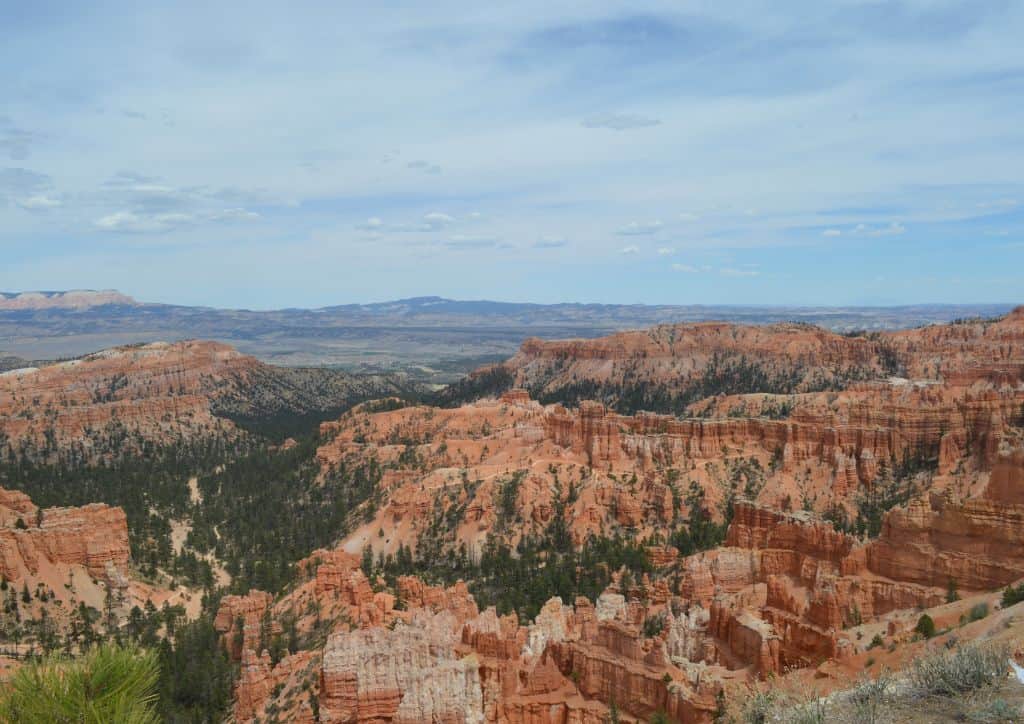
Other popular hikes include the Mossy Cave trail and the Tower Bridge trail.
If you aren’t much of a hiker, consider watching the sunrise at either Sunrise or Sunset Points , which both provide beautiful views of the park.
Another fun activity is going stargazing at night because the park is recognized as a Dark Sky Park.
If you’re looking for somewhere to eat, head down to the small town of Tropic a few miles away and try IDK BBQ .
Best time to visit Bryce Canyon
If you’re planning a visit to Bryce Canyon, consider planning your trip between May and September, as these are the best months for no snow and warm temperatures.
However, the best time to plan is in the shoulder season, which is May and September, as there will be fewer visitors and the temperatures won’t be as hot.
Where to stay for Bryce Canyon
When it’s time to call it a night, head to the Best Western Plus Ruby’s Inn in Bryce. This hotel is just about 2 miles from the park entrance and is within a short distance of everything in town. There’s a large gift shop and convenience shop attached to the hotel, as well as a pool and hot tub to relax in.
➡ Check rates and availability for your stay for Bryce Canyon National Park
Contributed by Kassidy Olson of The Hiking Helper
4. Grand Canyon National Park
The Grand Canyon is one of the most popular National Parks near Las Vegas and one of the most visited tourist destinations in the United States. Every year, millions of people from all over the world flock to see this amazing natural wonder.
Distance and Travel time from Las Vegas to Grand Canyon
- Distance from Las Vegas to Grand Canyon South Rim: About 280 miles
- Travel time from Las Vegas to Grand Canyon South Rim: around 4.5 hours drive
It takes around 4.5 hours drive to reach the South rim of Grand Canyon from Las Vegas. Alternatively, the West rim of Grand Canyon is only around 2 hours drive from Las Vegas and 125 miles away.
A popular stop in the Las Vegas to Grand Canyon road trip is visiting Hoover Dam . I loved walking on the top of the dam and marveling at the massive dam and surrounding scenery.
➡ Alternatively, you can take this highly rated Grand Canyon West Rim With Hoover Dam Stop From Las Vegas full-day tour with Skywalk upgrade.
Taking a road trip from Las Vegas to Grand Canyon is an amazing experience that everyone should have at least once in their lifetime. You get to go at your own pace, see more of Arizona, and enjoy being out on the open road.
Top things to do in Grand Canyon
Some of the best things to do at the Grand Canyon South Rim include taking a mule ride , going for a hike, checking out the viewpoints, and visiting other attractions like Yavapai Point and Grandview Point.
When at Yavapai Point, don’t forget to stop at the Geology Museum and walk the Trail of Time just outside it!
The West Rim of Grand Canyon has a lot of activities catered to tourists and has the Skywalk experience which has a glass platform extending out on the canyon where you can walk and look at the deep Canyon below.
The West Rim also has some popular lookout points like Eagle Point and Guano Point.
Visiting the Grand Canyon West and Hoover Dam are the most popular things to do for families in Las Vegas .
Best time to visit Grand Canyon
The best time of year to visit depends on what you want to do while you’re there. If you’re looking for mild temperatures and few crowds, then spring (March-May) or fall (September-November) are great times to visit.

However, if you want to hike or tour the canyon by mule train, then summer (June-August) is a better choice as that’s when most companies operate these tours.
Where to stay for Grand Canyon
Keep in mind that no matter what time of year you visit, it’s always a good idea to make reservations in advance, as lodging near the park tends to fill up quickly.
If you’re planning on visiting the South Rim of the Grand Canyon, then it’s best to stay inside the park boundaries so that you don’t have to waste time traveling back and forth each day.
El Tovar hotel is a popular option as it’s right on the edge of Bright Angel Trailhead – one of the most popular hiking trails in the Grand Canyon. This hotel tends to fill up quickly though so be sure to make reservations well in advance if this is where you want to stay during your visit.
➡ Check rates and availability for your stay for Grand Canyon National Park
Contributed by Brodi Cole of Our Offbeat Life
5. Antelope Canyon
Antelope Canyon is one of the best places to visit on a road trip from Las Vegas. Antelope Canyon (though not a National Park) is a highly popular and incredible slot canyon located on Navajo land in northern Arizona and is often visited along with Zion and Bryce Canyon.
Distance and Travel time from Las Vegas to Antelope Canyon
- Distance from Las Vegas to Antelope Canyon: About 280 miles
- Travel time from Las Vegas to Antelope Canyon: Around 4 hours 45 minutes
It is a 4-hour and 45-minute (280 miles) drive from Las Vegas to Antelope Canyon, so it can be done in one day, but it’s highly recommended to spend 2 or 3 days doing this road trip. It is common to combine Horseshoe Bend with a trip to Antelope Canyon.
➡ Alternatively, you can take this highly-rated Antelope Canyon and Horseshoe Bend Small Group Tour from Las Vegas which covers both Antelope Canyon and Horseshoe Bend in a day trip and includes admission to the Canyon
Top things to do in Antelope Canyon
The Antelope Slot Canyon was formed by millions of years of water and wind erosion, creating the scenic canyon you can now walk through.
You can see two parts of the canyon, Upper or Lower Antelope Canyon , and you have to take a tour to see either canyon.
If you choose to see Upper Antelope Canyon and go at the right time of day, you can see the famous light beams that shine down from the top of the canyon, creating absolutely gorgeous scenery and even better photos!

If you decide to see Lower Antelope Canyon instead, it is quite an adventure because you have to climb down a few flights of stairs to enter the canyon.
Besides seeing Antelope Canyon, there are plenty of amazing things to see on the way to the area or nearby.
Zion National Park is actually on the way to Antelope Canyon and is a great destination to stop at on your road trip. Another incredible natural wonder to see while you’re in the area is Horseshoe Bend.
Best time to visit Antelope Canyon
The best months to visit this area of the southwest are spring and fall. It can be fairly hot in the summer months, and the attractions can get really crowded. It’s recommended to visit in the shoulder seasons to avoid the crowds as well as the heat.
Where to stay for Antelope Canyon
The best place to stay to visit Antelope Canyon is Page, AZ, which is a 15-minute drive away from the canyon. One of the best hotels in the area is Wingate by Wyndham , a new hotel that has clean, comfortable rooms, a great breakfast, and nice views from the hotel.
➡ Check rates and availability for your stay in Page, AZ for Antelope Canyon
Contributed by Jessica of Unearth The Voyage
6. Horseshoe Bend
Horseshoe Bend (though not a National Park) is an area of the Colorado River where that makes nearly a 180-degree turn and is one of the most recognizable and most visited places in the Glen Canyon National Recreation Area.
Distance and Travel time from Las Vegas to Horseshoe Bend
- Distance from Las Vegas to Horseshoe Bend: About 275 miles
- Travel time from Las Vegas to Horseshoe Bend: Around 2 hours 30 minutes
Although a little far from Las Vegas, a visit to Horseshoe Bend can be combined with Antelope Canyon, which is only 5 miles away.
➡ You can also take this highly-rated Antelope Canyon and Horseshoe Bend Small Group Tour from Las Vegas which includes admission to the Canyon and covers both Antelope Canyon and Horseshoe Bend in a day trip.
Top things to do in Horseshoe Bend
Along with Antelope Canyon and Lake Powell, seeing the famous Horseshoe Bend is one of the best things to do in Page Arizona.
You’ve probably seen pictures of this famous natural attraction on social media as it’s skyrocketed in popularity in recent years. But for good reason! It gives you a unique view of the Colorado River with the towering cliffs it has carved over 500 million years.

It’s gotten so popular that the Navajo Nation now charges $10 for parking. To get to Horseshoe Bend, you need to pay to park and then walk along a relatively flat, paved trail for about 3/4 of a mile.
If you don’t mind sharing the vista with the crowds, then plan on parking about 30 minutes before sunset. Not only is the Arizona desert famous for its painted skies, but the sun sets directly behind the bend, which makes for some amazing photos.
On the other hand, if you want to enjoy the scenery in relative solitude, then make the trek at sunrise instead.
Best time to visit Horseshoe Bend
Horseshoe Bend is open year-round to visitors from sunrise to sunset. That said, weather-wise, Spring and Fall are the best months to visit. Summer sees the most crowds.
Where to stay for Horseshoe Bend
Page doesn’t have any luxury hotels or big resorts, but the Courtyard by Marriott is just five minutes down the road and is one of the best places to stay nearby.
➡ Check rates and availability for your stay in Page, AZ for Horseshoe Bend
Contributed by JJ Haglund of The Minivan Bucket List
7. Great Basin National Park
The high peaks area of Great Basin National Park holds beautiful alpine mountains, elder trees, and incredible caverns. Much of the park lies at elevation, and quite a few of the trails and sights sit above 10,000 feet.
Distance and Travel time from Las Vegas to Great Basin
- Distance from Las Vegas to Great Basin: About 340 miles
- Travel time from Las Vegas to Great Basin: Around 5.5 hours drive
Located about 340 miles (5.5 hours) from Las Vegas, Great Basin showcases a unique Nevadan environment.
Top things to do in Great Basin National Park
Among the high peaks of the Great Basin are the Bristlecone pines , one of the oldest trees in the world. These trees only grow between 6,000 and 11,000 feet in this area and in California.
Along with the Bristlecone Pines, there is the Bristlecone Glacier , the only glacier located within the state of Nevada. The glacier is often hidden underneath rocks, which is why it is often called a “rock glacier”.

Along with the high peaks area, the most incredible sight in Great Basin is the Lehman Caves , one of the best preserved and beautiful examples of cave formations. Even for many who’ve seen several caves, Lehman still manages to stun visitors.
Stargazing is a popular activity in Great Basin National Park on moonless nights.
There’s quite a lot to see among the places within Great Basin. Several areas are not connected internally to the park by roads.
So, for those who want to really explore, a longer stay than a day trip is required. There’s certainly enough within the park to see over a few days, including arches, several bristlecone groves, and beautiful hikes.
Best time to visit Great Basin
Typically summer months of June to September are the best months to visit Great Basin with pleasant weather for activities. The higher elevations can be covered in snow in early summer but the valley can have warmer temperatures.
Where to stay for Great Basin
Lodging options close to Great Basin are very limited, with camping the only option within the park. Outside the park, most options are pretty basic.
Ely, the closest large town, is about 1-hour drive. There are several options to stay in Ely, with the Holiday Inn Express among the best choices in town.
Contributed by Anwar of Beyond my Door
8. Capitol Reef National Park
Capitol Reef National Park is located in south-central Utah in red rock country and is popular for its cliffs and canyons, hiking, geology, and stargazing.
Distance and Travel time from Las Vegas to Capitol Reef
- Distance from Las Vegas to Capitol Reef: About 325 miles
- Travel time from Las Vegas to Capitol Reef: Around 5 hours
Las Vegas to Capitol Reef can be done in as little as two days, but you may want to spend longer exploring the park and surrounding areas. The drive takes about 5 hours (325 miles), making it a little too long to feasibly do as a day trip.
Top things to do in Capitol Reef National Park
Capitol Reef is a large national park with plenty to see and do. Just driving through the park from Torrey to Hanksville lets you see many of the beautiful and unique landscapes the park and area are known for.
If you want to hike, consider Hickman Bridge , Cassidy Arch , and Cohab Canyon . These are all easy to access from the main route through the park and can easily all be completed in a day.

It is worth it to have a four-wheel drive vehicle as well so you can go off-road to visit Cathedral Valley . Some of the most famous features include the Temple of the Sun , the Temple of the Moon , and Glass Mountain which are all located right next to each other.
If you have additional time, consider checking out the neighboring Bentonite Hills that are adjacent to the park. You can see some of these colorful hills on the drive through Cathedral Valley and even more of them on the drive to Hanksville, where you can find lodging and a restaurant.
Best time to visit Capitol Reef
The best time to visit Capitol Reef is in the spring or the fall. It gets very hot in the summer, and there is a higher risk of flash floods and very cold in the winter, with snow possibly making driving more difficult.
Where to stay for Capitol Reef
For accommodations, consider either Hanksville, Loa, or Torrey, depending on which side of the park you want to be on.
Whispering Sands Motel in Hanksville is a great option for the park’s east side.
The Snuggle Inn in Loa is family-run and another good option not too far from the park.
Contributed by Christine of Live Love Run Travel
9. Arches National Park
Arches National Park is an incredible addition to any southwest road trip and a famous National Park near Las Vegas. Whether you start your journey in Salt Lake City or Las Vegas, a road trip to the famous Utah National Park is a scenic and memorable adventure.
Distance and Travel time from Las Vegas to Arches
- Distance from Las Vegas to Arches: About 450 miles
- Travel time from Las Vegas to Arches: Around 6.5 hours
From Las Vegas, plan for about 6 and a half hours, if driving directly to Arches. Although most travelers opt to break up the 450 drive into multiple days with stops at Zion, Bryce, and even Capitol Reef National Parks.
You can even combine Arches and Canyonlands National Parks in one trip with a stay at Moab, Utah.
Top things to do in Arches National Park
Located in eastern Utah, just outside the town of Moab, Arches National Park is best known for its massive red, sandstone natural arches. The most popular of which, Delicate Arch , is featured on the Utah license plate and the Welcome to Utah state signs.

A hike to Delicate Arch is a must-do in the striking park with its beautiful desert landscapes. You’ll want to start the 3-mile long in-and-out hike in the morning hours, particularly if visiting during the busy summer months.
There is very little shade along the hike for you to escape the intense desert heat. So, starting early in the morning not only helps you beat the crowds but also allows you to beat the heat.
Best time to visit Arches National Park
The best time to visit Arches is during the Spring and Fall seasons, as summers can be incredibly hot and not comfortable for hiking.
Where to stay for Arches National Park
While there are a lot of great campsites near Arches, you’ll also find plenty of hotels, restaurants, and breweries in Moab.
If visiting Arches and Moab with kids , the Springhill Suites by Marriott is a nice hotel with an incredible pool that makes for the perfect place to relax and cool often after a morning of hiking and exploring.
Moab town is a great base for exploring both Arches and Canyonlands National Parks.
➡ Check rates and availability for your stay in Moab, UT for Arches National Park
Contributed by Melissa of Parenthood and Passports
10. Canyonlands National Park
Located just a few hours from the bright lights of Las Vegas, Canyonlands is the perfect destination for a quick road trip. Whether you’re looking to escape the heat of the summer or enjoy some winter activities, Canyonlands has something for everyone.
Distance and Travel time from Las Vegas to Canyonlands
- Distance from Las Vegas to Canyonlands: About 450 miles
- Travel time from Las Vegas to Canyonlands: Around 6 hours
Canyonlands National Park is located approximately 450 miles from Las Vegas, which means it’s about a 6-hour drive. If you do want to break it up a little, your best stop options are St George, Cedar City, or a stop at the small town of Monroe.
Top things to do in Canyonlands National Park
Canyonlands is best known for its incredible scenery and off-road trails. Canyonlands is a great place to rent a jeep and explore the Shafer Trail and the White Rim Road . Many people love to enjoy these beautiful and exciting trails that are easy enough for all skill levels.

Be sure to also stop by popular attractions like Grand View Point and Mesa Arch and enjoy a quick stop at the Dead Horse Point State Park. You can also take a Moab jeep tour if you don’t want to drive yourself.
Best time to visit Canyonlands National Park
Canyonlands is open year-round, but the best times to visit are Spring (March-May) or Fall (September-November). This is the ideal time to go since temperatures are milder and there’s less chance of rain.
Where to stay for Canyonlands National Park
If you are camping, a great place to stay is the Sun Outdoors camping location. They have multiple amenities, with a great hot tub and heated pools. Another great, unique experience for glamping is Under Canvas.
For all others, you should check out the Hyatt Place in Moab. They have a large, beautiful pool area with a playground, splash pad, hot tub, and pool. The hotel is modern with a very classy and modern feel that is only about 30 minutes away from the Canyonlands National Park Entrance.
➡ Check rates and availability for your stay in Moab, UT for Canyonlands National Park
No matter what time of year it is or what your interests are, Canyonlands is the perfect destination for a road trip from Las Vegas. With its stunning scenery and plethora of activities, there’s something for everyone at this incredible national park.
Contributed by Candice of CS Ginger
11. Petrified Forest National Park
If you’re looking for a classic United States road trip, there’s perhaps nothing more iconic than cruising along America’s first highway, Route 66.
And if you make your way from Vegas eastward, you’ll get to cruise along parts of this famous highway all the way to Petrified Forest National Park , tucked in the northeastern corner of Arizona.
Distance and Travel time from Las Vegas to Petrified Forest
- Distance from Las Vegas to Petrified Forest: About 366 miles
- Travel time from Las Vegas to Petrified Forest: Around 5.5 hours
Top things to do in Petrified Forest National Park
In this hidden gem of a national park, you’ll get to see striated badlands, colorful deserts, and, of course, fossilized pieces of ancient wood.

One of the best trails in the park is the Blue Mesa Trail , which takes you down below the rim of a mesa to weave your way between indigo-colored bentonite hills.
Alternatively, if you’re a geology buff, the Crystal Forest Trail is an easy loop through the park’s rolling hills, littered with seemingly endless pieces of vibrant petrified wood.
Best time to visit Petrified Forest
Spring and fall are lovely times to visit the park- you’ll beat the heat and the crowds of summertime.
Where to stay for Petrified Forest
Given that Las Vegas is over five hours away, it’s best to visit here on an overnight or weekend trip.
Stay in the nearby town of Holbrook, which has really leaned into the kitschy Americana vibe of Route 66, with plenty of ‘50s diners and dinosaur statues.
La Quinta Inn & Suites by Wyndham Holbrook is a great place to stay, only 20 minutes away from Petrified Forest National Park.
Contributed by Jessica of Uprooted Traveler
12. Joshua Tree National Park
Joshua Tree National Park, in Southern California, is a great destination for desert hiking, rock climbing, birdwatching, and seeing the unique “Joshua Tree”, which is a type of yucca plant found in the Mojave Desert.
Distance and Travel time from Las Vegas to Joshua Tree
- Distance from Las Vegas to Joshua Tree: About 204 miles
- Travel time from Las Vegas to Joshua Tree: around 3.5 hours drive
Joshua Tree National Park is a great multiday road trip destination from Las Vegas. Joshua Tree is located 204 miles and roughly 3.5 hours from Las Vegas, making it too long of a drive for a day trip.
Top things to do in Joshua Tree National Park
Popular hikes in the Joshua Tree National Park include Barker’s Dam, Ryan Mountain, and 49 Palms Oasis Trail.
There are also plenty of sites throughout Joshua Tree National Park worth visiting that don’t require high levels of activity, including Key’s View , Cholla Cactus Gardens , and Skull Rock .

Right outside the national park is a quirky desert town with a whole personality of its own.
Besides hiking in the national park, other things to do in the Joshua Tree area include stargazing at the Sky’s The Limit Observatory , visiting the eccentric desert-style shops, and admiring the many murals and street art found in town.
Perfect for a meal before or after a visit to the national park, recommended restaurants in the area include Natural Sisters and Crossroads Café.
Best time to visit Joshua Tree National Park
Since Joshua Tree is located in the desert, the weather in the summer is extremely hot. Because of this, October-April is the best time to visit Joshua Tree.
Dry weather can be expected during most of the year. However, the occasional thunderstorm and flash flood may occur, so checking the weather before hiking is important.
During the spring, flowers bloom from the desert cacti, bringing something extra special to the desert landscape.
Where to stay for Joshua Tree National Park
AutoCamp Joshua Tree is a great place to stay when visiting Joshua Tree National Park for a desert camping feel without all the work.
Stay in beautifully designed airstreams that provide a unique luxury stay in the desert. It’s located in Joshua Tree town and just a short 10-minute drive to the national park entrance.
Contributed by And There They Went Travel Blog
13. Yosemite National Park
Yosemite is one of the most popular and most visited National Parks in the United States. There are some amazing waterfalls, hikes, and jaw-dropping scenery to be experienced here. This is a bucket list National Park in the United States and a must-see.
Distance and Travel time from Las Vegas to Yosemite
- Distance from Las Vegas to Yosemite: About 450 miles
- Travel time from Las Vegas to Yosemite: Around 7 hours drive
Yosemite is about 450 miles and a 7-hour drive from Las Vegas if done nonstop. If you are traveling in the fall months of September/October, the 395 route is spectacular with fall scenery, and Mammoth Lakes is a good stop. Death Valley is also a good stop on this road trip.
Top things to do in Yosemite National Park
Yosemite is a dream destination for an outdoor enthusiast. Some activities you can enjoy in your Yosemite 2 day itinerary are hiking, biking, rock climbing, fishing, camping, backpacking, birdwatching, and admiring the waterfalls and scenery.
During the Spring and early Summer months, the Yosemite Falls are spectacular. The lower Yosemite Falls trail is accessible and an easy stroll. Bridalveil Fall is another popular waterfall here.
There are some amazing and more challenging hikes here, like the Mist Trail to Vernal Falls and Nevada Falls, the Mirror Lake Loop , and the Upper Yosemite Falls trail.
The most popular and very strenuous hike here is the Half Dome hike , which now requires a permit reservation.

The popular vista points here are Glacier Point, Tunnel View, Valley View, Yosemite Falls, Vernal Falls, El Capitan, and Half Dome.
You can rent a bike at Yosemite Valley Lodge and enjoy Yosemite Valley riding on the bike path.
Best time to visit Yosemite National Park
May and June are great months to visit Yosemite if you want to see the waterfalls. September and October are great months to see fall scenery and fewer crowds.
The summer months of July and August are very crowded.
Although Yosemite National Park is open year-round, During winter in Yosemite , most trails are covered in snow, and the Tioga Pass road is closed. Some roads to Yosemite Valley are open in winter.
Where to stay for Yosemite National Park
The best way to experience Yosemite is to stay inside the park. Accommodations can fill up months in advance.
Curry Village is the most popular and affordable accommodation inside the park, with camping, tent cabins, and wooden cabins.
Yosemite Valley Lodge is another excellent option, with lodge rooms and a food court. Yosemite Valley Lodge is within walking distance of Lower Yosemite Falls.
The Ahwahnee in Yosemite is great for a luxury stay, and we enjoyed staying here for a special occasion. It was a splurge, but it was so worth it!
There are several hotels and resorts outside the park entrance, which can be a good alternative if no accommodations are available inside the park.
➡ Check rates and availability for your stay for Yosemite National Park
14. Las Vegas to Sequoia & Kings Canyon Road Trip
Sequoia and Kings Canyon are excellent parks for a road trip from Las Vegas.
Sequoia National Park and Kings Canyon National Park are actually separate parks but are often visited together as they are right next to each other and are administered by the same management system.
Distance and travel time from Las Vegas to Sequoia & Kings Canyon
- Distance from Las Vegas to Sequoia & Kings Canyon: 400 miles
- Travel time from Las Vegas to Sequoia & Kings Canyon: around 6 hours drive
Both parks are 400 miles from Las Vegas via a 6-hour drive. While you can easily get there in a day, because of the distance and in order to explore both parks fully, this would ideally be a multiday or weekend trip from Las Vegas.
Top things to do in Sequoia & Kings Canyon National Parks
Sequoia National Park is home to the biggest tree in the world- the sequoia. See the biggest of all the sequoia trees, including General Sherman the world’s largest living organism, by hiking the Giants Loop . Moro Rock is another popular hike.

Kings Canyon also has sequoia trees but is better known for its steep canyons and peaks. A must-do in Kings Canyon is a horseback ride.
Try a two-hour ride or have the horse pack in and out your camping gear on a backpacking excursion. Enjoy all the scenery in one peaceful adventure.
Best time to visit Sequoia & Kings Canyon
For the easiest adventure and the best weather, visit in the summer or fall. As these parks are in the Sierra Nevada Mountains, prepare for snow and cold weather if you visit in winter or early spring.
Where to stay for Sequoia & Kings Canyon
Check out The Darling Hotel , a renovated 1930s courthouse, for a vintage and boutique stay. Visalia is the closest major city to the parks and is only a one-hour drive from Sequoia.
Contributed by Cassie of Cassie’s Compass
15. Red Rock Canyon (National Conservation Area)
If you’re in the Las Vegas area and looking for a simple day trip to escape the chaos of the city, consider heading over to Red Rock Canyon National Conservation Area from Vegas !
Distance and Travel time from Las Vegas to Red Rock Canyon
- Distance from Las Vegas to Red Rock Canyon: About 16 miles
- Travel time from Las Vegas to Red Rock Canyon: Around 20 minutes
This beautiful desert region is only 16 miles from downtown Las Vegas, which equates to a quick 20-minute drive from the city.
Top things to do in Red Rock Canyon
Red Rock Canyon is known for its striking Red rock formations and has lots of activities perfect for anyone.
We enjoyed the Red rock Canyon scenic drive through the park and exploring all the vista points.
➡ These top-rated Red Rock Canyon hiking tour , electric bike tour , and scooter tours are an excellent way to explore Red Rock Canyon!
A popular thing to do at Red Rock Canyon is hiking . There are all kinds of trails that range in difficulty, so you can easily find a trail that takes 30 minutes to hike or the entire day, depending on what you’re up for.
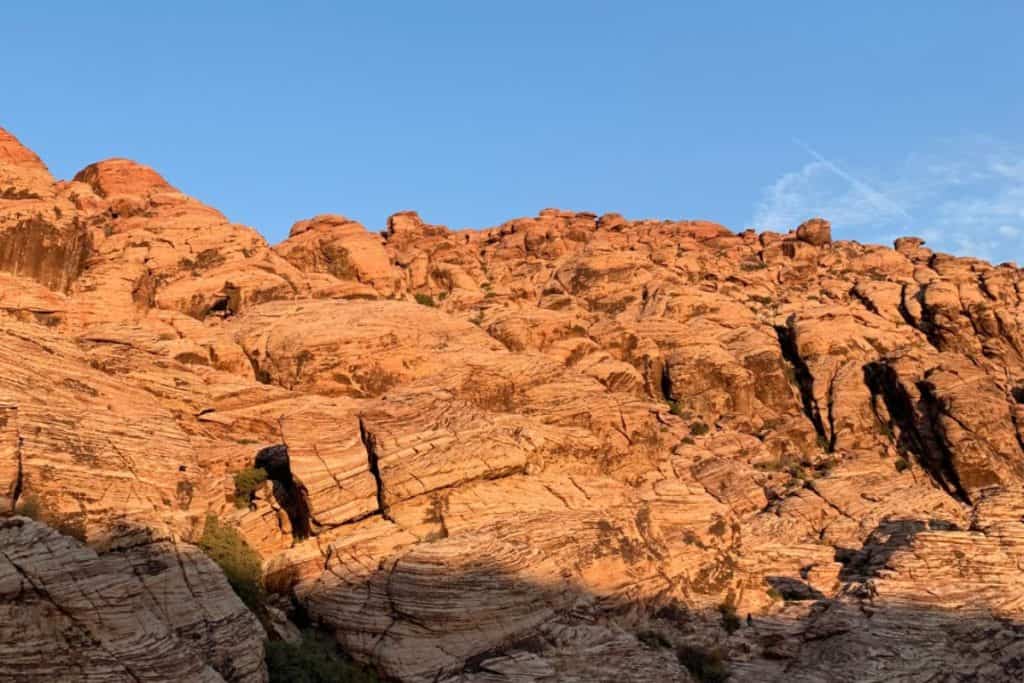
Alternatively, if you enjoy rock climbing , Red Rock Canyon is home to hundreds of different climbing routes. So, whether you’re an avid rock climber or just a beginner who wants to scramble, Red Rock Canyon has it all!
And if you aren’t into hiking and climbing, then consider exploring the stunning canyon area on horseback ! You’ll be able to witness breathtaking views of the local desert, mountains, and wildlife up close. Plus, there are several places to stop along the way, so you can take photos and enjoy all that this area has to offer.
Anu’s pro-tip: Another popular area with red rock formations is Valley of Fire , which is around 50 minutes away from Vegas. Valley of Fire is much more vast and has more dramatic scenery when compared to Red Rock .
Best time to visit Red Rock Canyon
Red Rock Canyon is a desert region, so ideally, Spring, Winter, and Fall are the best seasons to visit as the temperatures are mild to enjoy outdoor activities. Summers can be very hot here.
Where to stay for Red Rock Canyon
If you’re looking for places to stay in the area, consider the Wynn Las Vegas . It’s one of the best resorts to stay in Vegas with family . You’ll be able to enjoy lots of fantastic amenities that will help you relax after a long day exploring the desert area!
Contributed by Kristin Lee of Global Travel Escapades
16. Lake Powell (Navajo Tribal Park)
Located in the Glen Canyon National Recreation Area, Lake Powell is a stunning reservoir that straddles the border between Utah and Arizona.
With 250 square miles of surface area, it is the second-largest artificial reservoir in America and a popular destination for boaters, fishermen, and nature lovers alike.
Distance and Travel time from Las Vegas to Lake Powell
- Distance from Las Vegas to Lake Powell: About 270 miles
- Travel time from Las Vegas to Lake Powell: Around 4 hours
With so much to see at Lake Powell and Page and being far from Las Vegas, it is recommended to take at least a weekend trip. Driving directly from Las Vegas to Lake Powell takes more than 4 hours or 270 miles.
Top things to do in Lake Powell
With its pristine blue waters and stunning desert landscapes, Lake Powell is a mesmerizing place to behold.
Alstrom Point , Waheap Viewpoint , and Glen Canyon Dam provide some of the best vantage points to take in Lake Powell’s beauty. Alstrom Point is more secluded, while Waheap and the dam views are easier to access with just a short detour.

There are a number of things to do on Lake Powell, from fishing and boating to camping and sightseeing. Boating is the most popular activity; rental boats, kayaks, and SUPs are available at both marinas.
Having your own water transport is the only way to see unique landscapes like the lowest part of Antelope Canyon, Labyrinth Slot Canyon, and the incredible Rainbow Bridge. You can also camp on the shores of the lake. Just make sure to leave no trace behind.
Best time to visit Lake Powell
The summer months tend to be the busiest and hottest, while the winter leaves nightly temperatures chilly and a quieter atmosphere. Overall, the best time to visit Lake Powell is during the shoulder seasons – spring and fall – when the weather is milder, and there are fewer crowds.
Where to stay for Lake Powell
If you’re looking for a place to stay near Lake Powell, consider booking the Baymont by Wyndham Page Lake Powell . It’s just a few minutes from the lake and offers various amenities, including a complimentary buffet breakfast, an indoor pool, and parking.
Contributed by Catherine of Nomadicated
17. Lake Mead (National Recreation Area)
Located within Boulder City, Nevada, Lake Mead is an incredible day or afternoon trip from Las Vegas. Lake Mead, a National Recreation Area, is the reservoir created by Hoover Dam and offers many recreational activities.
Distance and Travel time from Las Vegas to Lake Mead
- Distance from Las Vegas to Lake Mead: About 31 miles
- Travel time from Las Vegas to Lake Mead: Around 35 hours
At just 31 miles and 35 minutes by car, visitors can incorporate a quick trip into their busy schedule. Travelers looking for more adventure can stay longer at one of Lake Mead’s 90 campsites and take advantage of all of the adventure activities. Campgrounds have access to both tent and RV sites throughout the park.
Top things to do in Lake Mead
Consider hiking several trails, slot canyons, biking, kayaking, or swimming. Swimming is not permitted in boat launch areas, and boats are not permitted in swimming-only areas.
There is never a lifeguard attendant at any of the beaches, so take precautions. Visitors planning to swim may consider sandals or swim shoes as the walk-up to the water is very rocky.

Visitors looking for relaxation can enjoy views at one of many pull-out stops at several scenic viewpoints along the main roads. Almost all of these stops have bathroom facilities.
Lake Mead National Recreation Area accepts the USA National Parks pass or a $30 entrance fee per vehicle.
Best time to visit Lake Mead
The best months for hiking are considered November through March due to the Mojave Desert’s cooler temperatures. Summer months can boast temperatures as high as 120 degrees Fahrenheit, so this time of year is not recommended for hiking.
Where to stay for Lake Mead
The Hilton Lake Las Vegas Resort and Spa in Henderson , Nevada, comes highly recommended. This 4-star hotel boasts beautiful views of Lake Mead and houses a cafe, spa, pool, and fitness center.
Contributed by Alyssa of An Apple A Plane
18. Monument Valley (Navajo Tribal Park)
Six and a half hours east of Las Vegas, at the border of Utah and Arizona, lies one of the most unique desert landscapes on the planet. Monument Valley is an expansive region of red soil and giant sandstone buttes that was first made famous by Western movies from the 1960s and 1970s.
Distance and Travel time from Las Vegas to Monument Valley
- Distance from Las Vegas to Monument Valley: About 400 miles
- Travel time from Las Vegas to Monument Valley: Around 6 hours 45 minutes
The drive from Vegas is nearly 400 miles but takes you past some incredible places in the Desert Southwest, like Zion National Park, Horseshoe Bend, and Antelope Canyon. A road trip from Vegas to Monument Valley is certainly one of the most beautiful drives in the US.
Top things to do in Monument Valley
There’s no official boundary of Monument Valley, as it’s not a national or state park. It is, however, partially protected as a Navajo Nation Tribal Park. The region lies mostly within the Navajo Nation and is thus Native American land.
The Navajos have protected some of the most spectacular rock formations on the Arizona side of the border, such as Monument Valley Tribal Park. No visit to the region is complete without a scenic drive around the loop road and a hike around the buttes in Monument Valley Tribal Park (entrance $8 per person).
Outside the park boundary, be sure to stop at Forest Gump Point , where you get the epic view of Highway 163 with the buttes in the background, just like Forest had on his run across the country when he decided he was “pretty tired”.
While in the area already, head a little north up 163 to Goosenecks State Park , one of Utah’s hidden gems.
Best time to visit Monument Valley
Monument Valley is a year-round destination and experiences all seasons. Summers can be brutally hot, and winter can feature white-out conditions. Spring and fall are the most comfortable times.
Where to stay for Monument Valley
There are not a whole lot of places to stay in Monument Valley. There is one KOA campsite and a hotel at Goulding’s Lodge.
But if you want a truly unique experience, reserve a night at the Dreamcatcher House, run by Nate, a Navajo local who built the residence himself by hand. The house features an outdoor kitchen and a spectacular view of Monument Valley Tribal Park.
A road trip to Monument Valley will be a drive you will never forget!
Contributed by Chris of Around The World With Me
19. Mojave National Preserve
Mojave National Preserve is perfect for a day trip from Las Vegas or for an overnight camping destination as it is just over the Nevada – California State Line.
Distance and Travel time from Las Vegas to Mojave National Preserve
- Distance from Las Vegas to Mojave National Preserve: About 90 miles
- Travel time from Las Vegas to Mojave National Preserve: Around 1.5 hours
Mojave National Preserve is located 90 miles from Las Vegas and takes about 1.5 hours to reach by car. Its remote location and wide range of desert outdoor activities make it the perfect day trip location for any adventurer visiting Las Vegas.
Top things to do in Mojave National Preserve
While exploring the preserve, you’ll experience the unique geologic formations and the diverse desert ecosystem.
Mojave National Preserve is famous for its extreme landscapes of dense Joshua Tree growth (home to more than Joshua Tree National Park itself), towering Kelso Sand Dunes , and stunning Cinder Cones.
You will find scenic drives, hiking trails, off-roading paths, and some great backcountry campsites inside the preserve.

Some of the top things to do in the Mojave National Preserve include hiking Rings Loop , climbing Kelso Dunes , and exploring the Lava Tube (pictured).
Because of its remote destination, it’s important to prepare ahead of time. Having enough fuel, water, and food before entering the preserve is essential. Some roads do require 4WD, so make sure to visit the Visitor Center in Kelso or Park Headquarters in Barstow for up-to-date information.
Best time to visit Mojave National Preserve
The best time to visit the Mojave National Preserve is in the Spring, between March-May when the wildflowers and cacti begin to bloom. However, the Fall months are also great for exploring the area as the weather starts to cool, making it perfect for hiking and exploring the desert.
The desert is dry most of the year, but checking the weather is essential in case of extreme heat in the summer and thunderstorms that may cause flash floods.
Where to stay for Mojave National Preserve
If you are looking to spend the night in the preserve, there are two designated campgrounds and many dispersed camping areas offering beautiful views.
Outside of the preserve, lodging is limited because of the remote area, and staying in Las Vegas is recommended.
However, you will find the Rio Del Sol Inn , about a 30-minute drive from Mojave National Preserve in Needles, California. This hotel offers clean and family-friendly rooms with a swimming pool to cool down after a long day exploring the desert. It’s the perfect place for resting after enjoying your day at Mojave National Preserve if the drive back to Las Vegas is too far.
What makes Las Vegas the ultimate destination for road trips to nearby National Parks?
Las Vegas can be reached from anywhere in the country within 2-3 hours.
Flights to Vegas are comparatively cheaper, and car rentals are easily available, too.
Plenty of hotel accommodations are available in Vegas for shoulder nights between your road trips and flights.
There are excellent options for Las Vegas hotels off the strip and on the strip .
Las Vegas is within driving distance of several National Parks in California, Utah, Nevada, and Arizona.
Most National Parks and National areas in this road trip list can be reached within 2 to 7 hours of drive from Las Vegas. You can also combine several national parks in a single road trip or take your time visiting one at a time.
Las Vegas is also a premier shopping and dining destination to explore during the days between your road trips.
Final Takeaways: Best Road Trips to National Parks Near Las Vegas
These epic road trips from Las Vegas to National Parks are bucket list experiences. Explore the desert regions of Nevada, Arizona, and Utah and enjoy some fabulous landscapes and vistas.
See some of the most popular National Parks near Las Vegas, like Zion, Bryce Canyon, Grand Canyon, Arches, Death Valley, Joshua, Yosemite, and many other off-the-beaten-path ones like Capitol Reef, Petrified Forest, Great Basin, Canyonlands, Sequoia, and Kings Canyon.
Las Vegas is the ultimate starting and ending point for these road trips to National Parks. So start planning your visit to Vegas and check out the best places to stay in Vegas for your trip!
National Parks near Las Vegas ideal for day trips:
Below National Parks and lands are less than 3 hours drive and can be done as day trips from Las Vegas :
- Death Valley National Park
- Joshua Tree National Park
- Zion National Park
- Red Rock Canyon
- Lake Mead National Recreation Area
- Mojave National Preserve
National Parks near Las Vegas ideal for weekend trips:
Below National Parks and National lands are 4+ hours drive and are best as weekend or long weekend trips from Las Vegas:
- Bryce Canyon National Park
- Grand Canyon National Park
- Great Basin National Park
- Capitol Reef National Park
- Canyonlands National Park
- Arches National Park
- Petrified Forest National Park
- Yosemite National Park
- Sequoia and Kings National Parks
- Antelope Canyon
- Horseshoe Bend (Glen Canyon)
- Lake Powell
- Monument Valley
Related Posts
Planning a trip to Las Vegas? Check out my other related posts:

Best places to stay in Las Vegas: On, Near and Off Strip

21 Best Day Trips from Las Vegas
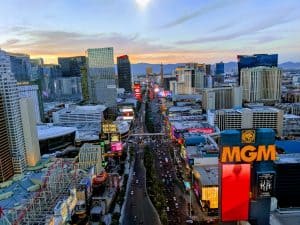
The BEST 3 day Las Vegas family itinerary

Ultimate Las Vegas girls trip: 18 fun things to do in Vegas with girlfriends

14 Best Places to go Shopping in Las Vegas (on and off Strip)
Anu Agarwal is the founder and author of vacation travel blog Destination Checkoff. Anu, a Northern California resident, and a regular nine-to-fiver, loves to vacation with her family to destinations all over the world. She is obsessed with doing endless research for her trips. She has traveled to several destinations in the United States, Canada, Mexico, Europe, and Asia. With her blog, Anu is excited to share her destination itineraries and vacation travel guides and help you check those dream destinations off your bucket list!
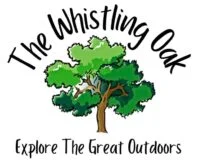
10 Epic Road Trips From Las Vegas To America’s Best National Parks
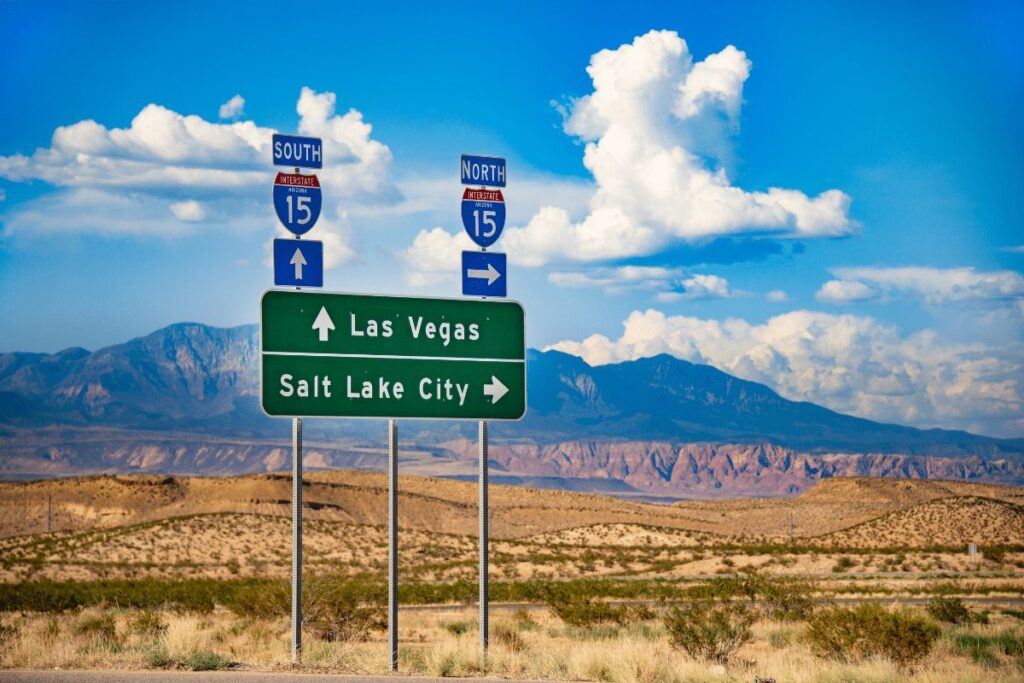
Swap the neon for nature and the slots for slopes as we hit the road from Las Vegas to the wilds of America’s national parks!
This isn’t just about taking snaps with a selfie stick; it’s about stepping into vast canyons, tracing the steps of ancient forests, and maybe even outpacing your own echo.
Ready for an escape that’s a full tank away? We’re mapping out 10 road trips that will take you from the heart of Vegas to the heart of the great outdoors.
We’ve got the lowdown on the must-see sights and the best-kept secrets of each park. Lace up your boots, charge your camera, and let’s roll into the wild spaces that lie beyond the city’s shimmer.
Whether you’re after the grandeur of the Grand Canyon or the mystery of Yosemite, adventure is just a drive away. Let’s rev those engines and set the GPS to adventure!
Table of Contents
Grand Canyon National Park (Our Favorite road trip from Las Vegas)
Grand Canyon National Park is one of America’s most popular national parks, and for good reason. The canyon itself is an amazing natural wonder, and there are plenty of activities to keep visitors busy. Hiking is a popular activity in the park, and there are trails of varying difficulty levels to suit every hiker. For those who want a more leisurely experience, there are also plenty of scenic viewpoints where you can take in the beauty of the canyon.
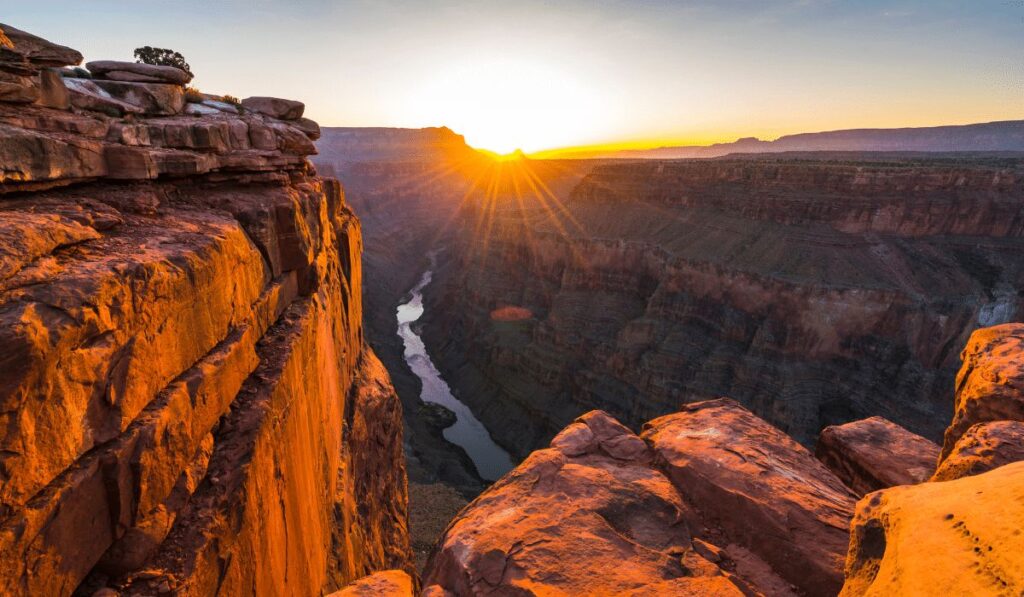
If you’re looking for a road trip from Las Vegas that will take you to some of America’s best national parks, the Grand Canyon should definitely be on your list.
It’s only a few hour’s drive away, and the stunning views are worth the trip. Whether you hike to one of the many viewpoints or witness the canyon from the South Rim, you’ll never forget your trip to this iconic park.
Distance between Grand Canyon National Park and Las Vegas
The Grand Canyon National Park is about 277 miles from Las Vegas. That means it would take about 4 hours and 45 minutes to drive from Vegas to the Canyon. However, there are plenty of other ways to get there. You can fly or take a bus or train. There are even helicopter and hot air balloon rides available!
Sites to see in Grand Canyon National Park
Cascading rivers, colorful rocks, and miles of untouched desert – this is the Grand Canyon. Home to one of America’s most iconic landscapes, Grand Canyon National Park is a must-visit destination for nature lovers and outdoor adventurers alike. In this article, we explore 10 of the park’s must-see sites and attractions that will take your breath away.
The Bright Angel Trail
The trailhead is located at the south rim of the canyon, near Bright Angel Lodge. The trail descends into the canyon, following Bright Angel Creek. There are several rest areas along the way, as well as a ranger station at Indian Garden. The trail ends at Phantom Ranch, which is located on the north side of the Colorado River.
The South Rim Drive
The drive takes you along the south rim of the canyon, providing stunning views of the canyon and its many features. Along the way, you’ll pass by some of the park’s most popular sites, including Bright Angel Point, Mather Point, and Yavapai Point. You’ll also have the opportunity to see a variety of wildlife, including bighorn sheep and mule deer.
The North Rim Drive
The canyon is a massive natural wonder that is truly awe-inspiring. There are many different ways to explore the canyon, but one of the best ways is to take a drive along the North Rim Drive.
The North Rim Drive is a scenic road that takes you along the north rim of the Grand Canyon. The drive is about 60 miles long, and it takes you past some of the most stunning views of the canyon. Along the way, there are several different lookout points where you can stop and take in the view.
If you have the time, we highly recommend taking a leisurely drive along the North Rim Drive. It’s an experience that you won’t soon forget.
Horseshoe Bend
Horseshoe Bend is located on the Colorado River, just downstream from Glen Canyon Dam. The bend in the river forms a horseshoe shape, hence the name.
Horseshoe Bend is accessible via a short hike from a nearby parking lot. The trailhead is located just off Highway 89, about 10 miles south of Page, Arizona. From the trailhead, it is about a 1-mile hike to the overlook. The trail is well-marked and relatively easy to follow.
Once at the overlook, visitors are treated to an incredible view of the Colorado River winding its way through the canyon. The sheer cliffs and unique rock formations make for an unforgettable experience. Horseshoe Bend is truly one of the most amazing places in the world!
Desert View Watchtower
The watchtower offers stunning views of the canyon and the Colorado River below. Visitors can also see the remnants of an ancient Native American village that was once located at the site.
Yavapai Point Observatory
The Grand Canyon is one of the most popular tourist destinations in the United States, and for good reason. The canyon is massive, measuring over a mile deep and 18 miles wide at its widest point. There are many different ways to experience the Grand Canyon, but one of the best is from Yavapai Point Observatory.
Yavapai Point Observatory offers some of the best views of the Grand Canyon. The observatory is located on the South Rim of the canyon, and it provides panoramic views of the entire canyon. Visitors can see all the way to the North Rim of the canyon from here. The views are simply breathtaking, and it’s an experience you won’t soon forget.
If you’re planning a visit to Grand Canyon National Park, be sure to add Yavapai Point Observatory to your list of must-see sites and attractions.
Bright Angel Lodge & Cabins
The lodge is situated on the South Rim of the canyon, just a short walk from some of the most popular attractions in the park. The lodge offers a variety of accommodations, from standard rooms to suites and cabins. Guests can also enjoy a meal at the on-site restaurant, or relax in the lodge’s comfortable common areas.
Whether you’re looking for a place to stay during your visit to Grand Canyon National Park or just want a comfortable place to rest your head after a long day of exploring, Bright Angel Lodge & Cabins is an excellent option.
Grandview Point Trailhead
The trailhead is located on the South Rim of the Grand Canyon, and it offers fantastic views of the canyon. There are several different trails that you can take from Grandview Point, and each one offers different views of the canyon. If you want to get the best views of the canyon, you should definitely hike to Grandview Point.
Lipan Point Lookout Tower
The tower offers breathtaking views of the canyon and is a great place to watch the sunset. There are also many hiking trails nearby that offer beautiful views of the canyon.
Havasu falls
Havasu Falls are one of the most popular attractions in Grand Canyon National Park . The falls are located on Havasu Creek, which is a tributary of the Colorado River. The falls are about 100 feet tall and flow over a series of travertine terraces. The water in the falls is a beautiful blue-green color due to the high mineral content of the creek.
Handpicked things to do in Grand Canyon National Park
Zion national park.
Assuming you’re starting in Las Vegas, Zion National Park is about a 4 hour drive away. The first thing you’ll notice as you approach the park is the stunning red cliffs that make up the landscape.
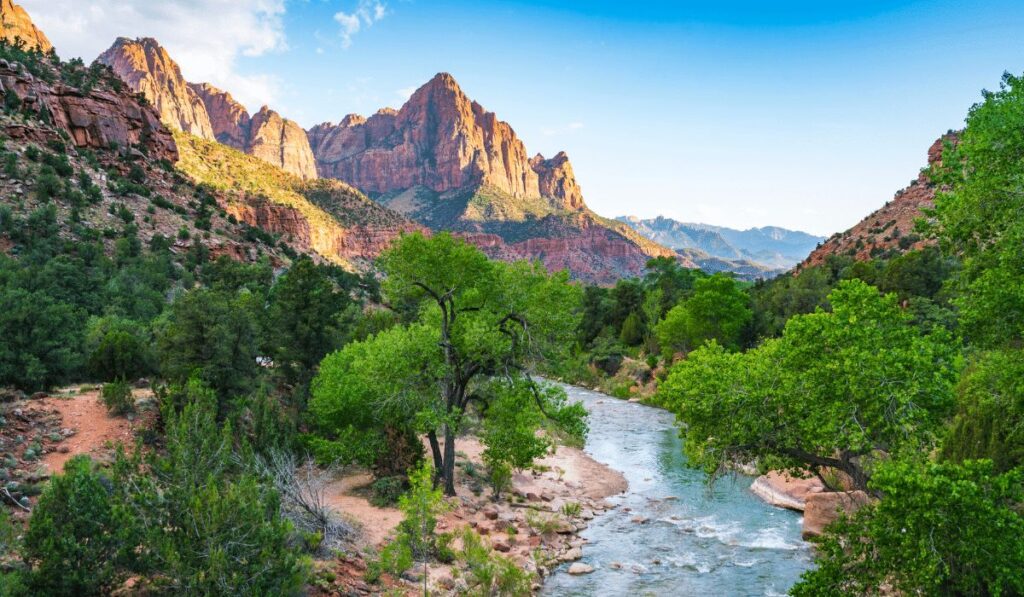
There are plenty of things to do in Zion, from hiking and mountain biking to canyoneering and rock climbing. The most popular hike is probably Angels Landing, which has breathtaking views of the surrounding area. Other must-do hikes include The Narrows (a slot canyon) and Observation Point (for panoramic views of the entire park).
If you’re looking for a more laid-back experience, there’s also plenty to see from driving through the park. Be sure to stop at some of the overlooks, like Zion Canyon Overlook and Checkerboard Mesa Overlook, for some incredible photo ops.
Distance between Zion National Park and Las Vegas
The distance between Zion National Park and Las Vegas is about 167 miles . It takes about 3 hours to drive from Zion National Park to Las Vegas. The drive is very scenic and there are many things to see along the way. Las Vegas is a great place to visit after spending time in Zion National Park. There are many hotels, casinos, and restaurants to enjoy in Las Vegas.
Sites to see in Zion National Park
Zion National Park is one of the most popular tourist destinations in Utah. With its stunning redrock cliffs, towering waterfalls, and ever-changing landscapes, it’s no wonder why people flock to this park year after year. While there are plenty of amazing sites to see in Zion, here are just a few of the must-sees:
The Narrows is one of the most iconic hiking trails in Zion National Park. This trail takes you right into the heart of slot canyon, where you can experience firsthand the power and beauty of nature. Be sure to wear sturdy shoes and bring plenty of water, as this hike can be challenging.
Angels Landing is another popular trail that offers breathtaking views of Zion Canyon. This strenuous hike requires some scrambling and steep drop-offs, but it’s well worth it for the incredible views at the top.
If you’re looking for something a little more relaxed, take a scenic drive through Zion Canyon Scenic Drive . This winding road will take you past some of the most beautiful scenery in the park, including The Oracle, Checkerboard Mesa, and Weeping Rock .
Zion Canyon is the perfect place to hike, backpack, or just explore. There are numerous trails ranging from easy to strenuous, so there’s something for everyone. The scenery is absolutely stunning, and you’ll get to see a variety of plants and animals .
Weeping Rock is a must-see for its unique geological features. Angel’s Landing is another popular spot for its incredible views. If you’re up for a challenge, try hiking to the top of Observation Point – it’s definitely worth it!
Emerald Pools is another top spot in Zion National Park. The pools are fed by waterfalls and surrounded by lush vegetation – it’s truly a sight to behold. You can also hike to Upper Emerald Pool for an even better view.
No matter what your interests are, there’s sure to be something for you to see at Zion National Park . So come on down and explore all that this incredible place has to offer!
Handpicked things to do in Zion National Park
Bryce canyon national park.
Bryce Canyon National Park is a world-renowned spot for stargazing, and with its remote location far from city lights, it offers some of the darkest skies in the country. The best time to visit for stargazing is during the new moon phase when the night sky is at its darkest.
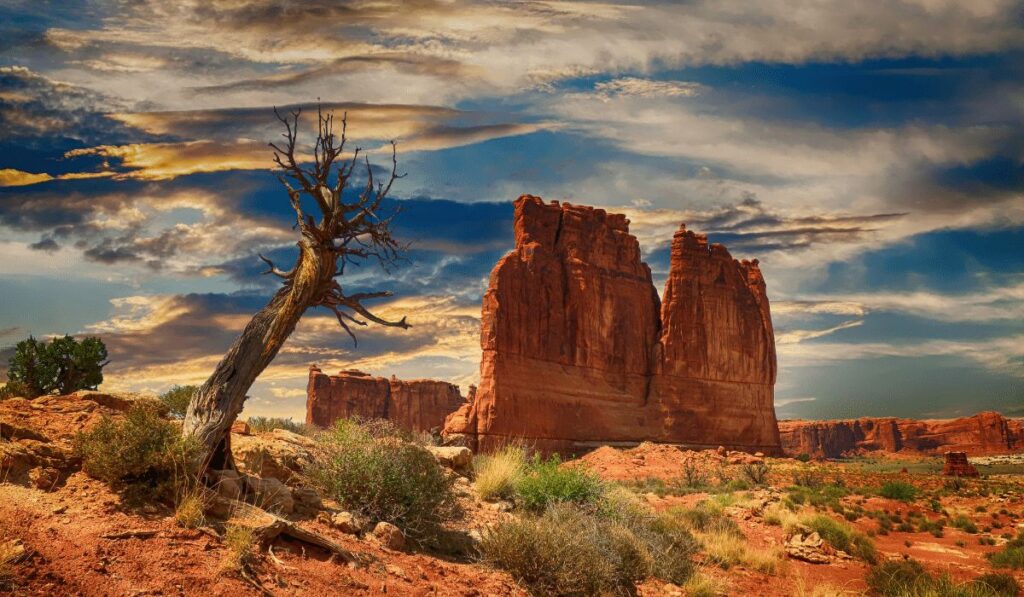
Bryce Canyon also has a Junior Ranger Program, where kids can earn their junior ranger badge by completing fun activities like attending a ranger-led program, going on a nature hike, or learning about Leave No Trace principles.
Distance between Bryce Canyon National Park and Las Vegas
The distance between Bryce Canyon National Park and Las Vegas is about 270 miles . This means that it would take around 4 hours to drive from one location to the other. However, the drive is definitely worth it because of the amazing scenery along the way. Bryce Canyon National Park is home to some of the most beautiful landscapes in the country. The red rock formations and canyons are truly a sight to behold. L
Sites to see in Bryce Canyon National Park
Bryce Canyon National Park is home to some of the most amazing geological sites in the world. The canyon itself was carved over millions of years by erosion from wind and water, and is now home to a wide variety of unique rock formations. Here are just a few of the many sites to see in Bryce Canyon National Park:
The Hoodoos – These strange and iconic rock formations are perhaps the most well-known of all the sites in Bryce Canyon. They are tall, thin spires of rock that were formed by erosion from wind and rain.
The Rim Trail – This popular trail takes you along the edge of Bryce Canyon for some stunning views of the hoodoos and other rock formations. It can be accessed from several different points along the park road.
Sunrise Point – As its name suggests, Sunrise Point is a great place to watch the sun rise over Bryce Canyon. It’s one of the highest vantage points in the park, so you’ll be able to see for miles in every direction.
The Navajo Loop Trail takes you down into the canyon itself, past some of the most impressive hoodoos. The Queen’s Garden Trail is another option, and it leads you to a group of hoodoos known as Queen Victoria’s Garden. No matter which trail you choose, you’re sure to be amazed by these natural wonders.
There are countless other sites to see in Bryce Canyon National Par k, including waterfalls, hiking trails, and more. Whether you’re looking for amazing views or an opportunity to get up close and personal with nature, Bryce Canyon has something for everyone. There is also some amazing wildlife to encounter!
Handpicked things to do in Bryce Canyon National Park
Capitol reef national park.
If you’re looking for an epic road trip from Las Vegas, look no further than Capitol Reef National Park. This incredible park is located in southern Utah and is known for its stunning rock formations, canyons, and hiking trails.
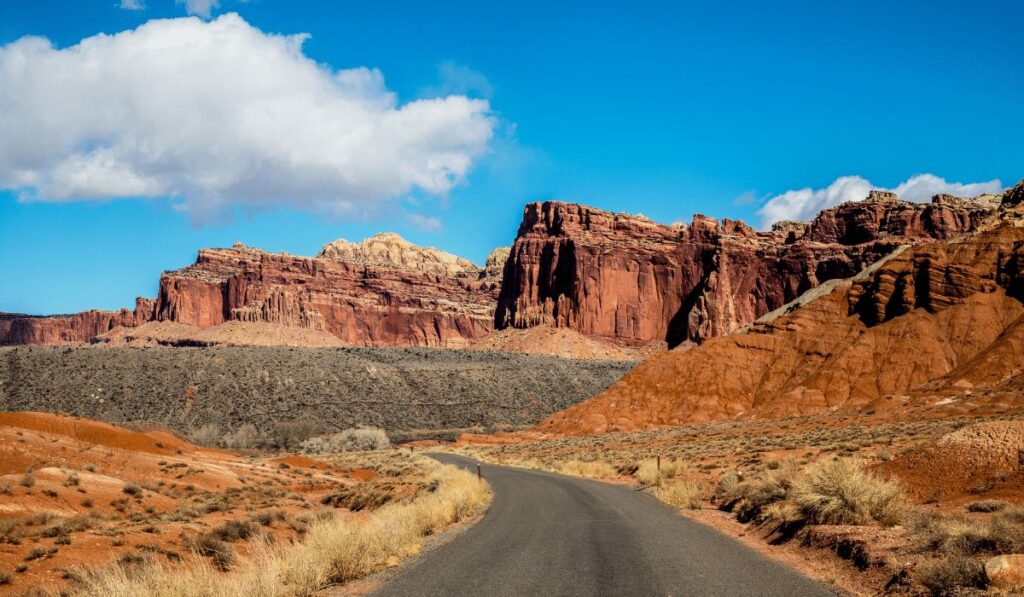
Capitol Reef is the perfect place to explore if you love nature and being outdoors. There are plenty of easy hikes that all levels can enjoy, as well as more challenging trails for the more experienced hikers. And don’t forget to bring your camera, because there are plenty of photo opportunities throughout the park!
Distance between Capitol Reef National Park and Las Vegas
The distance between Capitol Reef National Park and Las Vegas is about 328 miles and takes around 5 hours and 15 minutes hours by car. This may not seem like a long distance, but when you factor in the time it takes to drive through the winding roads and mountains, it can feel like a lot longer.
The scenery along the way is stunning, though, so it’s worth taking your time to enjoy it. And once you arrive at Capitol Reef, you’ll be glad you made the journey. The park is full of fascinating geological features, amazing hiking trails, and beautiful views.
So whether you’re looking for an exciting road trip or a chance to explore one of America’s most unique national parks, the distance between Capitol Reef and Las Vegas is definitely worth it.
Sites to see in Capitol Reef National Park
Capitol Reef National Park is located in southern Utah and is known for its incredible geological formations. The park has many different hiking trails and scenic drives that allow visitors to explore the area. Some of the most popular sites to see in Capitol Reef National Park include:
The Capitol Dome : This massive rock formation is one of the most recognizable features in the park. The Capitol Dome is a great place to hike and take in the views.
The Petroglyph Panel : This panel of petroglyphs is located near the park entrance and is a must-see for anyone interested in Native American history.
The Waterpocket Fold: This massive geologic feature extends for over 100 miles through the park. The Waterpocket Fold is a great place to explore on foot or by car.
Cathedral Valley is a stunning valley with towering red rock formations. The area is accessible via a four-wheel drive road and is well worth the effort to get there. Chimney Rock is a unique rock formation that resembles a chimney. It’s located in an area of the park called The Needles and is definitely worth a visit.
Grand Wash Canyon is a truly majestic sight. This huge canyon has walls that are over 1,000 feet tall in some places. The best way to see it is by taking the scenic drive through it. Along the way, you’ll pass by several amazing viewpoints where you can stop and take in the views.
Whether you’re looking for amazing geology, incredible views, or a chance to get away from it all, Capitol Reef National Park is sure to have something for you. So, what are you waiting for? Start planning your visit today!
Handpicked things to do in Capitol Reef National Park
Arches national park.
Arches National Park is located in eastern Utah, just north of the Colorado River. The park is known for its more than 2,000 natural sandstone arches, as well as its red rock formations, canyons, and desert landscapes.
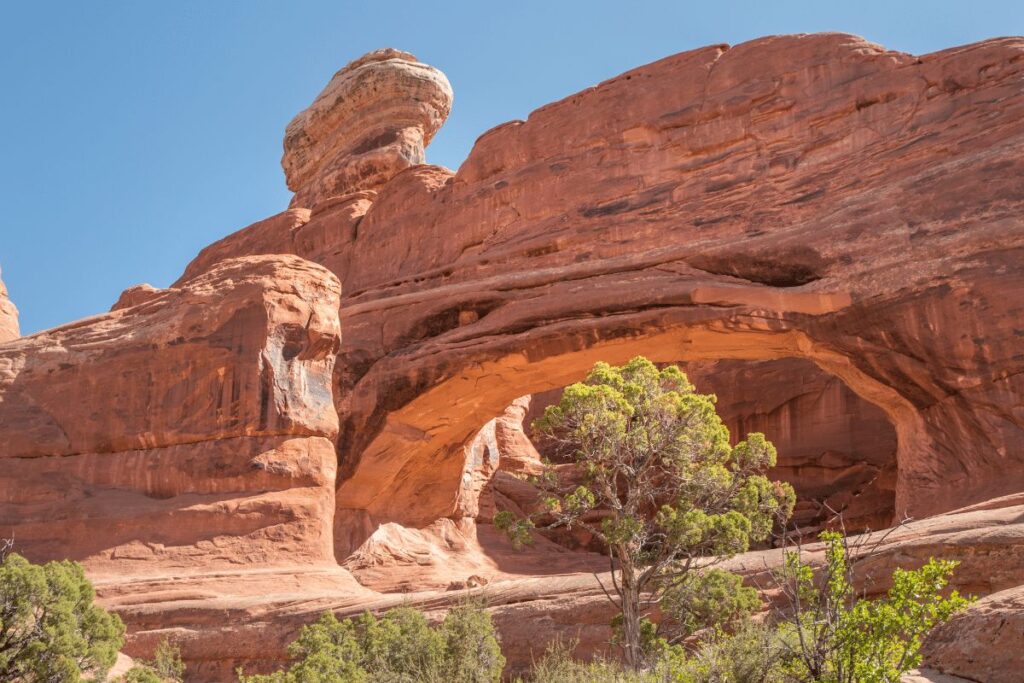
Visitors can explore the park via its many hiking trails, ranging from easy walks to challenging hikes. In addition, there are plenty of opportunities for other outdoor activities such as camping, stargazing, wildlife watching, and rock climbing.
Distance between Arches National Park and Las Vegas
This amazing journey, of 450 miles taking 7 hours, will take you through some of the most stunning scenery in the world, and you’ll get to experience it all first-hand. From the massive red rocks of Arches National Park to the bright lights of Las Vegas, this is a trip that you won’t want to miss.
Sites to see in Arches National Park
There are few places on earth as stunning as Arches National Park . Situated in the heart of Utah’s red rock country, the park is home to more than 2,000 natural stone arches, as well as a wealth of other incredible geological features .
Whether you’re looking to hike, climb, camp, or simply take in the views, Arches National Park should definitely be on your list of places to see. Here are just a few of the amazing sites you can find within its boundaries.
The Delicate Arch is perhaps the most iconic symbol of the park (and indeed, of Utah itself). This 50-foot-tall freestanding natural arch is carved from sandstone and stands atop a windswept plateau. The views from here are truly breathtaking.
For something a little different, check out the Fiery Furnace – an area of erratic red rock fins and narrow passageways that will challenge even the most experienced hikers. But it’s worth it for the incredible views at the top.
And of course, no visit to Arches National Park would be complete without seeing some of its namesake arches. Balanced Rock is one of the most popular – a massive boulder precariously perched atop a slender base. Or check out Double Arch , two massive arches that frame an idyllic desert scene.
Handpicked things to do in Arches National Park
Canyonlands national park .
Canyonlands National Park is one of the most unique and beautiful national parks in America. Located in Utah, this park is home to some of the most dramatic canyon scenery in the world.
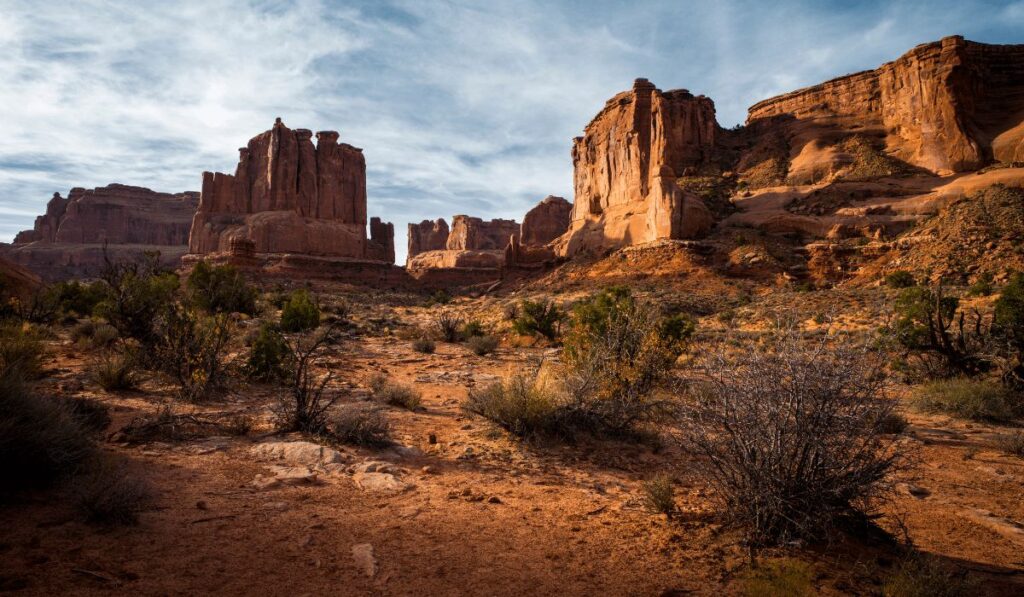
Visitors can explore canyons, mesas, and other geological features by foot, horseback, or four-wheel drive. There are also many opportunities for backcountry camping, hiking, and mountain biking.
Canyonlands National Park is divided into four distinct areas: the Island in the Sky, the Needles, the Maze, and the rivers.
The Island in the Sky district is known for its views of the canyons below and provides short day hikes along with scenic drives.
The Needles district contains sandstone spires that are popular for climbing.
The Maze district has long, rugged trails that require backcountry experience.
And finally, the rivers area allows for exploration by boat or canoe.
No matter what activities visitors engage in, there are plenty of opportunities to spot amazing wildlife including bighorn sheep, desert foxes, and various raptors such as eagles and hawks. Moreover, beautiful wildflowers bloom throughout spring and summer offering colorful displays in this red rock wonderland.
Distance between Canyonlands national park and Las Vegas
The distance between Canyonlands national park and Las Vegas is about 7 hours by car and covers around 480 miles . The drive is very scenic and you will be able to see a lot of different landscapes along the way. Once you get to Canyonlands, there are plenty of hiking trails to explore and you can also go canoeing, kayaking, or rafting on the Colorado River.
Sites to see in Canyonlands national park
Canyonlands National Park is an American national park located in southeastern Utah near the town of Moab. The park is divided into four districts: the Island in the Sky, the Needles, the Maze, and the rivers themselves. Canyonlands was established as a national park on September 12, 1964.
There are many sites to see in Canyonlands National Park . The most popular area is probably the Island in the Sky district . This is because it offers stunning views of canyons and mesas from its many overlooks. Some of the other popular sites include Mesa Arch, Grand View Point, and Dead Horse Point State Park .
The Needles district is named for its red rock formations that resemble needles. This area is popular for hiking, camping, and rock climbing. Some of the more popular trails include Chesler Park Loop and Joint Trail.
The Maze district is the least accessible part of the park due to its remote location and lack of roads. However, this does not deter adventurous visitors who come here for hiking, camping, and backpacking. The most popular trail in this district is the Harriman Trail which leads to several different Ancestral Puebloan ruins .
Last but not least are the rivers themselves which run through all four districts of Canyonlands National Park. These include the Green River, Colorado River, and San Juan River . Visitors can float down these rivers or go kayaking/canoeing .
Handpicked things to do in Canyonlands national park
Yosemite national park.
I’ve always been fascinated by mountains. Their rocky peaks and stubbornness to stand tall despite the elements have always been a source of inspiration for me. So, when I found out that there was a national park less than 10 hours away from Las Vegas that was home to some of the most beautiful mountain scenery in the country, I knew I had to go.
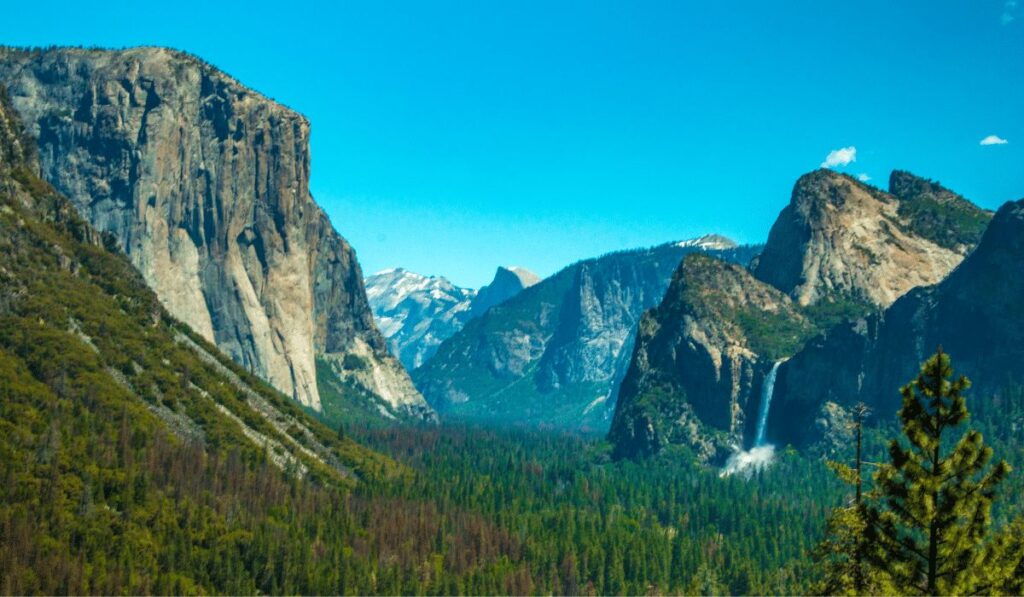
Yosemite National Park is one of America’s best national parks for a reason. The granite cliffs, river canyons, waterfalls, and giant sequoia trees are unlike anything else in the world. And with so many different hiking trails, there’s something for everyone.
One of the best things about Yosemite is that it’s easily accessible from Las Vegas. Although it’s a long drive, it’s definitely doable in one day if you make an early start. And trust me, it’s worth it.
Distance between Yosemite National Park and Las Vegas
If you’re planning a road trip from Las Vegas to Yosemite National Park, you may be wondering how far apart the two destinations are. The answer may surprise you – it’s only about 450 miles ! That means you can easily make the journey in a day, or even less if you’re willing to push on through.
The drive is an enjoyable one, especially if you take the scenic route through Death Valley National Park. You’ll get to see some amazing landscapes and maybe even spot some wild animals along the way. And once you arrive at Yosemite, you’ll be rewarded with incredible views, hikes, and more. So don’t delay – start planning your trip today!
Sites to see in Yosemite National Park
There are so many sites to see in Yosemite National Park , it’s hard to know where to start! Whether you’re interested in history, nature, or just want to take in the incredible views, there’s something for everyone. Some of the most popular sites include Glacier Point, Tunnel View, and Bridalveil Fall.
Glacier Point is a must-see for any visitor to Yosemite. From this vantage point, you can see some of the park’s most iconic landmarks, including Half Dome and Yosemite Valley. The views are simply breathtaking!
Tunnel View is another popular spot in the park. Here, you’ll get an incredible view of El Capitan and Yosemite Valley. It’s the perfect place to snap a photo or just enjoy the scenery.
Bridalveil Fall is one of Yosemite’s many waterfalls and it is truly a sight to behold. The fall flows over a sheer cliff face and is especially beautiful when illuminated by the sun. If you’re lucky, you may even see a rainbow!
Yosemite National Park is full of amazing sites to see! From the famous Half Dome and El Capitan to the beautiful Yosemite Valley, there’s something for everyone to enjoy.
Half Dome is perhaps the most iconic site in Yosemite. Standing at over 4,000 feet, it’s a challenging hike to the top, but the views are truly breathtaking. El Capitan is another popular destination, especially for rock climbers. At over 3,000 feet tall, it’s one of the tallest peaks in Yosemite.
Yosemite Valley is another must-see when visiting Yosemite National Park. This stunning valley is home to some of the most beautiful scenery in all of Yosemite. Make sure to take a hike or bike ride through the valley to really take in all its splendor!
Handpicked things to do in Yosemite National Park
Sequoia national park.
Sequoia National Park is one of the most popular national parks in the United States, and for good reason. The park is home to some of the world’s largest trees, including the General Sherman Tree, which is the largest tree in the world.
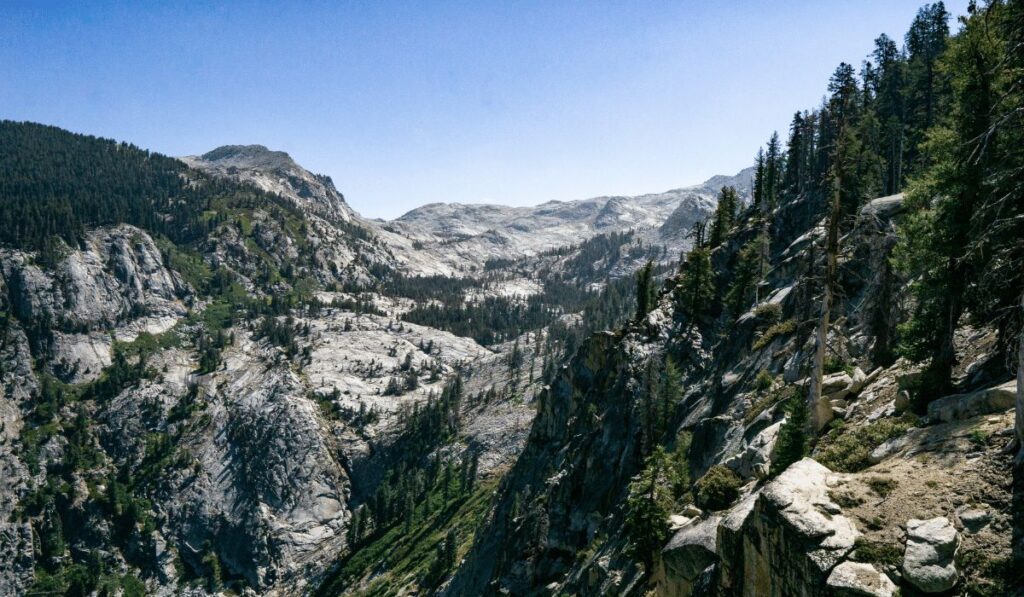
Sequoia National Park is also home to a variety of other attractions, such as the Giant Forest, where you can see giant sequoias that are over 2,000 years old. There are also a number of hiking trails throughout the park that offer stunning views of the surrounding area.
Distance between Sequoia National Park and Las Vegas
With a driving distance of just under 400 miles, Sequoia National Park is a great choice for a weekend getaway from Las Vegas. The majestic sequoia trees are definitely worth the trip, and there are plenty of other attractions to keep you busy during your stay.
Hiking, biking, and horseback riding are all popular activities in the park, and there are also several ranger-led programs available. If you’re looking to escape the hustle and bustle of the city for a few days, Sequoia National Park is the perfect place to do it.
Sites to see in Sequoia National Park
Sequoia National Park is one of the most beautiful places on Earth. It is home to some of the tallest trees in the world, as well as vast meadows, rushing rivers, and stunning granite cliffs. There is so much to see and do in Sequoia National Park that it can be hard to know where to start. Here are just a few of the must-see sights in this amazing place:
The General Sherman Tree is the largest tree on Earth. Standing at over 275 feet tall, it is truly an awe-inspiring sight. Make sure to take a photo at its base – it’s so big that you won’t be able to fit the whole tree into one frame!
The Giant Forest is home to some of the tallest trees in Sequoia National Park. Walking among these enormous trees is an unforgettable experience. Make sure to look up – some of the branches are so high that they disappear into the mist.
Moro Rock is a massive granite dome that offers incredible views of the surrounding landscape. The hike to the top is short but strenuous, and it’s definitely worth it for the views. Be sure to bring your camera!
These are just a few of the many sights that you’ll find in Sequoia National Park. So what are you waiting for? Pack your hiking boots and your camera and head off on an adventure!
Handpicked things to do in Sequoia National Park
Valley of fire state park.
Valley of Fire State Park is one of Nevada’s most popular state parks. It is located just a short drive from Las Vegas and is known for its stunning red rock formations. The park offers a variety of hiking trails, camping sites, and picnic areas. There is also a Visitor Center with exhibits on the geology and history of the area.
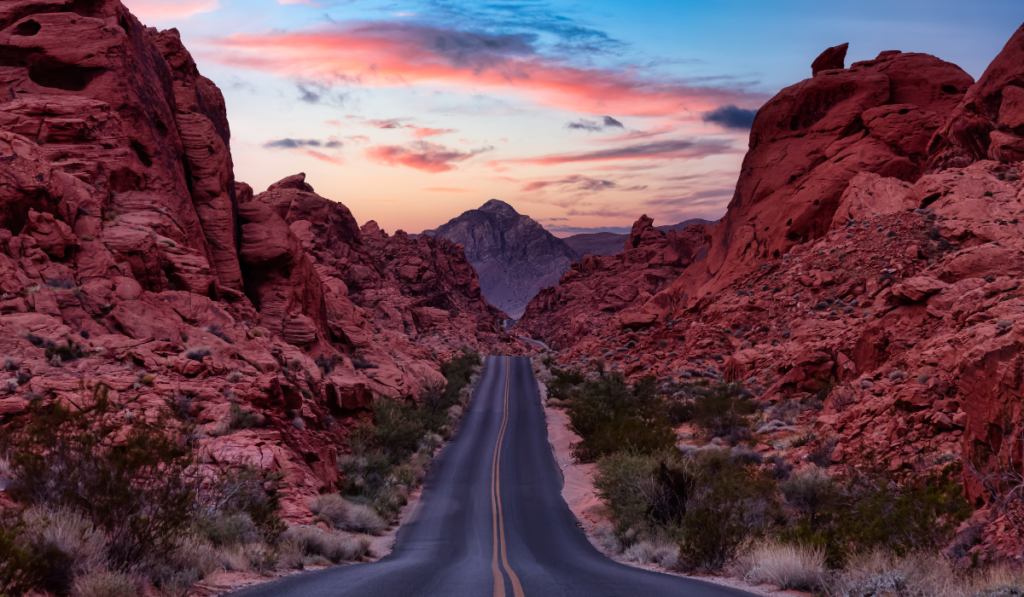
Distance between Valley of Fire State Park and Las Vegas
Located just a short distance from Las Vegas, the park offers stunning red rock formations, petroglyphs, and hiking trails. Visitors can also enjoy camping, picnicking, and ranger-led programs.
The Valley of Fire is approximately 46 miles from Las Vegas. However, the drive is about an hour due to the winding roads. The scenic route takes visitors past desert landscapes and through canyons. The Valley of Fire State Park is definitely worth the drive!
Sites to see in Valley of Fire State Park
Valley of Fire State Park is home to some of the most incredible sites in the world. From the towering red rock formations to the stunning petroglyphs, there is something for everyone to see. Here are just a few of the must-see sites in Valley of Fire State Park.
Red Rock Canyon : This canyon is home to some of the tallest and most impressive red rock formations in the park. Be sure to hike to the top for an incredible view.
Petroglyph Canyon: This canyon is covered in ancient petroglyphs that date back thousands of years. It’s a truly fascinating place to explore.
White Domes : The White Domes are some of the most recognizable features in Valley of Fire State Park. These massive white rock formations are truly a sight to behold.
Mouse’s Tank : Mouse’s Tank is a small but popular hiking destination in the park. The trail leads to a natural water tank that is a great place to cool off on hot days.
Handpicked things to do in Valley of Fire State Park
Death valley national park.
Death Valley National Park is one of America’s most popular national parks. Located just a few hours’ drive from Las Vegas, it is a great destination for a road trip.
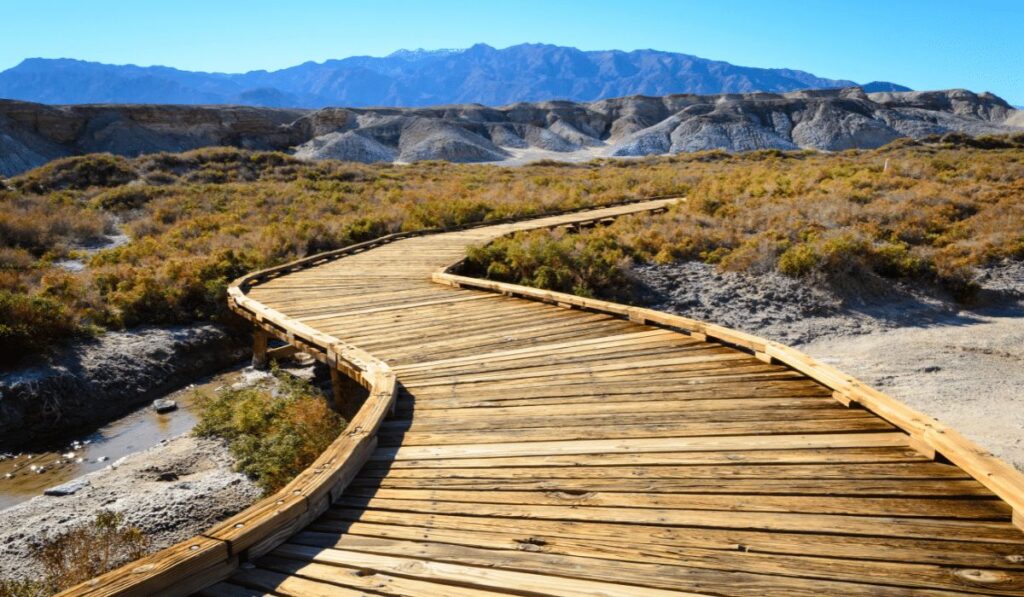
The park is home to many landscapes, including the lowest point in North America, Badwater Basin. Visitors can also see the iconic Joshua Tree forests and the amazing views from Zabriskie Point.
There are plenty of activities to keep visitors busy, such as hiking, camping, and stargazing. Death Valley is also a great place to enjoy some winter sports, such as skiing and snowboarding.
Because of its diverse geography and extreme temperatures, Death Valley is a great destination for those looking for an adventure. Whether you’re hiking through the desert or exploring the canyons, there is something for everyone in Death Valley.
Distance between Death Valley National Park and Las Vegas
If you’re looking for an exciting road trip, look no further than the distance between Death Valley National Park and Las Vegas. It’s sure to be a thrill ride that you’ll never forget. At just over 120 miles , this journey will take you through some of the most breathtaking scenery in the country. You’ll wind your way through canyons, mountains, and deserts, all while getting a taste of Las Vegas’ world-famous nightlife. So buckle up and get ready for an adventure of a lifetime.
Sites to see in Death Valley National Park
There are plenty of sites to see in Death Valley National Park ! The park is home to some of the most spectacular views in the country, and there is something for everyone to enjoy. From hiking and camping to stargazing and sightseeing, there is no shortage of activities to keep you busy. Here are just a few of the many sites to see in Death Valley National Park:
The Racetrack Playa is a must-see for any visitors to the park. The dry lake bed is covered in fascinating “racetracks” left behind by stones that have been moved by the wind. It’s a truly unique sight that you won’t find anywhere else in the world!
For those who love hiking, Zabriskie Point is one of the most popular trails in the park. The trailhead begins at Badwater Basin, which is the lowest point in North America. The hike takes you up to stunning views of the valley below, and it’s an unforgettable experience.
If you’re looking for an otherworldly experience, then be sure to check out Artist’s Drive . This 9-mile scenic drive takes you through colorful hills and mountains that have been eroded over time into strange and beautiful shapes. It’s like something out of a dream!
These are just a few of the many sites to see in Death Valley National Park. With so much to explore, you’ll want to come back again and again to experience all this incredible place has to offer!
Handpicked things to do in Death Valley National Park
Traveling from Las Vegas to America’s best national parks is an amazing opportunity to explore the beauty of our country.
With these 10 epic road trips, you can choose the perfect route for your idea of a great journey. From Utah’s spectacular red rocks, Death Valley’s otherworldly landscapes, and Grand Canyon’s jaw-dropping vistas, there are so many places that offer unforgettable memories and once-in-a-lifetime experiences.
So, get ready to pack up your bags and hit the open roads on a truly incredible adventure!
About The Author
Related Posts
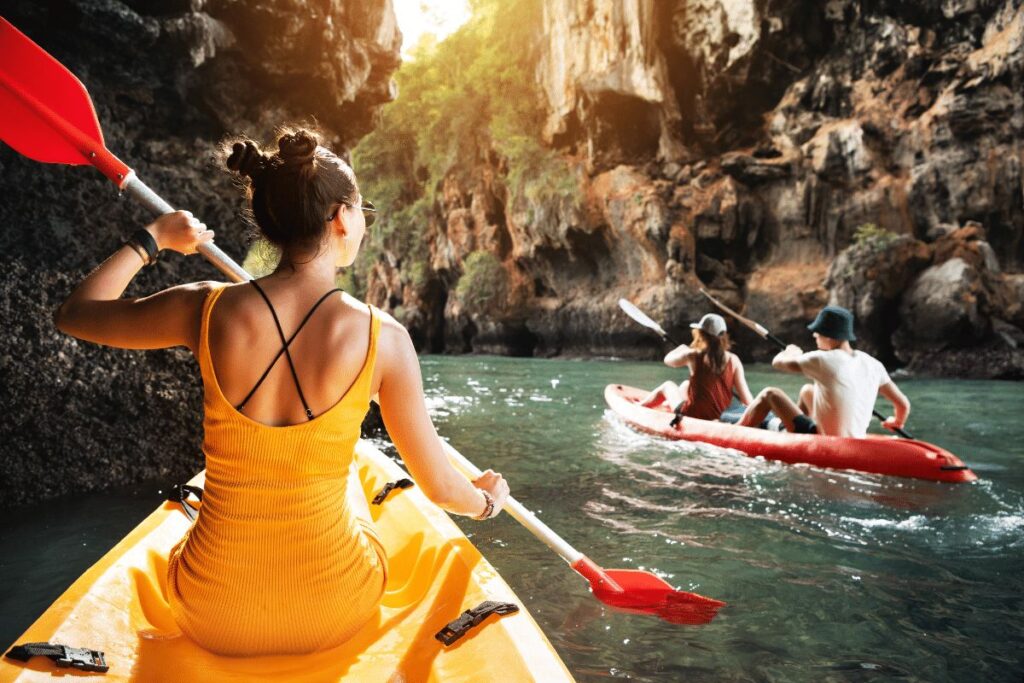
10 Favorite Kayaking Tours From Las Vegas For the Ultimate Adventure!
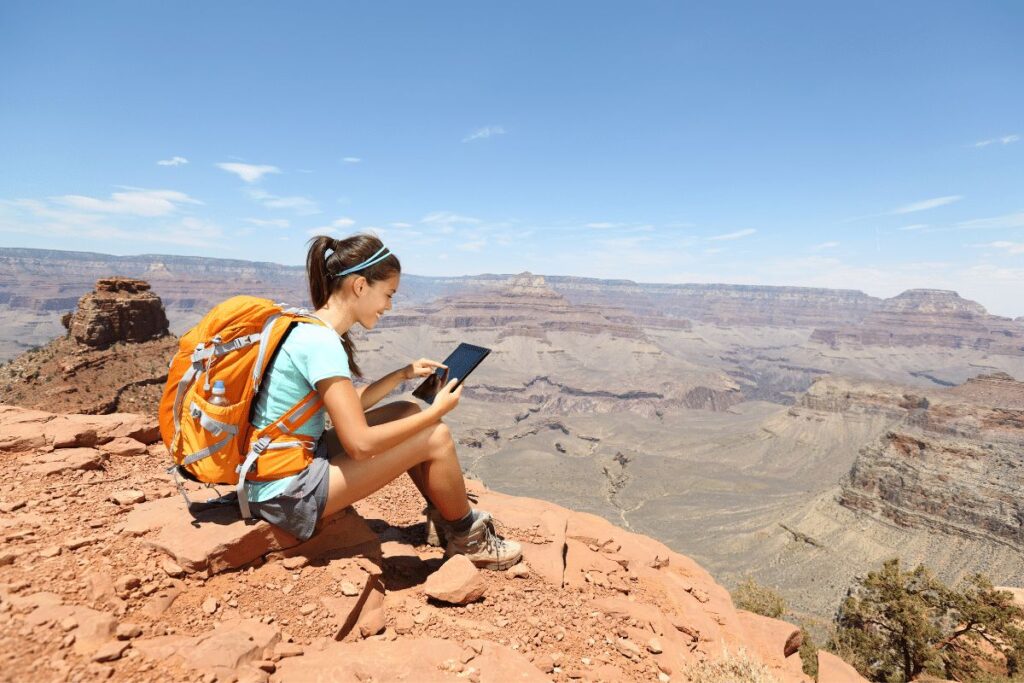
6-Day Ultimate Hiking Trip From Las Vegas! (Grand Canyon and Zion Included)
Leave a comment cancel reply.
Your email address will not be published. Required fields are marked *
Save my name, email, and website in this browser for the next time I comment.
This site uses Akismet to reduce spam. Learn how your comment data is processed .

- Privacy Policy
- Galapagos Islands
- Philippines
- Africa Overland
- New Zealand
- Solo Travel
- Backpacking
USA , Itineraries , Road Trips
Utah’s national parks: ultimate 5-day road trip from vegas.
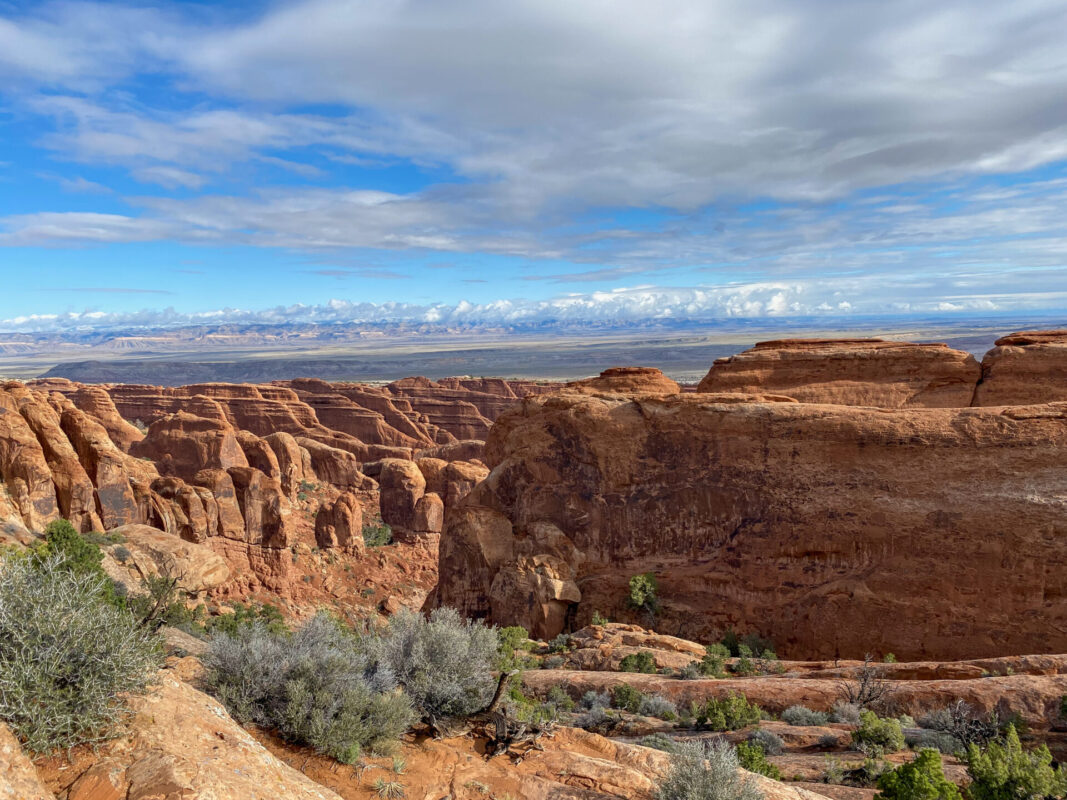
Table of Contents
Planning a road trip through Utah’s National Parks? I’m here to help! This is one of my favourite road trips I’ve ever done. The diversity of Utah’s scenery and landscapes is breathtaking. It almost feels like being transported to another planet.
Utah is like nowhere else on Earth. With its magnificent red landscape and unusual rock formations, Utah is home to some of the most unique national parks in the United States. It’s the perfect place for a road trip.
In this post, I’ve shared a 5-day itinerary through Utah’s National Parks which starts and ends in Las Vegas. The itinerary takes you through Utah’s epic ‘Mighty 5’ – the five National Parks of Utah. It’s a jam-packed itinerary to say the least but an epic one at that.
I’ve also suggested additional spots for those who have more time on their road trip, including destinations a little further afield. The itinerary can also be adjusted to start in Las Vegas and end in Salt Lake City .
There are a couple of long drives in this itinerary, but I promise it’s worth it!
Make sure you’re prepared for your trip and know what to pack for your journey through Utah .
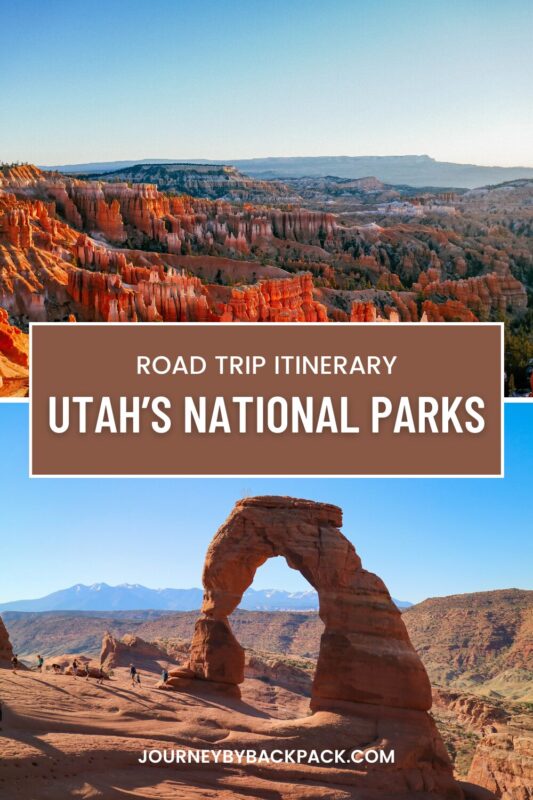
Here’s my 5-day Utah National Parks itinerary from Las Vegas.
When is the best time of year to visit Utah’s National Parks?
Utah’s National Parks are mostly accessible all year round. Having said that, different seasons have their advantages.
Spring and fall are the best times of year to visit Utah. There are fewer crowds and the temperatures aren’t too extreme. You’ll also likely find it’s cheaper to travel in Utah during the spring and fall. I’d recommend the months of April & May and September & October .
It’s worth noting there might be some snowfall during the spring or fall. This could affect hiking trails and roads. I visited Utah in October and there was snow in Bryce Canyon. We could still do all the hikes, but it was slippery to say the least. Oh, and the camping was freezing!
The summer is a popular time to visit and is the peak season in Utah. School is out and families are looking to vacation in the national parks. If you can, I’d avoid the months of July and August . Utah’s National Parks will be crowded and the temperatures have the potential to be too hot to hike.
It’s also possible to visit Utah in the winter. The national parks will be at their quietest between November and March . This may not be the best time to visit if you plan to hike. Utah can see a lot of snowfall and ice meaning the hiking trails are prone to closure in these months. That’s not to say a winter road trip through Utah isn’t possible.
Next up, here’s what to pack for a road trip through Utah .
Utah’s National Parks – The Mighty 5
The five national parks of Utah are known as The Mighty 5. If you’re planning a road trip through Utah, visiting each of the Mighty 5 is the best way to see the true diversity of the Utah landscape.
I’ve shared a brief overview of each of Utah’s Mighty 5 below.
Zion National Park
Zion National Park is one of the most famous national parks in all of the United States. It’s a stunning spectacle of towering sandstone cliffs, narrow slot canyons and lush forested valleys.
Zion is known for several iconic hikes. This includes the notorious Angels Landing, one of the most dangerous hikes in the USA . Another popular hike in Zion is ‘the Narrows’. This renowned track leads hikers between sheer slot canyon walls through the Virgin River. It’s an absolute must-do hike while in Utah.
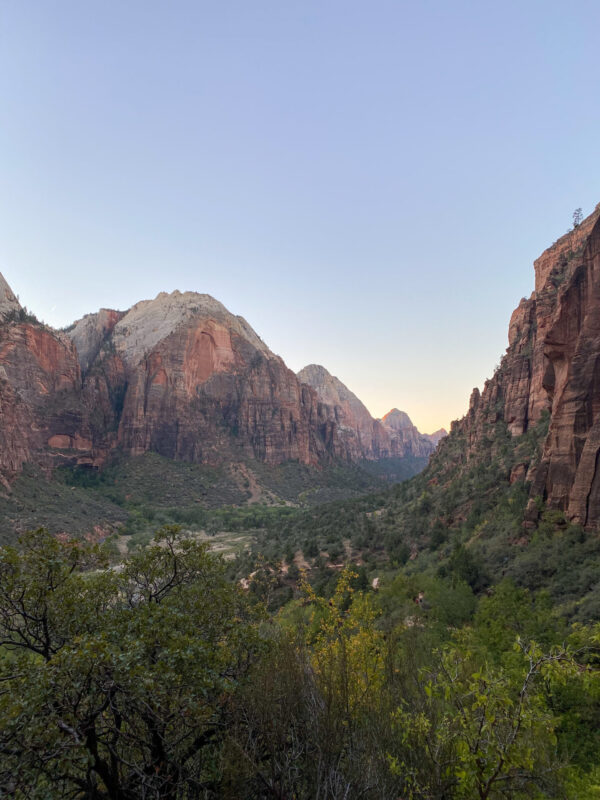
Canyonlands National Park
I had never heard of Canyonlands before my Utah road trip, but wow was I impressed. Canyonlands National Park is the largest national park in Utah. It feels like a never-ending expanse of canyons, rock formations and desert.
Arriving in Canyonlands felt like landing on another planet. The park is split into four distinct areas all open to be explored. The Island in the Sky district is one of the most popular areas of the park offering incredible panoramic views. Another famous district is The Needles, with unusual striking rock spires and colourful canyons. I spent two days exploring these two districts and was constantly blown away by the scenery.
With just five days in Utah, it would be impossible to see all of Canyonlands, but a trip there is still a must.
Bryce Canyon National Park
Bryce Canyon is the smallest of Utah’s Mighty 5 National Parks. Despite its size, Bryce Canyon is still a force when it comes to beauty and adventure.
This geological place of wonder is known for its incredible hoodoos – tall rock spires which have been formed by erosion. The park’s main attraction, the Bryce Amphitheatre, is a surreal landscape filled with hoodoos. I’d highly suggest visiting Bryce for sunrise or sunset where the orange and red rock formations create a stunning display.
Bryce Canyon is also filled with incredible hiking trails. It’s an absolute must on any Utah road trip itinerary.

Arches National Park
This destination is my personal favourite national park in Utah. Arches National Park is in the Red Rock Country of south-eastern Utah. It’s right next door to Moab, the ‘Adventure Capital of The West’.
Arches National Parks boasts an other-worldly landscape. It’s known for its iconic sandstone arches and has the highest concentration in the entire world. In fact, Arches National Park is home to over 2,000 natural stone arches. These geological wonders create a surreal landscape, especially during sunrise and sunset.
There are ample hiking opportunities in Arches National Park . One of my personal favourites is the Devils Garden area. The landscape here is breath-taking.
Arches National Park is a haven for hiking lovers, nature lovers and photography lovers alike.
Capitol Reef National Park
Last, and by no means least, is Capitol Reef National Park. The park is known for the ‘Waterpocket Fold’. A 100-mile-long geological fold in the Earth’s crust. The Waterpocket Fold exposes rock layers, showcasing the geological history of the region over millions of years.
Capitol Reef is also home to petroglyphs – ancient rock carvings. If you’re keen to see the petroglyphs, this will be the easiest spot to see them in this itinerary. The park is also home to Cassidy Arch, an impressive natural bridge which you can visit.

Black Arch Lookout
5-Day Utah National Parks Itinerary from Las Vegas
The below itinerary is a suggested 5-day road trip through Utah’s Mighty 5 National Parks from Las Vegas. This itinerary starts and ends in Las Vegas.
I’m going to be honest, 5 days is not enough time to see absolutely everything, but it’s enough time to try. If you have an extra day or two for your Utah National Parks road trip, I’d suggest adding a day at Canyonlands National Park.
I hope the below helps you to build your perfect Utah road trip itinerary.
Day one: Drive to Moab and visit Canyonlands National Park
Start your day in Las Vegas where you will begin your 5-day road trip through Utah’s National Parks.
Today is an early start and a long drive. The idea is to get a big chunk of the driving done today so you can focus the rest of your 5 days on exploring Utah’s National Parks.
Start as early in the day as possible and head straight to Canyonlands National Park . It’s going to be at least a 7-hour drive, so try and get on the road early enough to give you the afternoon in the park.
Canyonlands National Park is a HUGE and vast area, and it’s going to be impossible to explore it all in this time frame. I’d personally focus on one area of the park. If you don’t have much time in Canyonlands National Park, focus on the Island in the Sky area or the Needles district.
A good option for a few hours in Canyonlands is the Island in the Sky Scenic Drive . This incredible drive gives you a feel for the true vastness and beauty of this area. At the end of the road, there is a short hiking trail to Grand View Point. You’ll be rewarded with stunning views at every moment on this hike.
Another epic spot on the Island in the Sky Scenic Drive is the White Rim Overlook Trail . This is another fun short hike with some of the best views in the area. This hike is particularly amazing at sunset.
Here are some other things to do in Canyonlands National Park:
- Hike to Mesa Arch : this short hike leads you to the incredible Mesa Arch. It’s known for its epic sunrise views.
- Green River Overlook : this viewpoint boasts some of the best views in all of Canyonlands. It’s a convenient short walk from the parking lot and boasts stunning views of the Green Review. I’d highly recommend this spot for sunset.
- Newspaper Rock Historic Monument : if you’re venturing into the Needles district, stop at this monument to admire the incredible petroglyphs. There are some great hiking trails in this area.
- Chesler Loop Trail : this was one of my favourite hikes in Utah. At 10 miles (16km) it’s no short hike, but the diversity of scenery makes it all worthwhile.
Want to explore more hiking opportunities? Here are some of the best hikes in Canyonlands National Park .
Note : As mentioned above, if you have an extra day for your road trip, I’d consider spending more time at Canyonlands National Park. This is such a huge and diverse national park and there is so much to see here.
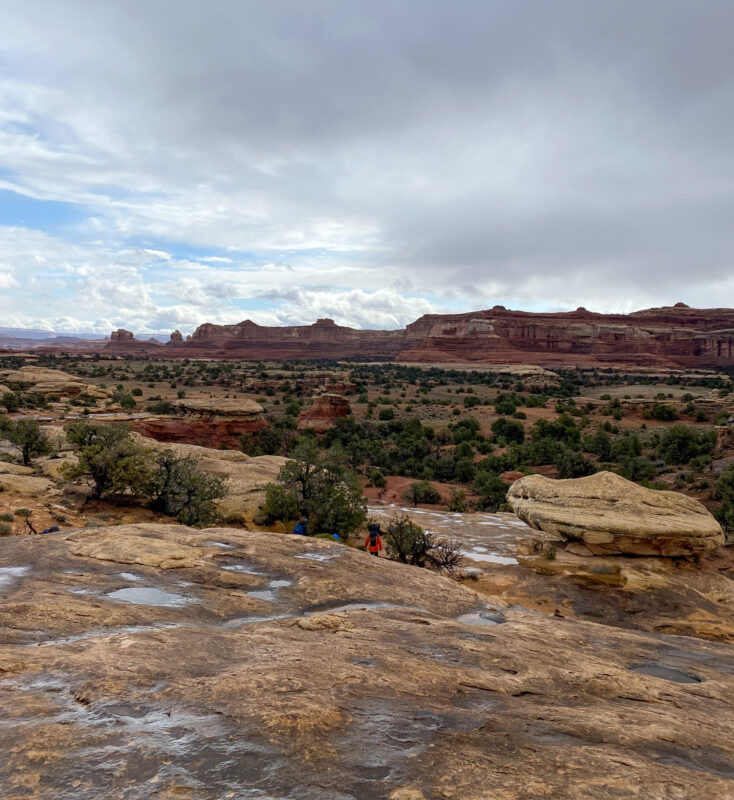
Where to stay in Canyonlands National Park
For night one and night two of your 5-day road trip, I’d suggest basing yourself in the nearby town of Moab . This town is close to both Arches and Canyonlands National Park making it the perfect spot to stay.
The town is also known as the ‘adventure capital of the West’. It’s full of exciting and adrenaline filled activities. There are ample restaurant choices and plenty of accommodation options.
For campsites in Moab, a good option is the Sun Outdoors campsite . This is where I stayed during my two nights camping in Moab. It’s a budget friendly option and is located relatively close to the town.
There are plenty of hotels and motels to choose from in Moab. I’d suggest using booking.com to find the most suitable accommodation. If you’re travelling in the peak season, make sure to book well in advance.
Day two: Arches National Park and Dead Horse State Park
Start the next morning in Arches National Park , just down the road from Moab. This is my favourite of Utah’s ‘Mighty 5’. It’s such a diverse and unusual national park. The scenery is otherworldly and I’ve never seen anything quite like it.
Spending a whole day in Arches is a good amount of time to see the highlights of this park. There are some epic hikes and viewpoints.
Start the day by heading to Delicate Arch for sunrise. Delicate Arch is one of the best places in Arches National Park to catch the sunrise, so you certainly won’t be alone on the trails. The hike is a 5km (3.1 miles) round trip. Unfortunately, it was cloudy on the day I visited for sunrise. It was still worth-it, nonetheless.
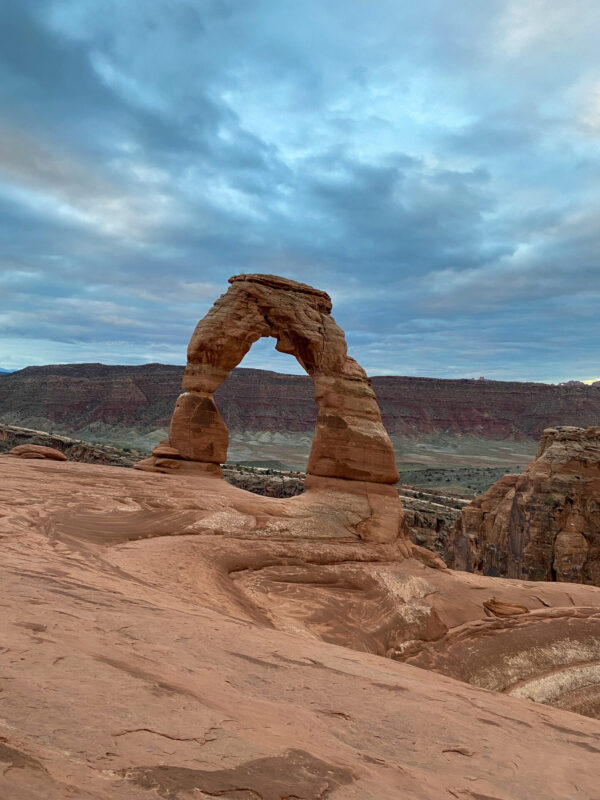
After your hike to Delicate Arch, fill your day by exploring other areas of the park.
Here are some of the top things to do in Arches National Park:
- Hike in Devil’s Garden : if there’s one place to visit in Arches National Park it’s Devil’s Garden. This has to be one of the most beautiful places I’ve ever visited. There’s a range of short hikes as well as longer hikes that allow you to explore this magnificent landscape. While in Devil’s Garden, be sure to hike to Double O Arch. The scenery on route is stunning. The Black Arch Overlook viewpoint is particularly spectacular.
- Drive the Arches Scenic Drive : this popular route connects all the main areas of the park, and you’ll need to drive along it to get to most places. If you’re not a keen hiker, this drive will allow you to see some stunning scenery with zero effort. There are ample viewpoints along the drive. Be sure to check out “Balanced Rock” during the drive.
Note : the Visitor Center in Arches National Park has more information about the park and its history.
I’ve written a whole guide on how to spend a day in Arches National Park .
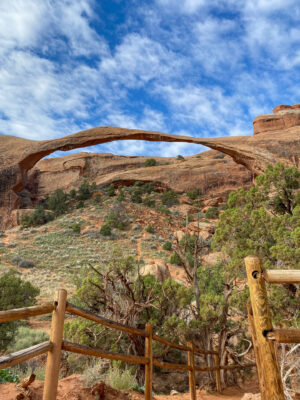
Landscape Arch

Double O Arch
Before heading to your accommodation, consider stopping at Dead Horse Point State Park for sunset. It’s a 30-minute drive (or longer), so a little detour, but wow is it worth it. Dead Horse Point State Park is a huge canyon area overlooking the Colorado River. It gives Grand Canyon vibes and is a great alternative for those who aren’t visiting there.
Head to the Dead Horse Point overlook for the best views at sunset. The park is also an International Dark Sky Reserve. This means it’s an epic spot for stargazing. Stick around after the sun sets to make the most of the night sky.
It would also be possible to visit Dead Horse Point for sunrise on day 3 if this fits better.
Important note : Arches National Park operates on a timed entry system. This means between the months of April and October, all visitors entering the park in a vehicle will need to book their slot in advance. This can be booked on the official website .
Accommodation options for Arches National Park
Arches National Park is only a few miles from Moab. I’d suggest basing yourself in Moab on nights one and two as it will allow you to easily get between Canyonlands and Arches National Parks. It also means you won’t need to move accommodation after day one.
If you’re keen to camp in Arches National Park , you will need to plan well in advance. There is only one campsite in the park. It’s open between March and October.
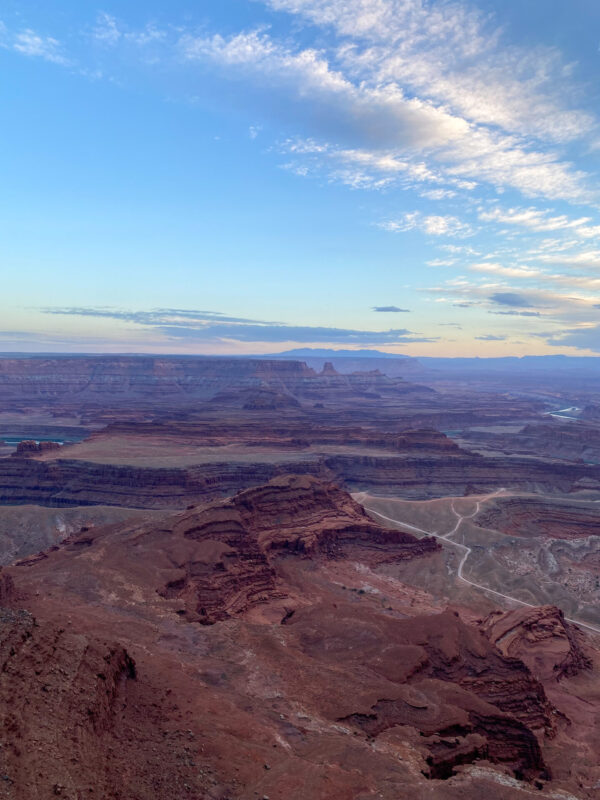
Day three: Drive to Capitol Reef National Park
Day three of your 5-day Utah National Parks road trip from Las Vegas is another packed one. Start your day early and make the 2-hour drive to Capitol Reef National Park .
Capitol Reef is famous for its unique geology, famous petroglyphs, and beautiful orchards. With only 5 days for this road trip, you won’t be able to see everything. However, even with just a few hours you’ll be able to see Capitol Reef’s highlights.
Spend the next few hours exploring this unique area. Here are some of the best things to do in Capitol Reef National Park :
- Hike to Cassidy Arch : if there’s one thing you do in Capitol Reef National Park, make it this. This 3.1 mile (5km) hike takes you through the canyon to the beautiful Cassidy Arch. This is a distinctive feature in the park and you can walk right out onto the arch, making for a stunning photo.
- Visit the Gifford Homestead : don’t leave Capitol Reef without trying a pie from the Gifford Homestead. This famous café is known for its sweet and savoury treats, with the cinnamon rolls and pies a particular favourite. The farmhouse is near the famous orchards so grab a snack and take a stroll through the trees.
- Admire the petroglyphs : Capitol Reef is known for its fascinating red rocks and geology, but it’s also home to some incredible ancient petroglyphs . The rock carvings are thought to have been created between 600 and 1300 AD.
- Capitol Reef Scenic Drive: if you have the time, drive the famous Scenic Road through Capitol Reef. This 7.9mile (12.7km) drive boasts breathtaking scenery. There are several stops along the way including scenic viewpoints and unique rock formations. As of Nov 23, the cost to enter the road in a private vehicle is $20.
Once you’ve finished your day in Capitol Reef National Park, start the 2-hour drive to Bryce Canyon National Park . The reason you’re driving there tonight? To catch the magnificent sunrise in Bryce Canyon the following the morning.
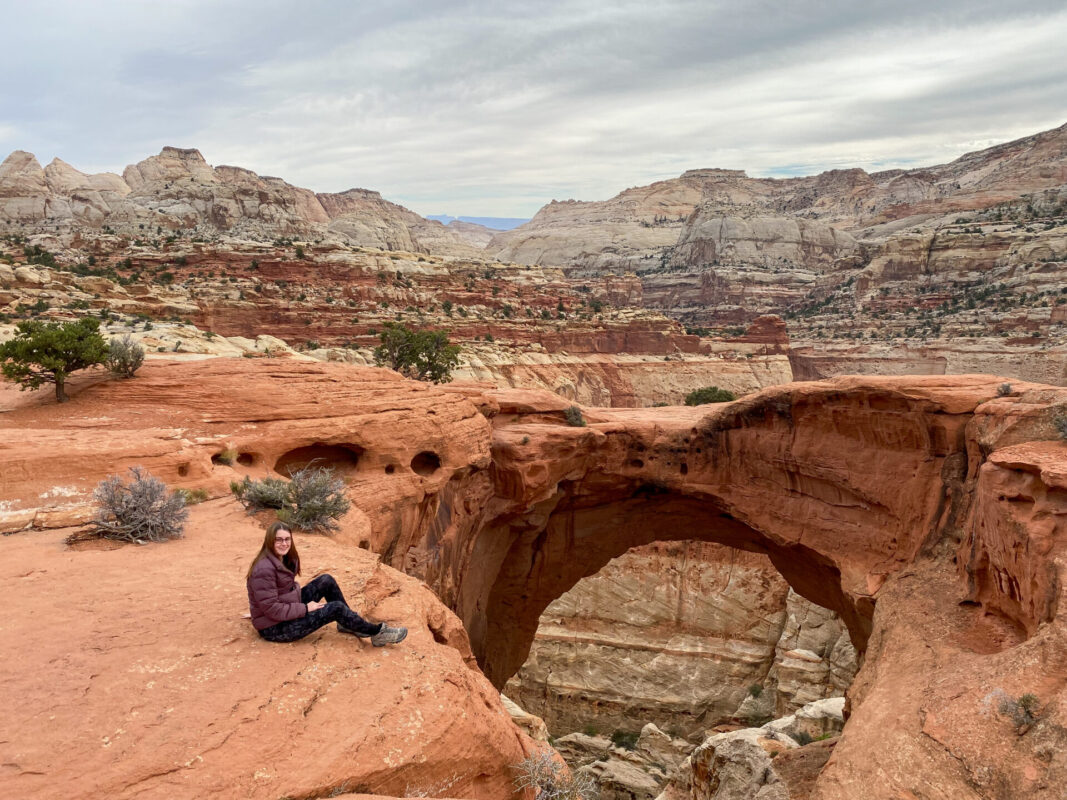
To get from Capitol Reef to Bryce Canyon, you have the option of driving the slightly longer scenic drive on Route 12 . This is known to be one of the most beautiful drives in America. The drive will take you about 2 hours and 30 minutes without stopping, but there are lots of scenic viewpoints on route.
Route 12 is also home to Grand Staircase-Escalante, a National Monument in Utah. I’ve spoken more about this below, but it’s an epic place to stop if you have the time. Realistically, you’ll struggle to fit this into this itinerary without sacrificing something else, but I’ll leave that up to you!
Of course, you can opt to spend the night in the Capitol Reef area instead. However, with only 5 days to see Utah, I’d suggest you keep moving and make the drive to Bryce Canyon on day 3. If you do choose to stay in Capitol Reef, it’s home to some epic, and I mean EPIC , stargazing.
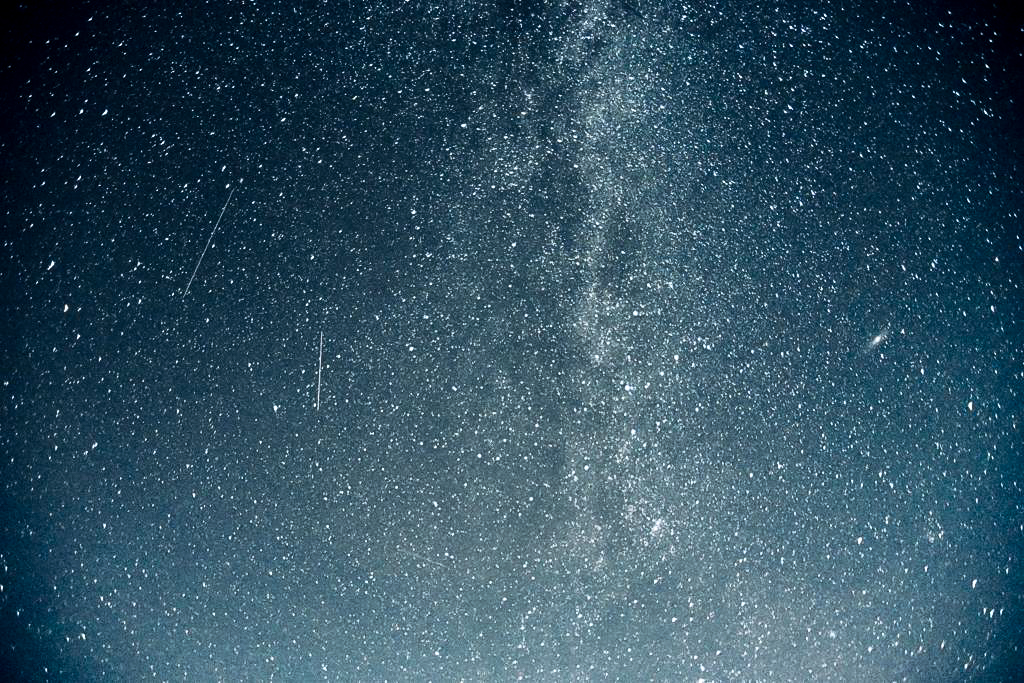
Accommodation options in Bryce Canyon
Seeing the sunrise in Bryce Canyon is a bucketlist activity, so I’d highly suggest staying as close to the park as possible.
For camping , there is the option to camp inside the park at either of the two campgrounds .
The only hotel inside Bryce Canyon National Park is Bryce Canyon Lodge . You’ll need to plan well in advance and it’s not exactly budget friendly, but you’ll be in a prime spot for the next day’s adventures.
Bryce Canyon City is the closest town to the national park and is just a few minutes from the park’s entrance and visitor center. The accommodation here is generally more affordable. The Bryce Canyon Shuttle also picks visitors up from here. There is a grocery store and other facilities.
Day four: Bryce Canyon National Park
Next up is the smallest of Utah’s National Parks – Bryce Canyon . Bryce Canyon is a spectacular spot in southern Utah. It’s known for its collection of hoodoos, tall and narrow rock spires which have been formed through erosion. Bryce Canyon is one of those places where you really have to “pinch yourself”. It’s beautiful beyond words can describe.
Some people only pass through Bryce Canyon on their road trip, but I suggest spending a full day in the park. It’s a truly wondrous place and you want to see as much as you can.
Bryce Canyon is particularly beautiful in the winter months. The viewpoints over the amphitheatre with a snow-covered landscape are breathtaking, especially at sunrise.
Begin your day in Bryce Canyon by catching sunrise over the Amphitheatre . The best spots are Sunrise Point and Sunset Point . There is a convenient parking lot meaning you won’t need to walk far, but get there early to ensure you get a space.
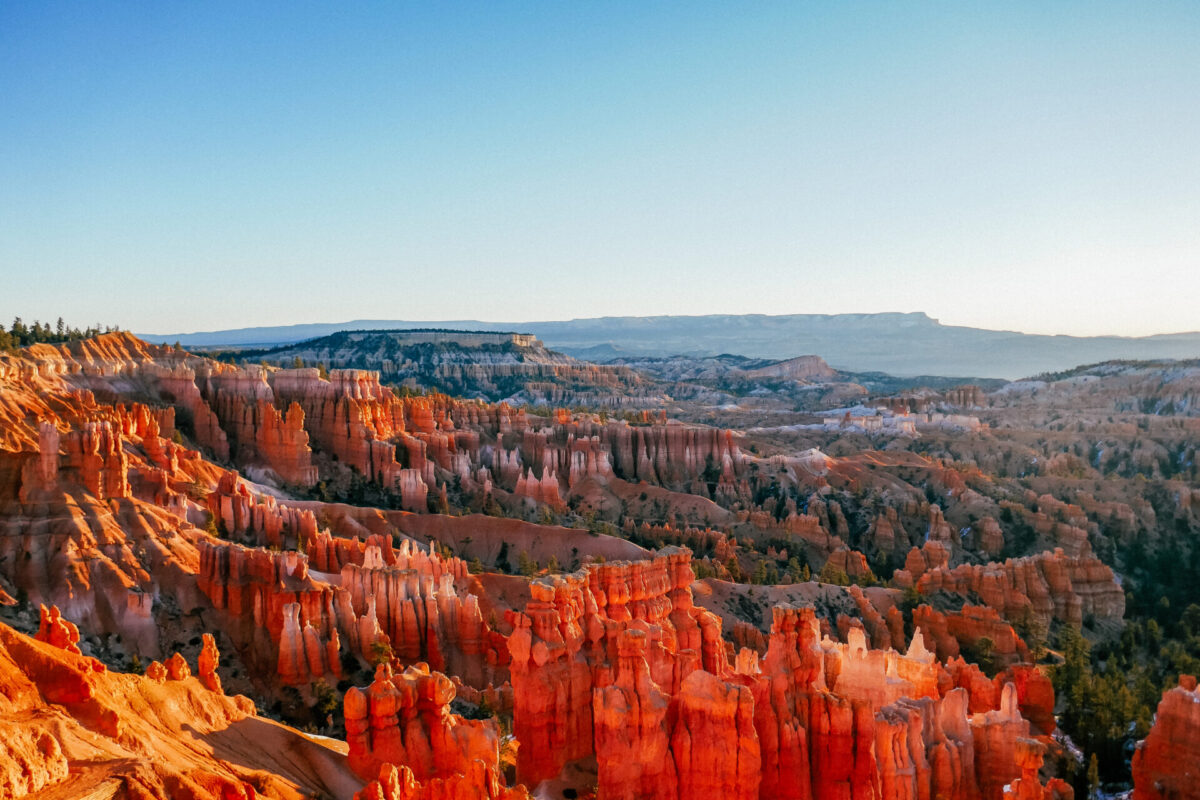
The sunrise I saw in Bryce Canyon is genuinely one of the best sunrises I have ever seen. There was something so magical about watching the sun rise above the horizon and the amphitheatre lighting up gold and red.
Bryce Canyon is a hiker’s paradise and after watching the sunrise, hit the trails to see more of this phenomenal destination.
Here are some of the best hikes in Bryce Canyon:
- Navajo Loop and Queen’s Garden : this is without a doubt one of the best hikes in Utah. The Navajo Loop trail is a 1.5mile (2.4km) trail that takes you down the famous switchbacks known as Wall Street. To see more of the incredible Bryce Amphitheatre, continue your hike on the Queen’s Garden Trail. This will get you up close and personal with those iconic red hoodoos.
- Bryce Point and the Peekaboo Lookout : this 5.2 mile (8.3km) hike can also be linked with the Navajo Loop trail. It’s a great way to walk amongst the hoodoos.
- Rim Trail : if you’re not a keen hiker but want to see more of Bryce, consider a stroll along the Rim Trail. The trail is 5.5miles (9.8km) long but you can walk as much or as little as you like. I’d suggest parking your car in the Sunrise Point Parking Lot and having a stroll from there. It’s a relatively easy hike that all can enjoy.
- Inspiration Point : before leaving Bryce Canyon, make a quick stop at Inspiration Point for more incredible views. This is one of my favourite viewpoints in the park.
I’ve written all about how to spend a day in Bryce Canyon National Park to help you plan your trip.

Wall Street at the Navajo Loop
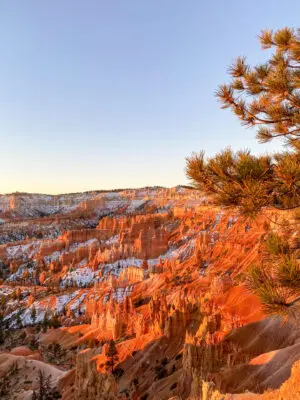
Sunrise in Bryce Canyon
After finishing your day in Bryce Canyon, drive to Zion National Park for the final day of your road trip through Utah’s National Parks. This drive should take you around 2 hours depending on traffic.
Note : you could always drive to Zion in the morning on day five. There’s lots to see in Zion however and if you’re keen to hit the trails, I’d suggest getting there this evening so you can spend a full day in the park.
Accommodation options in Zion National Park
Zion National Park is one of the busiest parks in America, so finding accommodation can be a challenge.
If you want to stay inside Zion National Park, your only option is Zion Lodge . This highly rated hotel is a popular option as it’s conveniently located near several hiking trails.
Zion National Park also has three campsites . I stayed at the Watchman Campground which is very well located. You normally need to book at least six months ahead of time to get a space here.
The nearby towns of Springdale and Cedar City also have ample accommodation options. I recommend using Booking.com to find your accommodation.
Day five: Zion National Park
The final stop of your Utah National Parks road trip is the iconic Zion National Park in Southern Utah. Zion is known for its dramatic red rock landscapes, towering cliffs and narrow slot canyons. Start your day as early as you can as there are so many things to do and see in Zion.
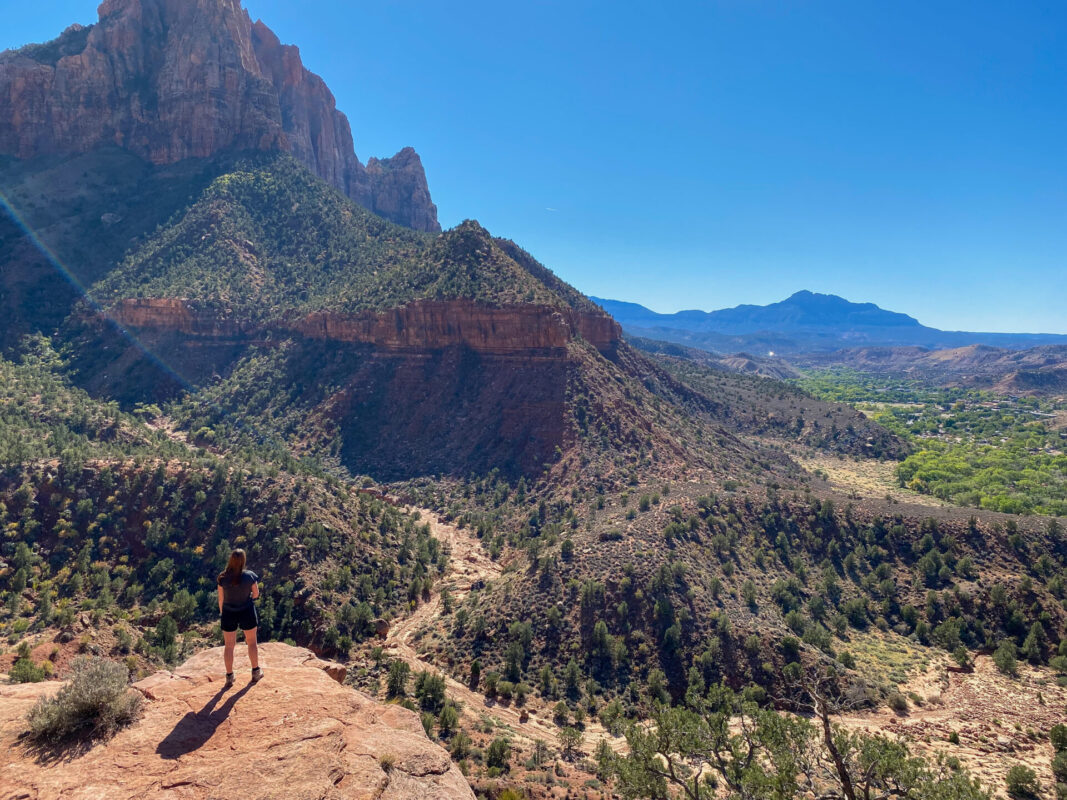
One of the best things to do in Zion is the famous Angels Landing hike. This stunning hike is known to be one of the most dangerous hikes in the United States. With its narrow ridges and steep cliff faces, it’s not for the faint of heart. The hike requires you to ascend nearly 1,500 feet above the canyon floor up a series of switchbacks known as Walter’s Wiggles. Once at the top, start the nerve-wracking walk along the narrow ridge.
At the summit of Angels Landing, you’ll be rewarded with panoramic views of the Zion Canyon, the Virgin River and surrounding red rock landscape. This is without a doubt one of the best hikes in America. Due to its popularity, the National Parks Service recently introduced a permit system . You won’t be able to do this hike without a permit.
Another iconic hike in Zion National Park is ‘ The Narrows ’. This hike takes you through the Virgin River’s narrow slot canyons (hence the name). There really is no other hike like it and it’s an absolute must on your Zion itinerary.
The Narrows hike requires wading and, at times, swimming through the river itself. You can hire equipment for the hike right outside the park.
Here are some other things to do in Zion National Park:
- Emerald Pools hike : the Emerald Pools hike starts at the famous Zion Lodge. There are three different pools: lower, middle and upper. You can walk to just one, or complete the full trail which is a total of 3.1miles (5km). The walk boasts stunning views including waterfalls, panoramic vistas and of course, the pools themselves.
- The Watchman Trail : this is a shorter hike (2.7 miles) but is stunning nonetheless. It’s located near the entrance of the park so is a great option for those with less time. The start of the hike is right by the Visitor Center and the Watchman Campground.
- Ride the shuttle bus : if you’re visiting Zion in the peak season, you’ll need to take the shuttle bus to get around the park. A ride on the shuttle bus is a great way to explore the park with minimal effort. There are incredible views around every corner.
- Stargazing : Zion is known for its epic stargazing. Grab a blanket and admire the night sky, or join a tour to learn more about this wondrous night sky.
Discover more hikes in Zion National Park .

Angels Landing Hike

Important note : private vehicles are not allowed into Zion National Park during the peak season (generally March to November). You’ll need to leave your car in a parking lot and catch the Zion shuttle bus to get around.
After ending your day in Zion, you’ve finished your 5-day road trip through Utah’s National Parks. Head back to Las Vegas or stay an extra night in Zion.
Utah Road Trip: Las Vegas to Salt Lake City Itinerary
Planning a Las Vegas to Salt Lake City road trip? The above itinerary can be adapted to suit that.
Here’s what I would do if I were driving from Las Vegas to Salt Lake City.
Stop one: Zion National Park Start your road trip from Las Vegas to Salt Lake City by visiting Zion National Park.
Stop two: Bryce Canyon National Park Next up, spend a day exploring Bryce Canyon. Be sure to catch one of the iconic sunrises.
Stop three: Capitol Reef National Park Move on to the stunning Capitol Reef. If you have the time, take Route 12 and make a stop as Grand Staircase-Escalante.
Stop four: Moab The next stop is Moab. Spend a couple of days exploring Canyonlands and Arches National Parks.
Stop five: Salt Lake City Finish your epic road trip from Las Vegas in Utah’s capital, Salt Lake City. Consider visiting the Bonneville Salt Flats to see more of Utah’s diverse landscapes.
Other places to visit on a road trip from Las Vegas
If you have an extra day or some extra time for your road trip, consider one of these additional stops.
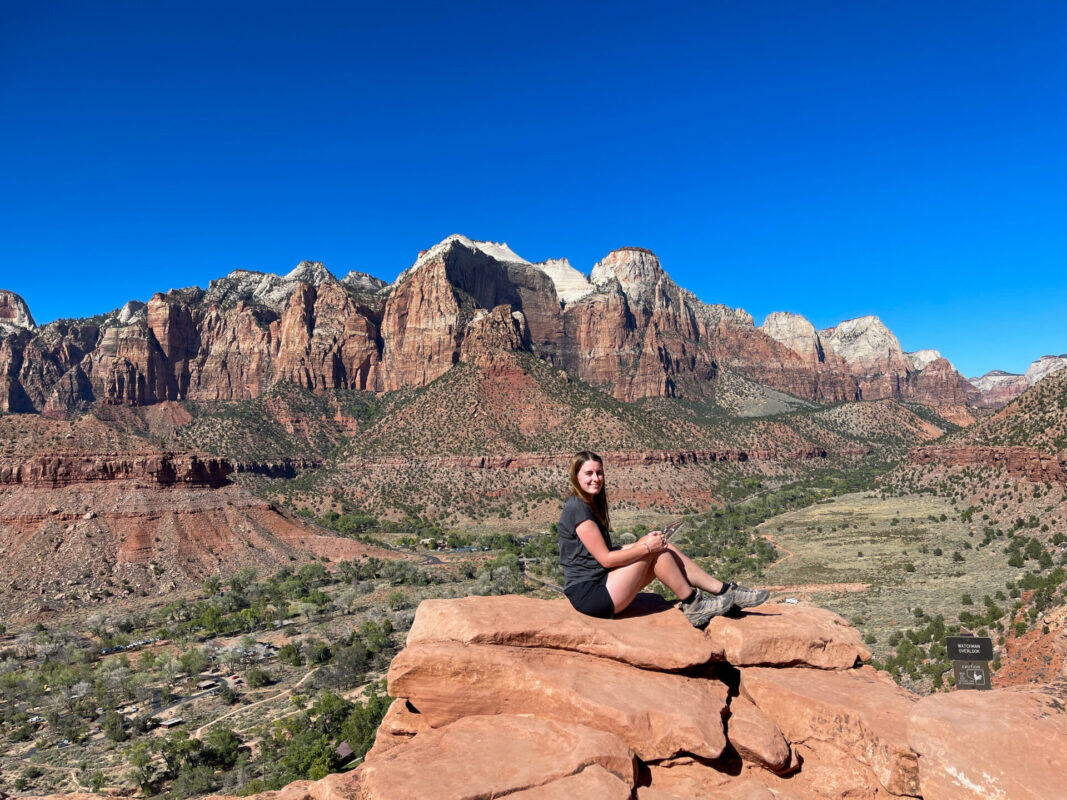
Bonneville Salt Flats (Utah)
The iconic Bonneville Salt Flats are one of Utah’s most iconic and surreal landscapes. The Salt Flats are about 110 miles from Utah’s capital, Salt Lake City. This unique destination features a vast expanse of salt crust, creating an almost otherworldly environment.
This 30,000 acre spot requires some planning to visit, but it’s well worth it.
Grand Staircase-Escalante (Utah)
The Grand Staircase-Escalante is a National Monument in Utah. Although not officially a national Park, a stop at the Grand Staircase-Escalante is a must if you have the time.
The area is home to some incredible hikes and scenery. With waterfalls, canyons, red rock cliffs and narrow slot canyons, Grand Staircase-Escalante is an epic spot on a Utah road trip.
While here, consider hiking to Lower Calf Creek Falls. The track is 6.2 miles (10km) round trip and takes you to a beautiful waterfall. It was one of my favourites hike in Utah. There is also information about the area on route.
The National Monument can easily be added to any Utah itinerary. The park is located on Route 12 between Capitol Reef and Bryce Canyon.
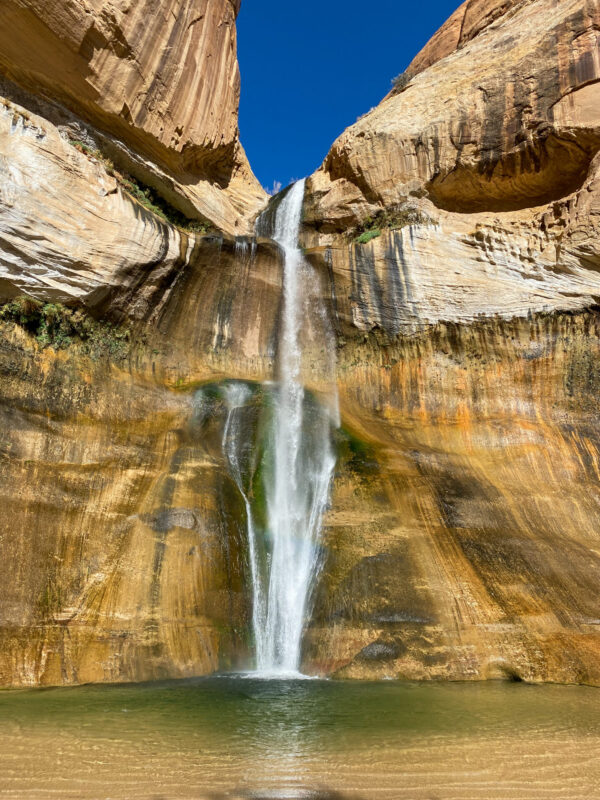
Red Canyon (Utah)
Southern Utah is home to Red Canyon, an incredible display of hoodoos, spires and cliffs. Red Canyon is often overlooked by the nearby Bryce Canyon, but it’s worth visiting if you have the time.
It’s right in the heart of Dixie National Forest with ample hiking trails. Red Canyon can be found between Bryce Canyon and Zion National Parks.
Valley of Fire State Park (Nevada)
Less than an hour from Las Vegas is the Valley of Fire State Park. If seeing petroglyphs is high on your list, then you’re in luck. The petroglyphs here are estimated to be around 2000 years old. The park is also home to the iconic Fire Wave, a vibrant sandstone rock formation.
Thinking of visiting Valley of Fire State Park. Here’s everything you need to know .
Hoover Dam (Nevada)
The Hoover Dam is an engineering marvel which spans the border between Arizona and Nevada. It’s a bit of a detour from Utah to reach here, but if you have the time I’d highly recommend it. The scale of the Hoover Dam is mind-boggling. You can walk across the Hoover Dam or opt to join a guided tour .
The Grand Canyon (Arizona)
The Grand Canyon is one of the world’s most recognisable natural landmarks. This huge canyon is a whopping 1.217 million acres. It’s possible to visit the Grand Canyon as part of a Utah road trip. I’d add this in as your first stop out of Las Vegas (or last stop when returning).
Want to see more of Arizona including the famous Monument Valley or Horseshoe Bend? Consider a road trip through Arizona .
Did you find this 5-day itinerary for Utah’s National Parks from Las Vegas helpful? Share on social media below or save for later.
OTHER UTAH POSTS
Have you checked out my other Utah themed posts to help you plan the ultimate road trip?
One Day in Arches National Park: The Perfect Itinerary
How to Spend One Day in Bryce Canyon National Park
Ultimate Packing List for Visiting Utah’s National Parks
Related Posts

Complete 7 Day Iceland Itinerary: THREE Different Road Trip Ideas

The Ultimate 7 Day Malaysia Itinerary – 5 Different Ideas
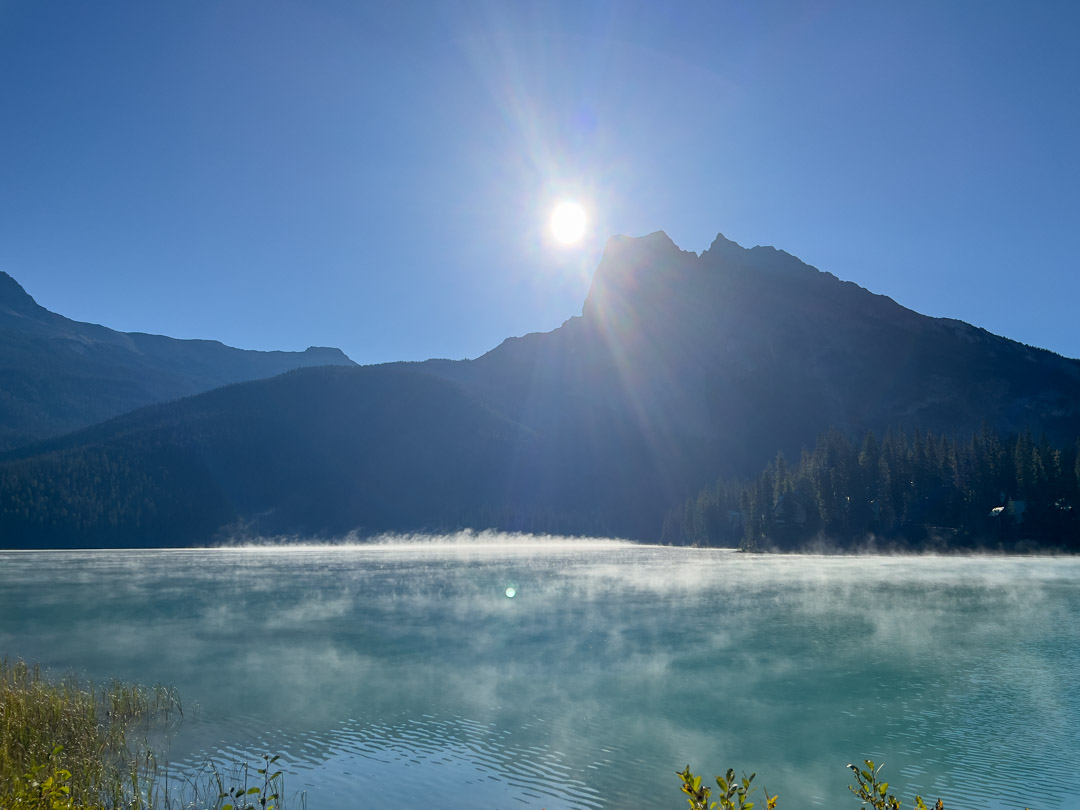
How to Spend One Day in Yoho National Park (& Things To Do)
Travel With Me 24 X 7
Travel itinerary, Travel guide and Destination reviews
12 Best National Parks Near Las Vegas – Road Trip Route, Things To Do & Campgrounds
In this article, you can read about a list of national parks near Las Vegas(Road trips from Las Vegas to National parks) with details of distance, suggested routes, commuting time, and things to do.
👉🏼12 Romantic Day Trips From Las Vegas – Best Romantic Getaways Near Las Vegas, Things To Do, Route

There are many stunning national parks around Las Vegas, and protected areas are within reasonable driving distance; hence, they are recommended to visit during your visit to Las Vegas. Here’s a list with approximate distances, recommended routes, commuting times, and highlights.
👉🏻7 Best National Parks Near San Francisco, Northern California + Route, Campgrounds & Things To Do
National Parks Near Las Vegas – Road Trips From Las Vegas To National Parks
Planning road trips from Las Vegas to national parks(National parks near Vegas) unveils a scenic journey through captivating desert vistas, towering red rock formations, and natural wonders, making for a memorable and enriching travel experience.


Grand Canyon National Park (West Rim)
Distance from Las Vegas : About 130 miles southeast of Las Vegas
Route: Take US-93 S and then follow signs to Grand Canyon West
Commuting Time: Approximately 2 hours
Things to do: Skywalk, helicopter tours, scenic views of the Grand Canyon & Colorado River, Hike to Guano Point & Eagle Point, boat ride on the Colorado River, Visit the Hualapai Ranch for a taste of the Old West, ziplining and stargazing.
Scenic Stopovers – Spring Mountain Ranch State Park, Lake Mead National Recreation Area, Hoover Dam, Historic Route 66 in Kingman, Hackberry General Store, and the Hualapai Ranch
Campgrounds – Grand Canyon Caverns RV Park or Hualapai Lodge.
Best Hotel Stay – Grand Canyon Western Ranch
The Grand Canyon National Park West Rim is one of the most famous National Parks Near Vegas. It is worth visiting for its iconic Skywalk, which offers a thrilling glass-bottomed bridge experience, and its unique cultural immersion with the Hualapai Tribe, which provides a distinct perspective on the Grand Canyon’s awe-inspiring beauty.
The combination of natural wonders and cultural encounters makes it a must-visit National Parks Close To Las Vegas.
Death Valley National Park – National Parks Close To Las Vegas
Distance from Las Vegas: About 120 miles northwest of Las Vegas (Furnace Creek Visitor Center)
Route: Take US-95 N and then follow signs to Death Valley
Commuting Time : Approximately 2 hours
Things to do : Badwater Basin, Zabriskie Point, Dante’s View, Artist’s Palette. The most scenic route is from Lone Pine to Furnace Creek
Campgrounds – Furnace Creek Campground , Sunset Campground, Texas Springs Campground, Mesquite Spring Campground, Emigrant Campground , Wildrose Campground, Thorndike Campground and Mahogany Flat Campground.
Best Hotel Stay – Stovepipe Wells Village Hotel , Longstreet Inn, Casino, and RV Resort (Amargosa Valley) , or Saddle West Hotel, Casino & RV Park (Pahrump).
Death Valley National Park is worth visiting for its surreal and diverse landscapes, featuring the lowest point in North America, Badwater Basin, and breathtaking sights like Zabriskie Point, offering a unique and otherworldly experience near Las Vegas. The park’s extreme beauty and geological wonders make it a compelling destination for nature enthusiasts.
Great Basin National Park
Distance from Las Vegas: Approximately 300 miles north
Route: Take US-93 N and then follow signs to the park
Commuting Time: Around 4.5 to 5 hours
Things to do: Lehman Caves tour, Wheeler Peak Scenic Drive, stargazing (designated Dark Sky Park), Bristlecone Trail, Glacier Trail, and Wheeler Peak Summit Trail.
Campgrounds – Wheeler Peak Campground, Lower Lehman Creek Campground, Upper Lehman Creek Campground, or Baker Creek Campground.
Best Hotel Stay – Border Inn Casino, Baker , Hidden Canyon Retreat (Baker, NV), Hotel Nevada & Gambling Hall (Ely, NV) or Prospector Hotel and Casino (Ely , NV).

Great Basin National Park is worth visiting for its stunning Lehman Caves, an underground marvel, and the opportunity to experience pristine alpine environments, including the iconic Wheeler Peak, offering a distinct and less-explored natural beauty near Las Vegas. The park’s unique combination of underground wonders and high-altitude landscapes makes it a compelling destination for diverse outdoor experiences.
👉🏼10 Best Road Trips In Nevada With Scenic Stopovers, Overnight Hotels & Things To Do
Cedar Breaks National Monument
Distance from Las Vegas: About 200 miles northeast
Route: Take I-15 N and then follow signs to the monument
Commuting Time: Approximately 3 hours
Things to do: Scenic overlooks, hiking trails, wildflower displays in summer
Campgrounds – Point Supreme Campground
Best Hotel Stay – Cedar Breaks Lodge (Brian Head , UT), Grand Lodge at Brian Head (Brian Head, UT), Best Western Town & Country Inn (Cedar City, UT), or Abbey Inn (Cedar City , UT).

Cedar Breaks National Monument is worth visiting for its breathtaking amphitheater filled with vibrant, multi-colored hoodoos resembling a miniature Bryce Canyon. It offers a unique and visually stunning geological spectacle near Las Vegas. The monument’s natural beauty and distinct rock formations make it a captivating stop for those seeking striking landscapes.
Zion National Park
Distance from Las Vegas: Approximately 160 miles northeast
Route: Take I-15 N, then follow signs to the park
Commuting Time: Around 2.5 to 3 hours
Things to do: Hiking (Angels Landing, The Narrows), scenic drives, wildlife viewing
Campgrounds – Watchman Campground, Lava Point Campground, South Campground near Virgin River.
Best Hotel Stay – SpringHill Suites by Marriott Springdale Zion National Park , Driftwood Lodge , or Desert Pearl Inn .

Zion National Park is worth visiting for its towering sandstone cliffs, majestic slot canyons like The Narrows, and scenic beauty along the Virgin River, providing an unparalleled and awe-inspiring natural playground near Las Vegas. The park’s diverse landscapes, iconic hikes, and stunning vistas make it a must-visit destination for outdoor enthusiasts.
👉🏼12 Best Utah Road Trips – Scenic Drives In Utah With Stops
Bryce Canyon National Park
Distance from Las Vegas: About 260 miles northeast
Commuting Time: Approximately 4 hours
Things to do: Hiking (Navajo Loop, Queens Garden), Bryce Amphitheater viewpoints
Campgrounds – Sunset Campground, North Campground, or Sunrise Campground.
Best Hotel Stay – Best Western Plus Bryce Canyon Grand Hotel , Ruby’s Inn , or Bryce View Lodge .

Bryce Canyon National Park is worth visiting for its enchanting hoodoos, intricate rock formations, and the otherworldly Bryce Amphitheater, offering a visually captivating and unique geological landscape near Las Vegas. The park’s stunning vistas and exceptional hiking trails make it a compelling destination for those seeking a surreal and memorable outdoor experience.
Capitol Reef National Park
Distance from Las Vegas: Approximately 340 miles northeast
Route: Take I-15 N and then follow signs to the park
Commuting Time: Around 5 to 5.5 hours
Things to do: Scenic Drive, Capitol Gorge Trail, petroglyphs at Hickman Bridge
Campgrounds – Fruita Campground, Cathedral Valley Campground, or Cedar Mesa Campground.
Best Hotel Stay – The Snuggle Inn , Red Sands Hotel , or Capitol Reef Resort .

Capitol Reef National Park is worth visiting for its mesmerizing Waterpocket Fold, ancient petroglyphs, and scenic drives along Capitol Gorge, providing a lesser-known yet magnificent natural wonder near Las Vegas. The park’s unique geological features and solitude make it a captivating destination for those seeking off-the-beaten-path adventures.
👉🏼LA To Las Vegas Road Trip Itinerary – Best 8 Routes, Scenic Stopovers & Stays
Joshua Tree National Park
Distance from Las Vegas: About 200 miles southwest
Route: Take I-15 S and then I-215 S, continue on I-15 S, and then take CA-62 W
Commuting Time: Approximately 3 to 3.5 hours
Things to do : Hiking, rock climbing, stargazing, Joshua Tree forest exploration
Campgrounds – Belle Campground, Jumbo Rocks Campground, Black Rock Campground or Indian Cove Campground.
Best Hotel Stay – Sacred Sands Hotel and Spa , Holiday Inn Express & Suites Twentynine Palms- Joshua Tree , or Harmony Motel .

For its iconic Joshua Tree forests, surreal rock formations, and unparalleled stargazing opportunities, Joshua Tree National Park is worth visiting. It offers a mesmerizing blend of unique desert landscapes and celestial wonders near Las Vegas. The park’s distinctive flora and diverse geological features make it a captivating destination for nature lovers and astronomy enthusiasts.
Mojave National Preserve
Distance from Las Vegas : Approximately 60 miles southwest
Route: Take I-15 S and then follow signs to the preserve
Commuting Time : Around 1 hour
Things to do : Kelso Dunes, Hole-in-the-Wall, Joshua trees, scenic drives
Campgrounds – Hole-in-the-Wall Campground, Mid Hills Campground, or Kelso Dunes Campground.
Best Hotel Stay – Primm Valley Resort(Primm, NV) & Casino or Wills Fargo Motel (Baker, CA).

Mojave National Preserve is worth visiting for its vast and pristine desert landscapes, including the mesmerizing Kelso Dunes and the unique Joshua Tree forests, providing a serene, off-the-beaten-path escape near Las Vegas. The preserve’s solitude, diverse ecosystems, and historical sites make it an appealing destination for those seeking tranquility and natural wonders.
Red Rock Canyon National Conservation Area – National Parks Close To Las Vegas
Distance from Las Vegas: About 17 miles west of the Las Vegas Strip
Route: Take W Charleston Blvd/W Blue Diamond Rd
Commuting Time: Approximately 30 minutes

Things to do In Red Rock Canyon
- Take a 13 miles scenic drive throughout the park along the scenic loop.
- Explore Calico Basin and Red Springs Picnic Area
- Go for Calico Tanks Trail, the most beautiful trail here.
- Hike to Calico Hills for stunning views from the top.
- Explore Lost Creek – the stunning waterfall of the Red Rock region.
- Do not miss to spot Petroglyph Wall, which displays ancient rock art throughout the entire park and is the unique part of this park.
- Vehicle Entry fees – 15$ per car or truck and 5$ per bike
Red Rock Canyon’s opening hours – 6 A.M. to 7 P.M.
👉🏼Las Vegas To Red Rock Canyon – Perfect Day Trip
Campgrounds – Red Rock Canyon Campground (Spring Mountain Ranch State Park) or BLM Land Dispersed Camping.
Best Hotel Stay – Red Rock Casino Resort & Spa or La Quinta Inn & Suites Las Vegas Red Rock.

Red Rock Canyon National Conservation Area is worth visiting for its stunning crimson rock formations, scenic hiking trails, and scenic loop drive. It offers a quick and accessible nature escape just outside Las Vegas. The area’s vibrant geology and outdoor activities make it an ideal destination for a day of exploration and natural beauty.
Valley Of Fire State Park – National Parks Around Las Vegas
Distance from Las Vegas : Around 55 miles northeast of Las Vegas
Commuting Time: About 1 hour

Things to do At Valley Of Fire State Park
- Arched Rock
- Balanced Rock
- Atlatl Rock
- Clark memorial
- Elephant Rock
- Fire Canyon – Silica Dome
- Petrified Logs
- Rainbow Vista
- Seven Sisters
- White Domes
Campgrounds – Seven Sisters Campground, Arch Rock Campground, or Atlatl Rock Campground.
Best Hotel Stay – Stay in Overton or Mesquite.

Valley of Fire State Park is worth visiting for its breathtaking red sandstone formations, ancient petroglyphs, and unique Fire Wave rock formations, providing a captivating and otherworldly desert landscape near Las Vegas. The park’s vibrant colors, hiking opportunities, and cultural significance make it a must-see destination for those seeking striking natural wonders.
Lake Mead National Recreation Area – National Parks Near Vegas
Distance from Las Vegas : Varies (Hoover Dam is a popular entry point)
Route: Take US-93 S or I-515 S to Hoover Dam

Commuting Time: Approximately 45 minutes to Hoover Dam
Things to do
- Lake Mead Cruise
- The Northshore Drive
- Hoover Dam. Click here to book ATV TOUR OF Lake Mead and Colorado river .
- Redstone Hiking Trail
- River Mountains Loop Bike Trail
- Historic Railroad Trail
Campgrounds – Boulder Beach Campground, Callville Bay Campground or Katherine Landing Campground.
Best Hotel Stay – Best Western Hoover Dam Hotel

Lake Mead National Recreation Area is worth visiting for its expansive reservoir, offering water activities like boating and fishing, complemented by the awe-inspiring Hoover Dam, which provides a diverse and recreational escape just a short drive from Las Vegas. The area’s combination of water recreation, scenic beauty, and historic landmarks makes it a versatile destination for outdoor enthusiasts.
Remember to check the individual park websites for the latest information on park conditions, closures, and entrance fees. Each park offers unique natural beauty and outdoor activities, making for memorable experiences near Las Vegas.
Scenic Stopovers:
- Spring Mountain Ranch State Park: This historic ranch offers guided tours and scenic views along the route to Red Rock Canyon.
- Boulder City: A charming town on the way to Hoover Dam and Lake Mead, with shops, restaurants, and the historic district.
- Mesquite: If traveling to the Grand Canyon West Rim, Mesquite offers a break with golf courses and resorts.
- Pahrump: On the route to Death Valley, Pahrump has wineries and outdoor activities.
Additional Tips:
- Check for any entrance fees or park passes required for each destination.
- Pack sunscreen, hats, and comfortable clothing for the desert conditions.
- Have a sufficient water supply, especially if you plan to engage in outdoor activities.
- Consider visiting during sunrise or sunset for stunning lighting and cooler temperatures.
- Check the seasons and weather conditions of the parks you plan to visit. Summer can be extremely hot, while winter may bring snow to higher elevations. Spring and fall are generally more temperate.
- Make accommodation reservations well in advance, especially if you plan to stay within or near the parks. Popular national parks tend to fill up quickly, especially during peak seasons.
- Verify road conditions, especially if you plan to visit remote areas or during winter. Some roads may be closed due to weather or maintenance.
- Las Vegas is surrounded by several national parks, including the Grand Canyon, Zion, Bryce Canyon, and more. Research each park’s features and choose the ones that align with your interests and preferences.
These destinations offer diverse landscapes, from colorful canyons to expansive deserts, providing various outdoor activities and breathtaking scenery.

Visiting national parks near Las Vegas offers a breathtaking escape into diverse landscapes, from the iconic Grand Canyon to the otherworldly beauty of Zion and Bryce Canyon, providing unparalleled outdoor adventure and exploration opportunities.
Picture Courtesy – CanvaPro
Follow more on social media channels at
Facebook Twitter Instagram Pinterest
All content and photos belong to travelwithme247blog(dot)com and use of content/photos without permission would result in legal action.
DISCLAIMER – The blog’s content is solely my views of a place or a thing. This does not offend any class, religion, ethnicity, or nation. My views can change from time to time. This blog may contain some advertisements or links to commercial products, so this site is not responsible after you click on those advertisements.
We are the independent owner of this site, and the views expressed in this are our own. I own all photographs. There can be slight differences in distances, locations, or some details for which I (owner) am not responsible. This post may contain some affiliate links, which means at no additional cost to you. I will earn if you will click through affiliates and make a purchase.
Share this:
- Click to share on Telegram (Opens in new window)
- Click to share on Reddit (Opens in new window)
- Click to share on Twitter (Opens in new window)
- Click to share on WhatsApp (Opens in new window)
- Click to email a link to a friend (Opens in new window)
- Click to share on LinkedIn (Opens in new window)
- Click to print (Opens in new window)
- Click to share on Facebook (Opens in new window)
- Click to share on Flipboard (Opens in new window)
- Click to share on Pinterest (Opens in new window)
Leave a Reply Cancel reply
This site uses Akismet to reduce spam. Learn how your comment data is processed .
Discover more from Travel With Me 24 X 7
Subscribe now to keep reading and get access to the full archive.
Type your email…
Continue reading

8 National Park Tours from Las Vegas
Las Vegas has been coined the entertainment capital of the world, but with all the splendor within the city limits, the area surrounding Las Vegas is among the most beautiful in the American Southwest. Several major national parks are within a reasonable drive from Las Vegas, and there are great national parks tours from Vegas that offer a welcome reprieve from the city life.
All you need to enjoy these tours to world-famous destinations is an adventurous spirit and some free time during your stay in Vegas. Whether you’re looking for a half-day getaway with lots of sightseeing stops or overnight stays in a painted desert, there’s a national parks tour from Las Vegas that’s perfect for you.
National Parks and Natural Wonders Near Las Vegas
Las Vegas is one of those rare destinations that appeal to both people who love the crazy city life and nightlife scene, along with other travelers who like the idea of being so close to many of the most famous parks on the national register. Whether you’re just visiting Las Vegas or are proud to call yourself a local, there’s a world of wonder and national parks right outside the door.
Of course, we’re speaking relatively here when we talk about these parks being close to Las Vegas. Certainly, they’re not a mere half-mile outside the city limits, but if you have a day (or even two) to explore, there are lots of national parks and nature areas that are a reasonable one to five-hour drive from Las Vegas.
Some of the most famous national parks and natural scenic areas within a half days drive from Las Vegas include:
- Grand Canyon & the Colorado River
- Bryce Canyon
- Zion National Park
- Hoover Dam & Lake Mead
- Valley of Fire
- Death Valley
- Joshua Tree
- Red Rock Canyon
- Lake Powell
- Monument Valley
- Antelope Canyon
If you have a little more time on your hands and are interested in an adventure that spans several days, there are tours from Las Vegas that will also take you to Grand Teton National Park, Yellowstone National Park, and Canyonlands National Park. These adventures may include a helicopter tour, airplane transportation, or motorcoach with an experienced bus driver and tour director who will narrate the journey as you travel through many scenic areas.
For now, we’ve selected eight top national parks tours from Las Vegas. In full disclosure, not all of these are true national parks, but they are national scenic areas, which we think are worthy of any travel bucket list.
Bryce Canyon National Park Tours
Bryce Canyon and Zion National Parks Small-Group Tour from Las Vegas by Coexist West Coast Tours

Located about four hours outside of Las Vegas in southern Utah is one of the most beautiful national parks in the world. If you make your way to Bryce Canyon City, you’ll find yourself at the entrance of Bryce Canyon National Park.
Bryce Canyon is known for the hoodoos, which are tall irregular columns of rock. Hoodoos are found all over the world, but the largest collection of them on earth can be found at Bryce Canyon. Bryce Canyon is open and filled with spectacular sights year-round.
Bryce Canyon and Zion National Park are close enough that you’ll often find “twofers” when it comes to day trips to either of these parks. This small-group tour to Bryce Canyon National Park that also includes a trip to Zion is one of our favorites.
Bryce Canyon National Park is the first stop on this tour. After departing from your hotel in Las Vegas, you’ll arrive at Bryce Canyon at about 11 am. You’ll spend some time exploring the multi-hued hoodoos and learn about the history and unique geological formations from an experienced tour guide.
You’ll have the chance to explore and hike through parts of Bryce Canyon. Then after a couple of hours, you’ll stop for lunch to refuel. Then, it’s off to Zion National Park. You’ll arrive at Zion Canyon around 4 pm, where you’ll hike along paths and see the massive sandstone formations up close. You’ll enjoy the canyon’s evening colors before heading back to Las Vegas.
Las Vegas hotel pick-up and drop-off are included. Admission into both national parks, bottled water, and lunch is also included in the price of this tour.
Zion National Park Tours
Private Day Tour to Zion National Park From Las Vegas by Detours American West

Zion National Park is located in southern Utah and is about 2.5 hours from Las Vegas. Zion National Park is a beautiful nature preserve with steep cliffs, beautifully colored rocks, and endless scenic routes.
Zion is Utah’s first national park. Sandstone cliffs, slot canyons, and lots of hiking opportunities, There are several types of tours to Zion Canyon from Las Vegas, with many including at least a minimal amount of hiking.
Are you ready to escape the Vegas scene and head out into the sanctuary of Zion National Park? With this tour, you’ll be picked up from your Las Vegas hotel nice and early, then venture off to Zion, where a day of exploration, hiking, and sightseeing awaits you.
Along the way, you’ll travel through the Mojave Desert, historic places that include native lands, the Colorado Plateau, and the Virgin River, before entering Zion National Park with breathtaking views. After lunch, you’ll do a little hiking that includes visiting the emerald pools and beaches of the Virgin River. This is an entire day of raw beauty that’s a must if visiting Zion National Park is on your bucket list.
Grand Canyon National Park Tours
Grand Canyon West Rim Bus Tour by Canyon Tours

Grand Canyon National Park is one of the most famous parks in the United States. Located in Arizona, the Grand Canyon is about five hours or so outside of Las Vegas. The Grand Canyon is a geological treasure trove, with millions of years of history contained within the canyon walls.
The Grand Canyon has many points that offer a spectacular view, and by joining one of the tours from Las Vegas, you’ll have the chance to experience much of it. Since the Grand Canyon is a decent day’s drive from Las Vegas, plan on spending an entire day or even two (or more) for a thorough tour of the canyon.
Las Vegas Grand Canyon National Park tours offer an amazing escape and a chance to witness the unparalleled beauty of the Grand Canyon. Canyon Tours offers an adventure that takes you from the concrete jungle of Las Vegas to the sheer magnificence of the Grand Canyon, all in a single day.
You’ll be escorted from your hotel to Grand Canyon National Park in a comfortable motorcoach that includes a guided, narrated tour. This journey takes you to the Grand Canyon West Rim. You’ll spend four hours exploring the Grand Canyon West Rim and also have the opportunity to visit the Hualapai Indian Lands. This tour also includes the memorable experience of enjoying lunch at the Grand Canyon West Rim, and you can also add on the open-air skywalk experience.
Canyon Tours also offers a similar tour of the Grand Canyon South Rim, which includes a guided tour of the South Rim, a stop at the Grand Canyon National Geographic Visitor Center with IMAX Theater, and lunch at the Grand Canyon Village. West Rim and South Rim tours aren’t combined, but there’s no reason you can’t book two-day tours and see them both!
Valley of Fire National Park Tours
Valley of Fire Hiking and Nature Tour From Las Vegas by Love Hikes

The Valley of Fire State Park is located in Overton, Nevada, and is located about 45 minutes outside of Las Vegas. Named for warmly hued sandstone, the Valley of Fire lights up with brilliant reds and oranges when the sun hits just right.
The Valley of Fire is one of the closest parks to Las Vegas, which makes it a top destination for a day trip away from city life. You can plan a trip to the Valley of Fire during the day and be back on the Strip to experience the bright lights and nightlife of Vegas after dark.
Love Hikes offers a number of Valley of Fire hiking tours from Las Vegas that are far from your ordinary trail experience. These hikes are tailored to your fitness level and ability, with a variety of friendly, moderate, and intense hikes available. The lights of the Las Vegas Strip just can’t compare with the spectacular scenery of the Valley of Fire, especially right before sunset.
This small-group hiking tour offers an interactive experience with a knowledgeable tour guide who will take you off the beaten path so that you can experience some of the hidden gems of the Valley of Fire in person. This tour is a great value and well suited for families and hikers of all abilities. Since this is a hiking tour , the weather conditions may affect tour availability. Transportation to and from your hotel is included, as are bottled water and snacks.
Hoover Dam & Lake Mead National Recreation Area
Hoover Dam Small Group VIP Tour from Las Vegas by Adventure Photo Tours
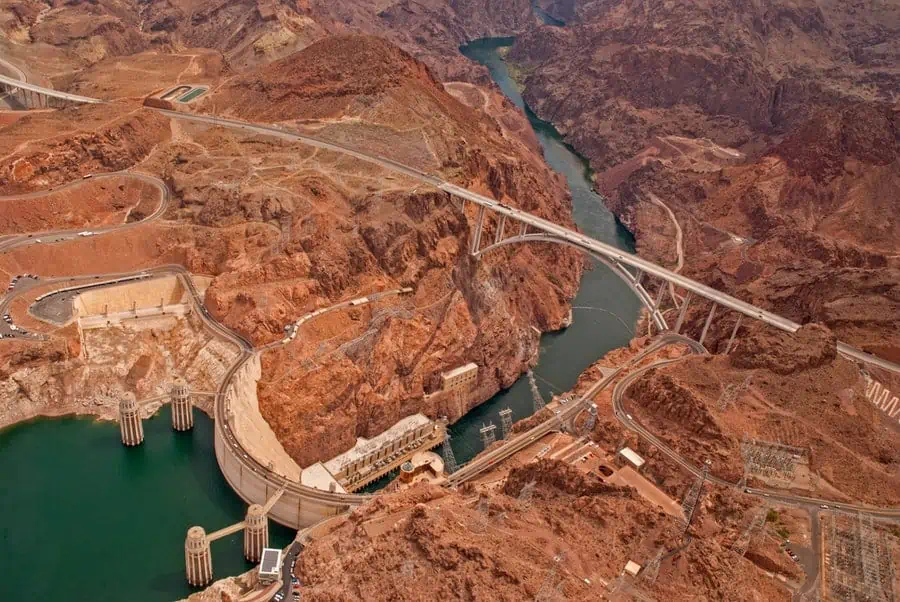
The Hoover Dam stands on the Colorado River in the Black Canyon. Constructed in the 1930s, Hoover Dam still remains a monument of wonder. Nearly a hundred years later, the concrete in the dam is said to still be curing, and tales of its construction are still told today.
At the base of the Hoover Dam is Lake Mead. The lake is the reservoir created by the Hoover Dam. In terms of water capacity, Lake Mead is the largest reservoir in the United States. Lake Mead and the Hoover Dam are located just a little over a half-hour from Las Vegas, making for a fun half-day or full-day excursion.
Buckle up for a road trip to the Hoover Dam that doubles as an educational experience and an opportunity to take tons of great photos. On this tour, you’ll journey to the top of the Hoover Dam with breathtaking views. From the famous overlook, you have the opportunity for an unparalleled view of the Colorado River and Lake Mead.
There is a moderate amount of walking on this tour, but you’re not doing a ton of hiking or strenuous activity, which makes this one of the most popular tours for sightseeing. In addition to visiting the Hoover Dam and Lake Mead, you’ll also stop at a nearby park on the way back to Las Vegas. Here, you’ll see native wildlife, including Big Horn Sheep and possibly a bald eagle or two! This tour includes luxury transportation, entrance fees, bottled water, and snacks.
Death Valley National Park
Death Valley Day Tour From Las Vegas by Bindlestiff Tours

Death Valley has an ominous name, but it’s one of the most gorgeous sights in the southwest. Situated on the border of Nevada and California, Death Valley is about 130 miles from Las Vegas, which equals out to about a two-hour drive.
Death Valley is the hottest and driest national park. It’s also the lowest, sitting below sea level. The Titus Canyon is one of the most famous spots in Death Valley, but no matter where you are, the landscape is nothing short of breathtaking.
Death Valley National Park is one of the most isolated places on earth. It’s also one of the most beautiful. Known for its harsh and extreme climate, Death Valley, with its striking landscape, is a sightseeing lover’s dream. Many people who experience this tour are taken aback by the sheer expansiveness of Death Valley, especially with stops at some of the valley’s most scenic viewpoints.
You’ll travel to the heart of Death Valley, which includes stops at Dante’s View, Zabriskie Point, Artist’s Palled, and the Bad Water Basin, which is the lowest land point below sea level in the western hemisphere. Of course, there’s also a stop at the Death Valley gift shop. You can enjoy all of this and still be back in Las Vegas in time to enjoy the vibrant nightlife. Air-conditioned luxury transportation takes you to and from Death Valley, which means this tour is able to operate year-round.
Joshua Tree National Park
Joshua Tree, Grand Canyon West Rim w/Optional Skywalk Tour by Desert Wonder Tours

Joshua Tree National Park, located in southern California, is a protected natural area that’s characterized by a gorgeous landscape filled with Joshua trees, rugged rocks, and the vast desert. Located a little over three hours from Las Vegas, Joshua Tree National Park borders the Mojave Desert, and if you happen to visit at night, it is one of the most spectacular spots in the United States for viewing a starry sky.
Unlike other tours on our list, Desert Wonder Tours doesn’t operate out of Las Vegas, but they do offer a Las Vegas pick-up option for this incredible tour that takes you not only to Joshua Tree but also the Grand Canyon National Park West Rim. Talk about doubling down on the scenic views!
This tour that takes you through the Joshua Tree forest is perfect for small groups. You’ll have the chance to not only see the famous Joshua Trees but also the amazing wildlife that fills the national park. This adventure includes a guided tour of the Grand Canyon West Rim, with optional activities available, including experiencing the Grand Canyon Skywalk.
The departure date and time for this tour may vary by location of pickup, and group size is limited to eight people.
Red Rock Canyon Tours
Hiking Red Rock Canyon Guided Tour by Escape Adventures

Red Rock Canyon is Nevada’s first national conservation area. Located about 17 miles from Las Vegas, this is one of the most popular destinations for tours from Sin City. Red Rock Canyon offers a day full of hiking, horseback riding, or taking it easy and driving along the 13 miles of the scenic road.
Grab your hiking boots and leave your nightclub attire at the hotel because you’re about to head out for one of the best hiking adventure tours from Las Vegas. This half-day hiking tour of the Red Rock Canyon is offered in multiple skill and experience levels and is the perfect way to spend some free time on a sunny afternoon in Nevada.
An experienced tour guide leads you along paths, foothills, and even some scrambles if you’re up for it. A half-day tour is available for two people, but if you’re feeling really adventurous and have a group of at least four people, you can also sign up for the full-day hiking adventure.
How far are national parks from Las Vegas?
The closest natural area to Las Vegas is Red Rock Canyon, which is only about 17 miles from the city. Many other national parks are within one hundred to three hundred miles of Las Vegas, including the Grand Canyon, Bryce Canyon, Death Valley, and Zion National Park.
How many national parks are near Las Vegas?
There are a total of thirteen national parks that are within a reasonable drive from Las vegas. These include Death Valley, Zion National Park, Bryce Canyon, the Grand Canyon, Joshua Tree, the Great Basin National Park, Arches National Park, and several others.
How far is Zion and Bryce Canyon from Las Vegas?
Zion National Park is about a 2.5-hour drive from Las Vegas, while it takes about four hours to drive to Bryce Canyon. Many Las Vegas tours combine both of these parks into a single full-day adventure.
Are you ready to escape city life and spend some time enjoying the beauty and scenery of the national parks and national scenic areas of the southwest? Las Vegas makes a great starting point, with tours operating daily – many offering transportation to and from your Las Vegas hotel.
Whether you’re looking for a quick day trip or want to spend a night or two exploring the scenic wonders of the southwest, there’s a national parks tour from Las Vegas for everyone!
Considering flying to Las Vegas for a few days and taking some day tours of the National Parks, especially Death Valley and Joshua State Park. I am interested in the month of March 2024. I will be working through a travel agent after I find what I wanted. What can you offer me?
Hi Linda, Each tour company offers unique pricing for different tours during different times of the year. We do not book tours directly, but you or your travel agent can connect with tour companies you’re interested in to compare pricing.
Leave a Reply Cancel reply
Your email address will not be published. Required fields are marked *

- Destinations
An Epic 7-Day Grand Circle Road Trip Itinerary
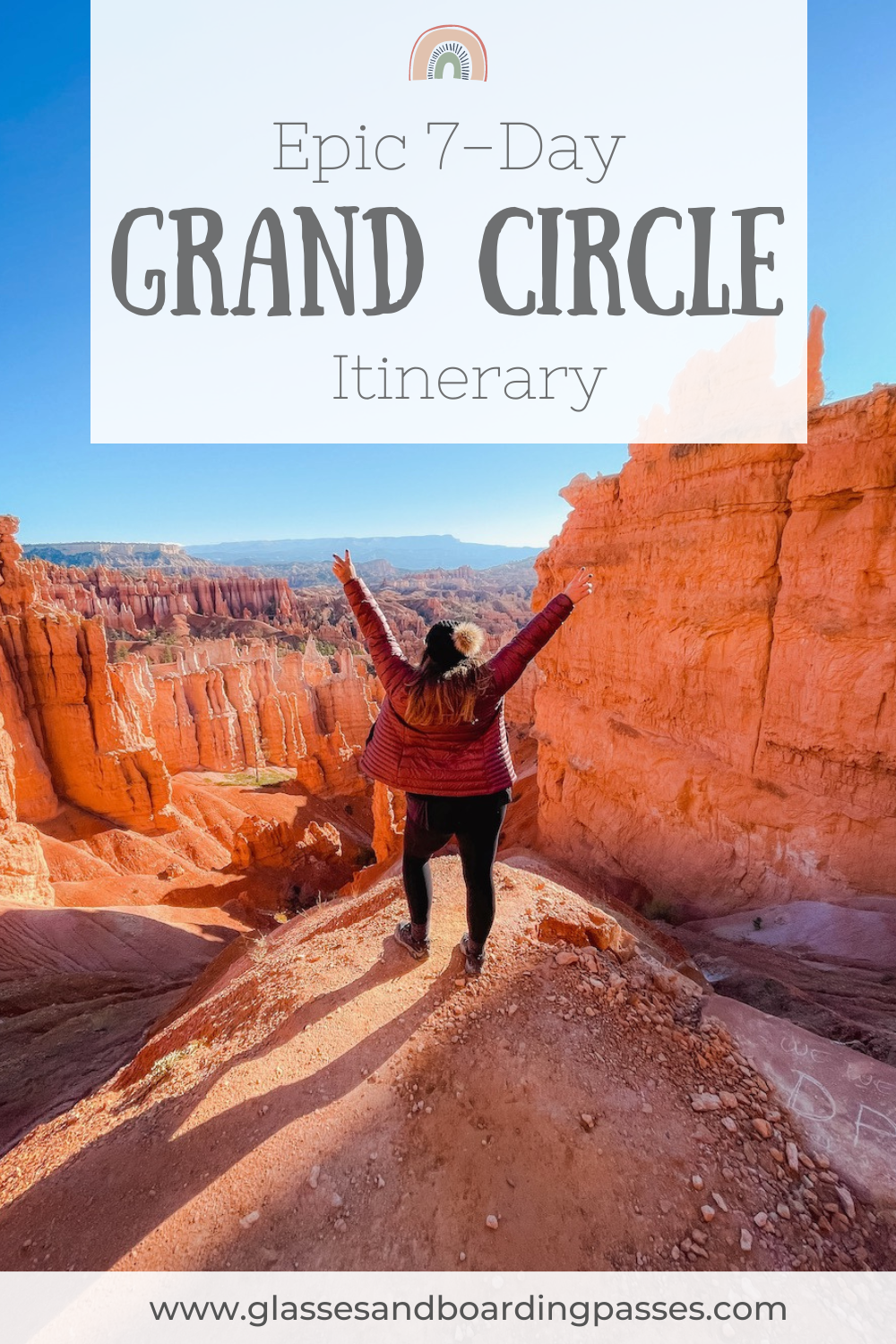
If you’re looking for otherworldly views and dramatic landscapes, there’s no place like the southwest USA. A road trip itinerary through the “grand circle” (aka a loop between Las Vegas, Utah’s five national parks, and the Grand Canyon) is an epic way to see these landscapes firsthand.
I took this road trip with my best friends and it’s still one of my favorite trips to date. The beauty of this area is unparalleled! I guarantee you’ll love it too.

Views from the road through Capitol Reef National Park. Are you ready for epic landscapes like this?!
Before we dive into the details of this grand circle road trip itinerary, let’s chat logistics.
I’ll be upfront: this itinerary packs a lot into one week (six national parks, to be exact!). Obviously, you could spend a week at almost every one of these stops. There’s so much to see in this part of the country! However, I’ve designed this road trip itinerary to give you a taste of all the grand circle highlights so you can pack as much into your week vacation as possible! You can always come back and explore your favorite areas on a later trip.
As with all national park trips , I recommend getting the Annual Parks Pass to save on your park entrance fees! It’s also fun to get a national parks passport that you can get stamped at all the park visitors centers.
This part of the country gets very hot in the summers (and also packed with tourists), so I recommend visiting in the shoulder season, like early spring or late fall. I visited in October and it was perfect. Mornings were a bit chilly, but the sunny afternoons quickly warmed things up.
Finally, many parts of this itinerary are in remote areas, so cell phone reception may not be the best. Consider a GPS phone, and at the very least make sure to have your itinerary and directions available offline.
Food, gas, and rest stops may be few and far between, so always make sure you have enough gas to get to the next major city. And, as my grandma always said, never skip a bathroom!
Bags packed and ready to go? Here’s my itinerary for an epic week-long grand circle road trip.
Read more: The Ultimate U.S. National Parks Guide
Grand Circle Road Trip Itinerary: Day 1
Arrive in las vegas.
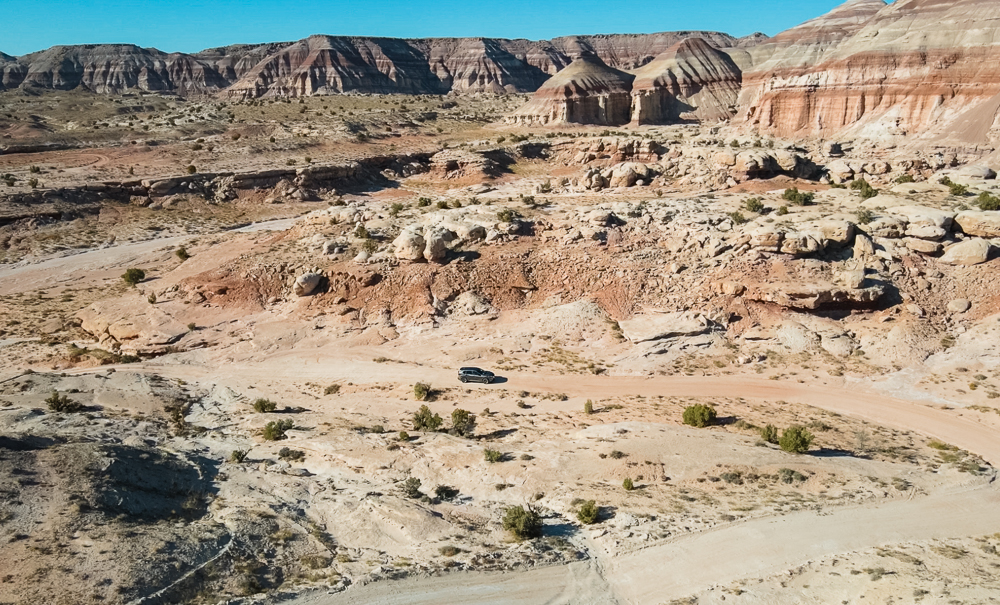
4x4s make driving through the off-road section of Capitol Reef National Park a breeze.
The easiest way to start your grand circle road trip is from Las Vegas. There are plenty of flights to this airport (including many budget airlines like Southwest). Make sure to arrive in the morning so you can take full advantage of day one.
It’ll be easy to rent a car directly at the airport. Opt for something with at least all wheel drive (or even four wheel drive), as some parts of this itinerary involve bumpy back roads.
Finally, I recommend packing snacks or stopping at a grocery store on your way out of town. Parts of this itinerary are fairly remote, so you’ll want to have plenty of food and water with you. I packed a reusable water bottle that I filled up at the airport and bought some non perishable snacks (like granola bars, clif bars, jerky, bagels and peanut butter, and canned sparking water) at a Wal-mart not too far outside of Las Vegas.
Visit Zion National Park
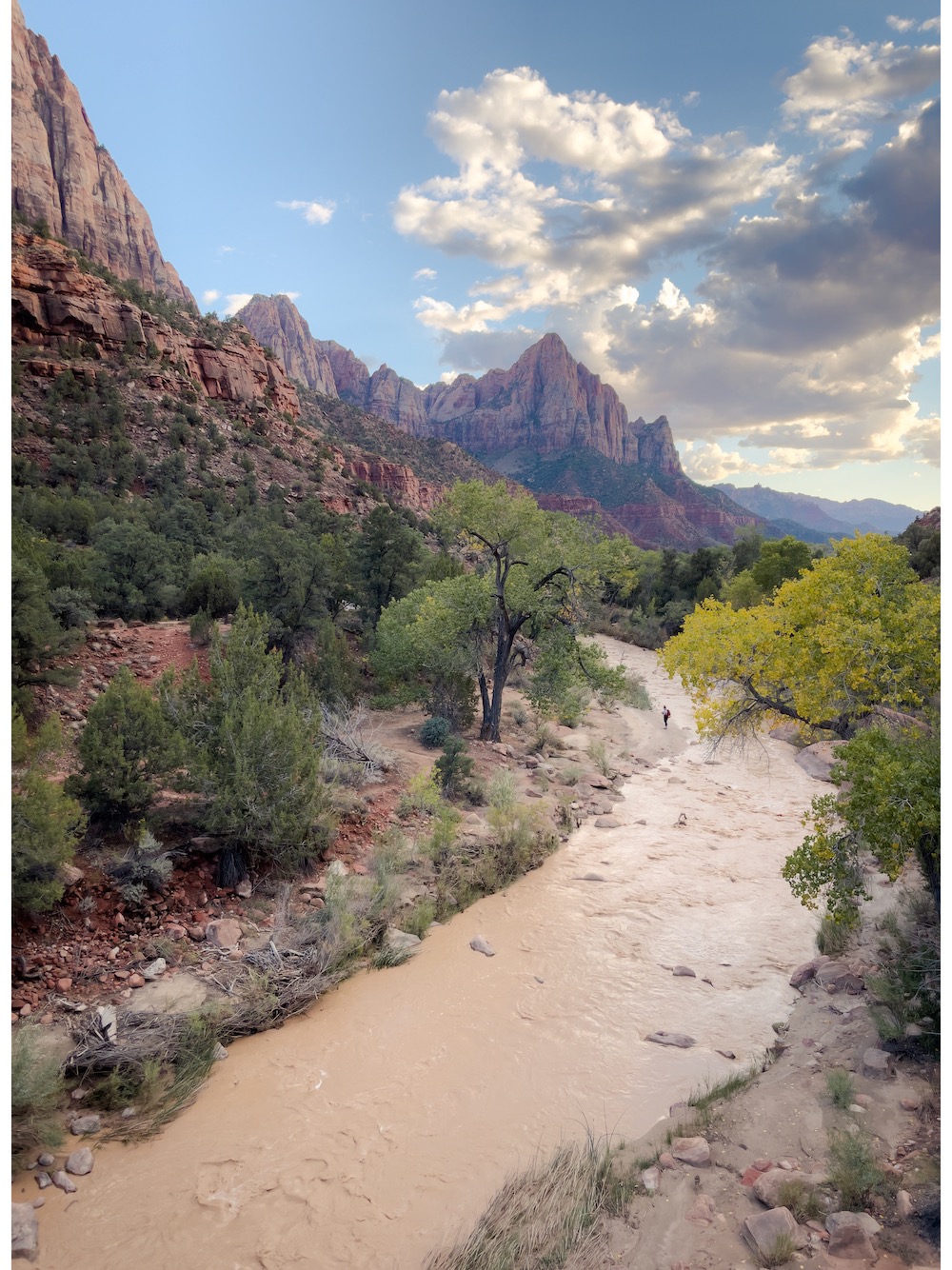
Our first park of the trip! Iconic Zion views.
After grabbing groceries and a quick lunch in Vegas, drive 2.75 hours northeast to your first stop: Zion National Park ! (Keep in mind that you’ll also lose an hour when you cross into Utah’s mountain time zone.)
Make your first stop at the Zion National Park visitors center. Here you can grab a park map, get your park passport stamped, use the restroom, and fill up on water. The parking lot is fairly small, and this park is very popular, so you may need to circle a few times to find a spot. One thing to keep in mind is that many of the roads in the park are closed during the summer and require you to take park shuttles to trailheads, so make sure to check the park’s website before setting out.
Next, stop at the photogenic Canyon Junction Bridge for some pictures. This spot is about ten minutes from the visitors center and will sneak up on you, so be aware! There are a few nearby pull offs that you can park in while you pop out for your pics. This stop will only take a few minutes but it’s worth it for the scenery.
You’ve got time for one hike in Zion, so pick wisely! We skipped the ever-popular Angel’s Landing and the Narrows (we’ll come back another time for those!) and opted for a slightly less intense hike at Canyon Overlook that still packs in amazing views.
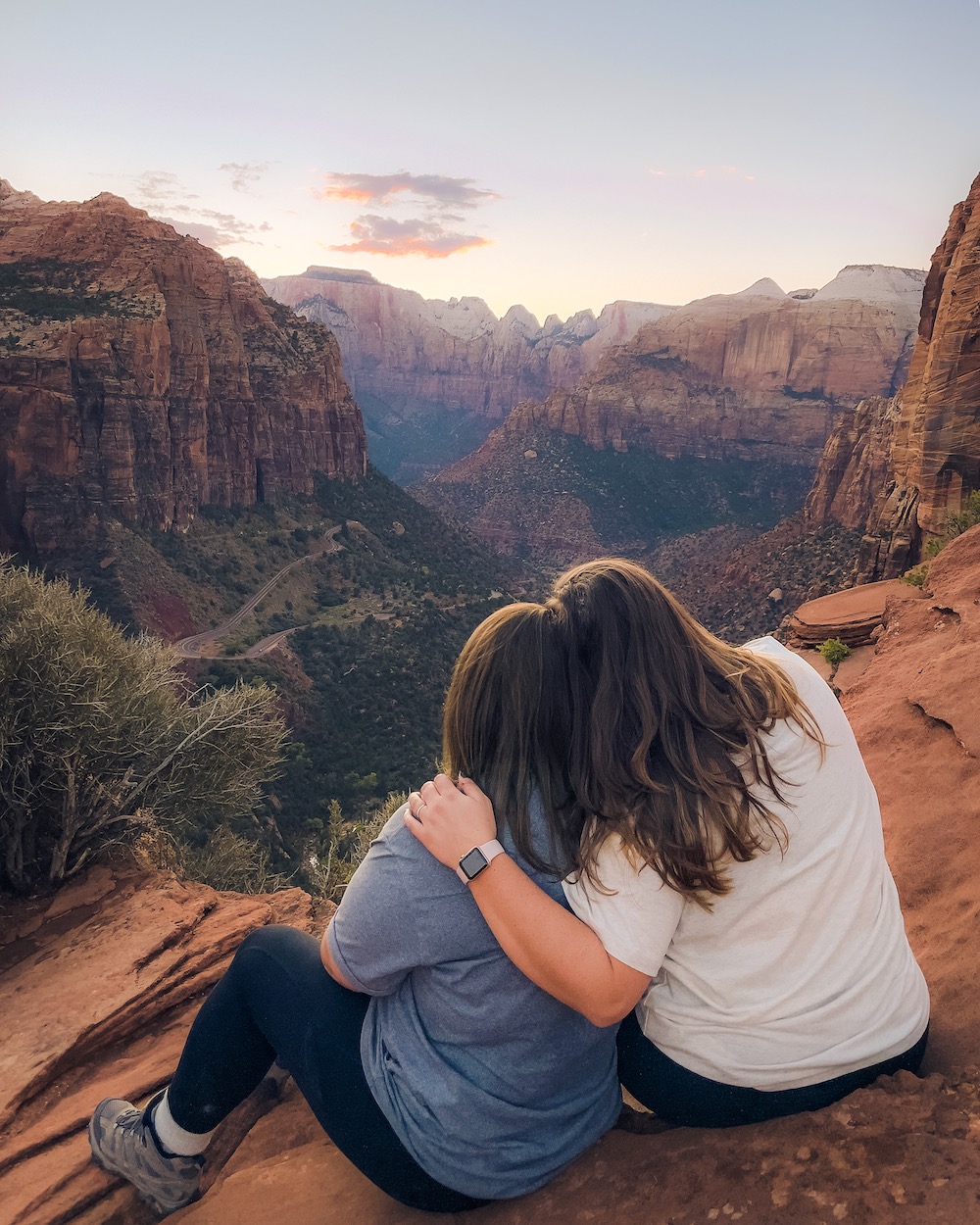
The first of many beautiful sunsets on this trip!
The trailhead is about 15 minutes from the bridge. This is another one that sneaks up on you! This parking lot is VERY small. We had to park along the road shoulder and walk back to the trailhead.
The Canyon Overlook Trail is a one mile out-and-back trail with about 160 feet of elevation gain. While short, consider that you are hiking at elevation which may take longer. Parts of the trail were slippery with sandy rock – don’t skip your hiking boots here!
The end of this trail is a spectacular viewpoint looking over Zion Canyon. You can see little cars winding up the road you just drove. Take a few minutes and enjoy the view, maybe while enjoying one of the snacks you packed! If you time it right, you’ll be getting here around sunset and can watch the sky light up beautifully.
End the first day of your grand circle road trip by staying somewhere between Zion and Bryce Canyon. We opted for a rental property in Hatch, which is another hour north of Zion, and grabbed dinner at a local saloon.
Grand Circle Road Trip Itinerary: Day 2
Sunrise at bryce canyon national park.
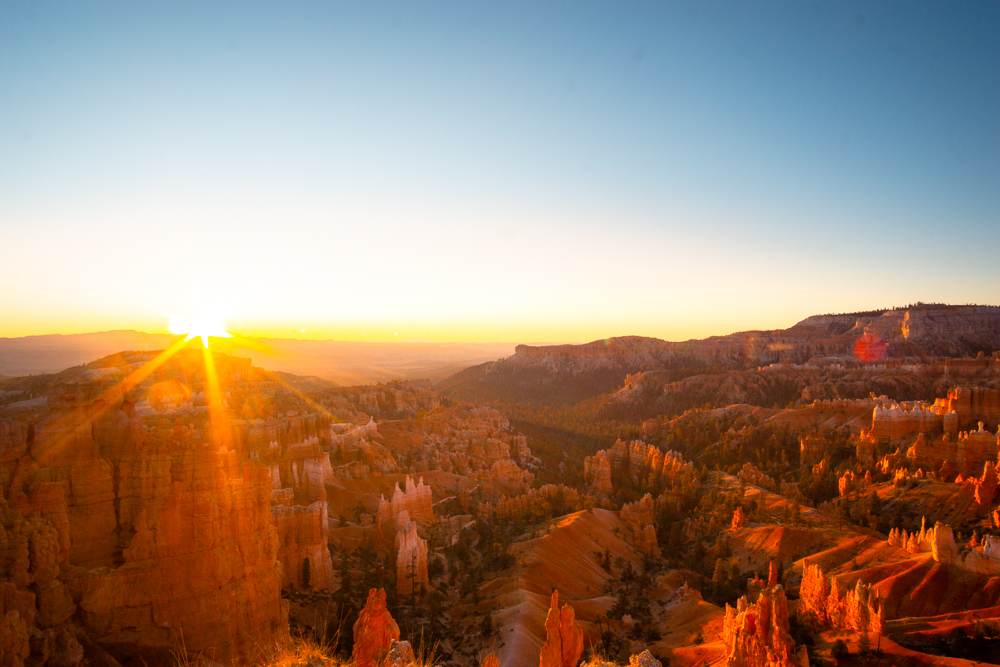
And the first of many sunrises!
Day two starts with an early wake up call – we left Hatch a little over an hour before sunrise. If you go in October like I did, it will be quite cold. It was even flurrying during our drive! Make sure to make yourself a hot coffee or tea before you leave and pack a warm, lightweight coat.
The drive from Hatch to the Bryce Canyon National Park entrance is about 35 minutes. Once you arrive, park near Sunset Point. There should be plenty of spots. (While there is also a Sunrise Point, I liked Sunset Point as you can see more of the sun on the rocks.)
After parking, take a short walk to the canyon rim and find a quiet spot where you can watch the sunrise peacefully. The views here are all amazing and you don’t need to be packed in at the overlook with the other sunrise photographers. Even before sunset, the views will be breathtaking – the canyon is filled with unique spiraling rocks called hoodoos and is unlike any other place I’ve seen.
As the sun comes up, you’ll be rewarded for the early wake up call with a spectacular show! The sun will peek over the canyon and slowly warm up the hoodoos with golden light. This was one of the best sunrises I’ve ever seen, and I won’t soon forget it.

Bryce Canyon is an absolute dream.
Once the sun is up, time for a hike! I recommend hiking the Navajo Loop Trail paired with the Queens Garden Trail for a 2.9 mile hike with 600 feet of elevation. This trail takes you down into the canyon, past plenty of hoodoos, through a forest, and back up some through some weaving hoodoos. Start at Sunset Point, then connect to Navajo, then Queens Garden, then Sunrise Point, then the Rim trail.
Plan for 2-3 hours for this hike, as there are plenty of beautiful spots along the way to stop and take photos. Plus, this is the highest elevation of the trip, so if you’re like me, you may be a little breathless!
Once you’re done, stop at the visitors center for the usual items. Then, grab lunch near the entrance to the park (there are a few general stores), and head on your way to your next destination!
Off Road at Capitol Reef National Park
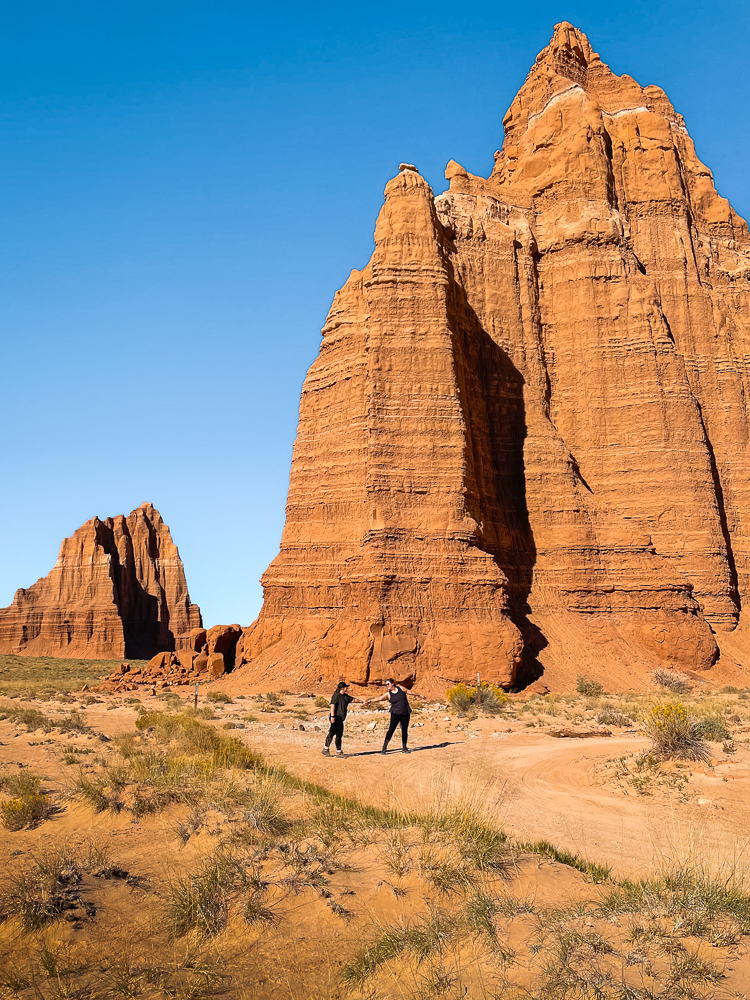
Dancing by the Temple of the Sun and Moon. One of the more remote places I’ve been!
Drive the 2.25 hours to the Capitol Reef National Park visitors center. Here, make sure you fill up on gas and water, because this afternoon is going to be remote!
Drive a little past the visitors center until you see a turnoff on your left; this will take you to the Temple of the Sun and Moon, two large rock formations in the remote part of this park. The drive is quite rough and will take almost two hours. Take your time and enjoy the epic views – you’ll likely be the only person for miles!
If you have a four wheel drive car and the river is low, you could also ford the river and drive to the epic Bentonite Hills. You’ve probably seen these on Instagram – these striped hills look like they’re the surface of mars, and at sunset turn amazing shades of blue and red. Unfortunately, the river was too high for us to safely cross (this is something to ask about at the visitors center!), but luckily there were a few similar hills on the way to the Temples of the Sun and Moon.

Bentonite Hills or Mars?
After you’ve seen the Temples, turn around and drive out the way you came. I would try not to do this past sunset, as it will be incredibly dark on the remote road.
Have dinner at one of the restaurants near the park (Pioneer Kitchen, Rim Rock, or Hunt and Gather). Then, rest up at the Capitol Reef Resort for the night.
Grand Circle Road Trip Itinerary: Day 3
Explore more at capitol reef national park.
This morning is all about exploring the “on-road” part of Capitol Reef National Park. There is a main road that winds through this part of the park, so I recommend stopping at the various turnouts and hiking around. Some great spots to stop at include Panorama Point, Sunset Point, and Goosenecks Overlook. These all have their own parking lots and short trails you can wander through.
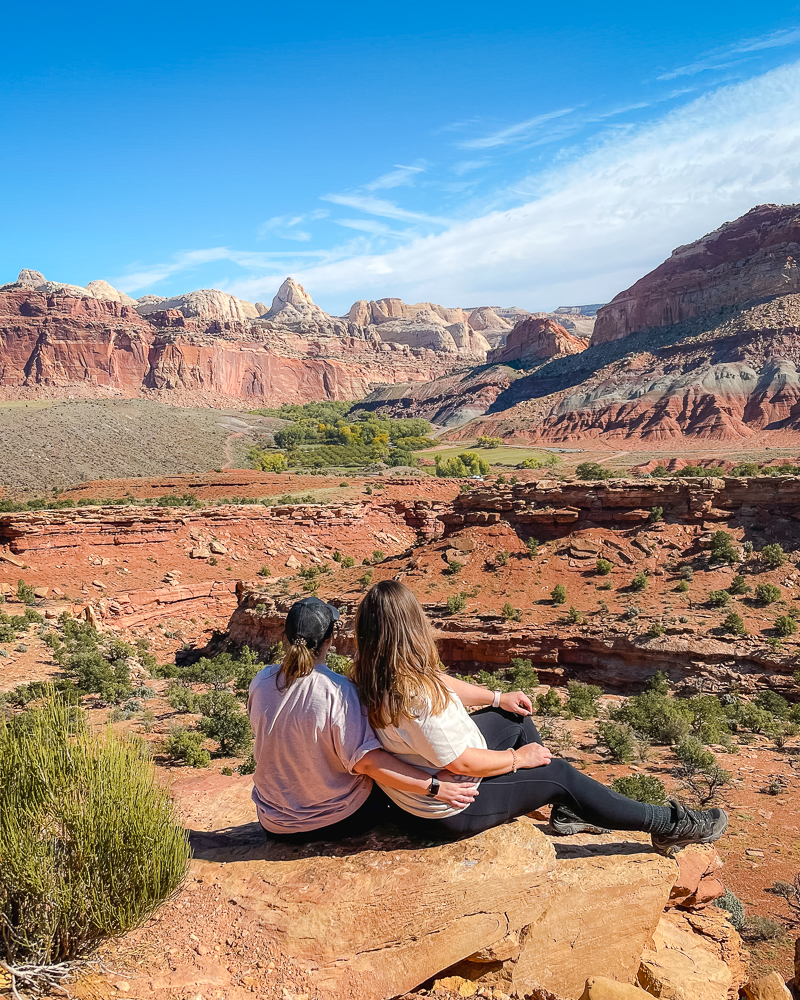
More epic views of Capitol Reef – don’t sleep on this park!
Then, head to the trailhead for the Fremont River Trail for the main hike of the morning. This hike is 2.0 miles roundtrip and 440 feet of elevation gain. You will start with a quiet walk along the river before steeply ascending during the second half of the hike. However, the views from the top are breathtaking! If you keep going past the official trail “end” (you’ll see an unofficial path from others), you’ll get a great view of the canyon below.
Reward yourself for all the hard work with one of the famous homemade pies at the Gifford Homestead. This historic home from the early 1900s serves up some delicious treats. Consider having a picnic lunch here with some of the snacks you bought on day one. Don’t forget to pet the horses!
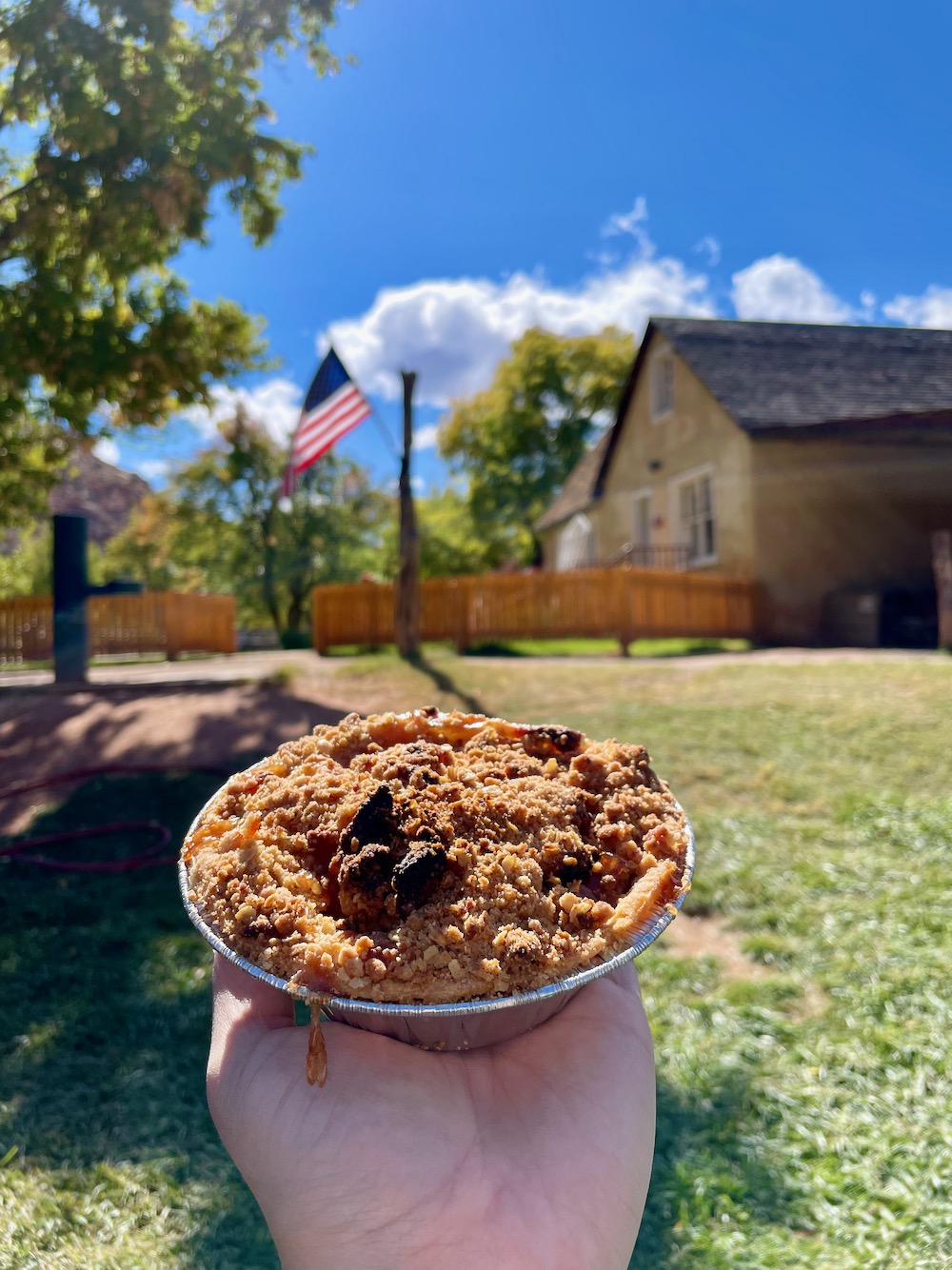
Motivation for hiking steep trails.
On your way out of Capitol Reef, stop at Petroglyph Panel to see a series of historic drawings from the Native Americans who lived in this area, the Fremont Culture, between 600-1300 AD. There’s a convenient parking lot at the turnoff and a few boardwalks to explore.
In my opinion, this is one of the most underrated parks in the US. Hopefully now that you’ve explored it for yourself, you’ll understand why!
Pit Stop at Goblin Valley State Park
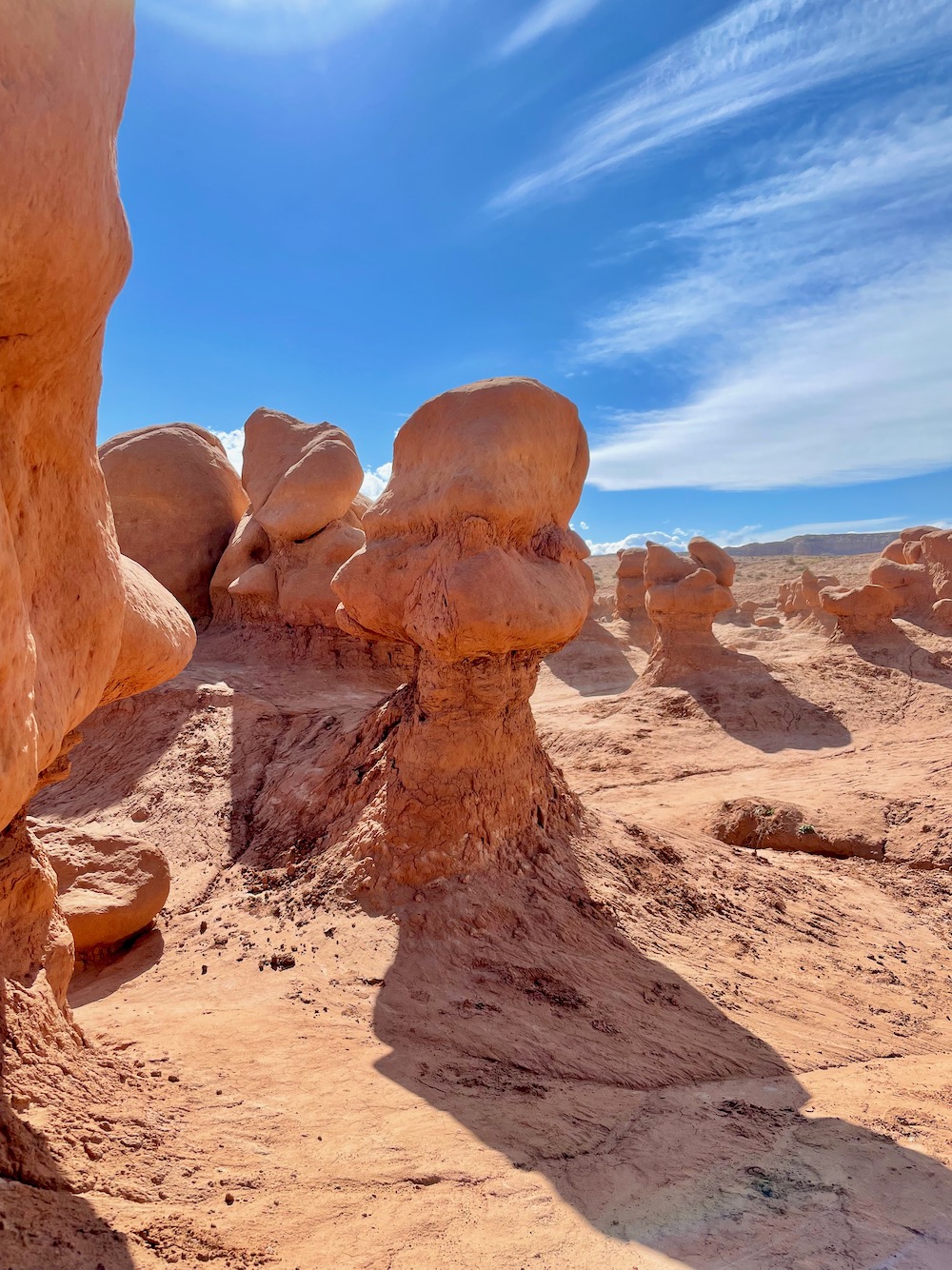
The ~unique~ rocks in Goblin Valley.
Next, drive east for about 1.25 hours until you reach Goblin Valley State Park. This unique area is worth a pit stop (and the entrance fee). The white rock formations are completely different from the red hoodoos in Bryce Canyon. Many of them may resemble a melting *eggplant emoji*, if you catch my drift.
You can free-roam through this canyon, so spend some time stretching your legs before the next leg of the itinerary, which is to drive another 1.75 hours to Moab.
Moab is by far the biggest town so far in this road trip, so there will be plenty of options for accommodation, including hotels and funky vacation rentals!
Grab dinner and drinks at a local restaurant. There’s plenty of good food in Moab! We ate Vietnamese at 98 Center Moab and loved it.
Grand Circle Road Trip Itinerary: Day 4
Sunrise at canyonlands national park.
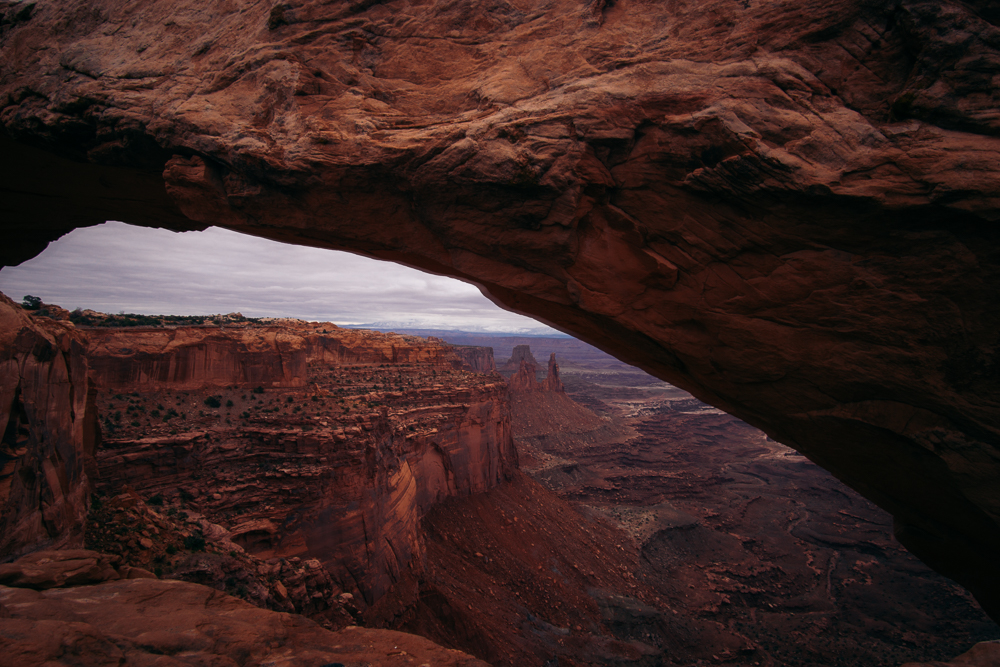
Sunrise at Canyonlands – sadly cloudy for us, but still beautiful!
Today’s grand circle itinerary involves another early wake up call (but I promise it’ll be worth it). Wake up at least two hours before sunrise and drive the hour into Canyonlands National Park . Head to the famous Mesa Arch trailhead and hike the easy 0.7 miles to the arch. Consider headlamps so you can see where you’re going in the dark!
There’s plenty of parking at the trailhead, but expect crowds at this famous sunrise spot. Getting there early will ensure you get a good spot to watch (or photograph) the sunrise over the Canyon and reflect off this giant arch.
After sunrise, continue driving along the park’s main road and pull off at some of the turn-offs for more beautiful views. I recommend Buck Canyon Overlook and Green River Overlook.
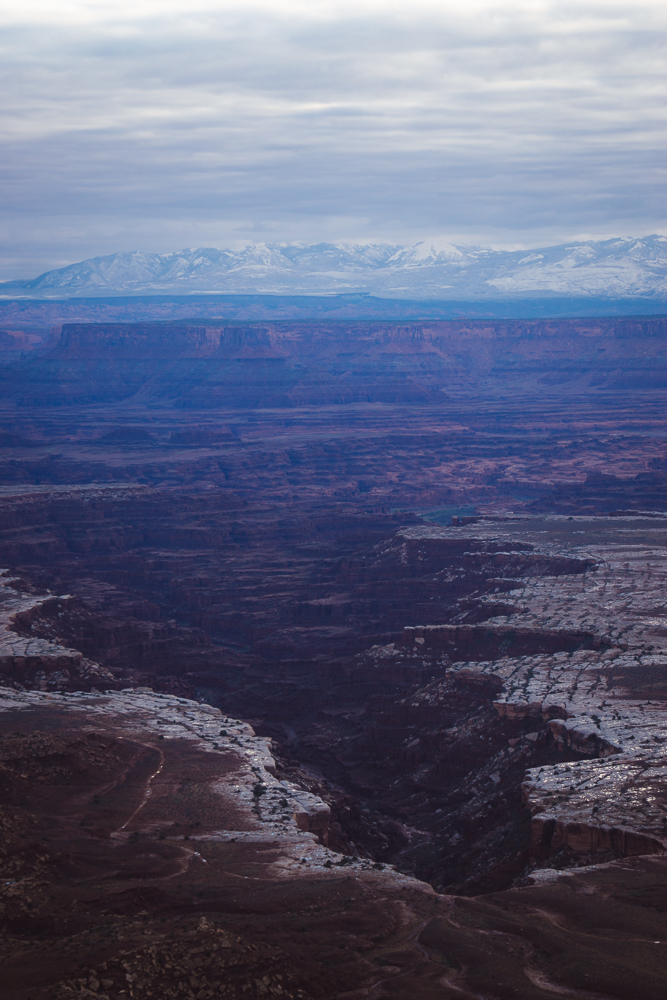
These landscapes are just unreal.
If you have the time (and energy), hike the White Rim Overlook trail. This 1.8 mile roundtrip hike includes only 159 feet of elevation gain and will get you even closer to some of the canyon overlooks.
Explore Moab
Moab is the largest town we’ve visited so far on this grand circle road trip itinerary, so after a busy morning in nature, spend a little time in the city. There are lots of cute shops selling local artisanal goods. There are also plenty of coffee shops, bars, and restaurants to explore! Don’t miss Love Muffin, our favorite little coffee and breakfast spot.
Sunset at Dead Horse Point State Park
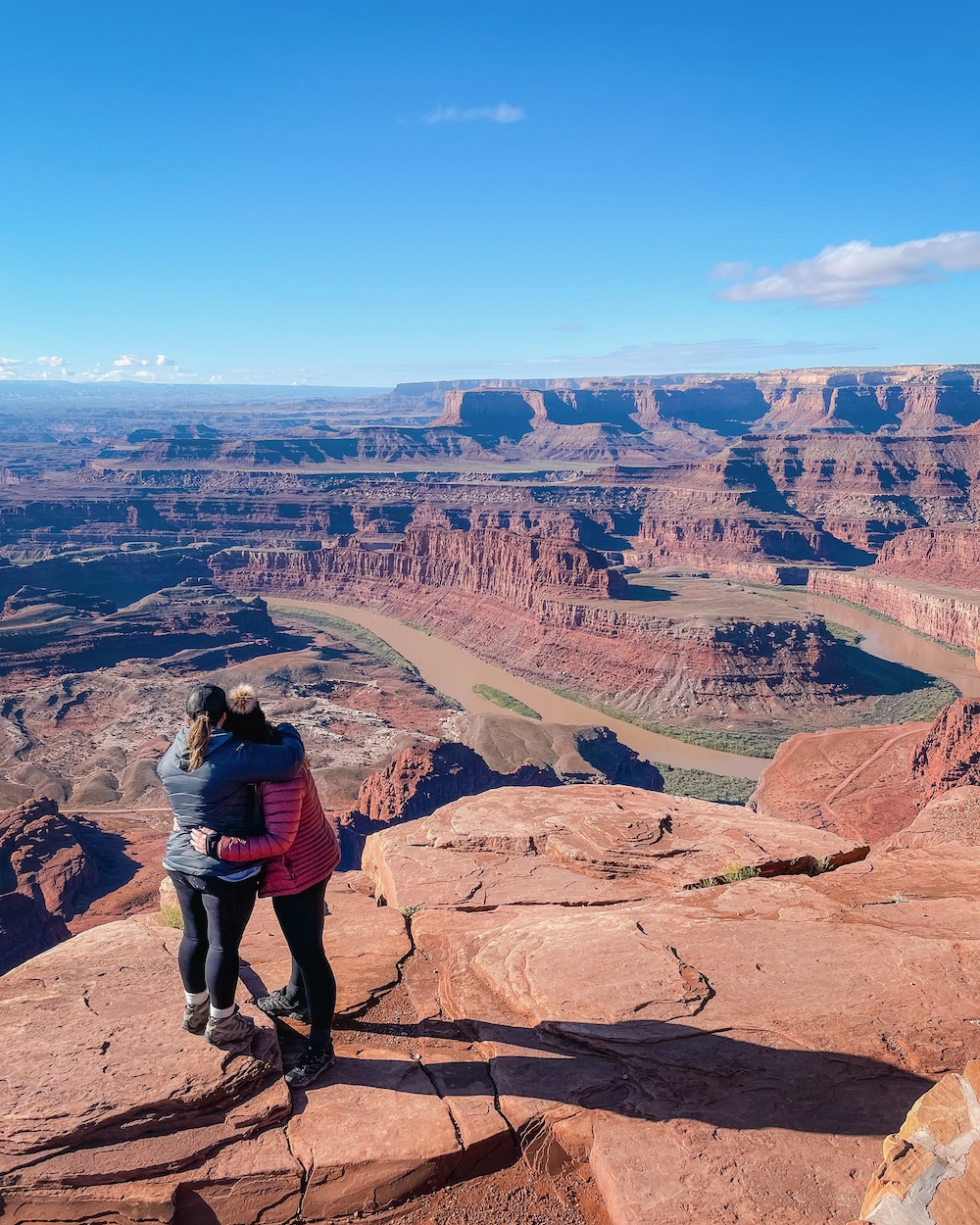
Dead Horse Point State Park – sad name, good views.
There’s so much to do in this area that Dead Horse Point State Park is often overlooked by visitors. Don’t make that mistake! This is an incredible park that is certainly worth a visit. The landscape is similar to the famous Horseshoe Bend, but twice the bends!
There are a few trails you can hike, but we just wandered around the main one along the canyon’s edge. The views are breathtaking, especially at sunset!
This state park is about 45 minutes drive outside of Moab and requires a $10 entrance fee.
Grand Circle Road Trip Itinerary: Day 5
Sunrise at arches national park .

Delicate Arch is even bigger in person than we imagined!
Another day, another sunrise. Arriving early to the popular (and crowded) Arches National Park will give you plenty of time to explore its unique landscape.
You’ll start your day with a hike up to the famous Delicate Arch. Leave about two hours before sunrise to allow for the 45 minute drive into the park and the beginning of the hike. Again, I suggest bringing a headlamp so you can watch your step on the trail.
This 3.4 mile, 480 foot elevation gain hike is very popular, but also rather challenging. There are parts that are quite steep, as well as close to large drop-offs (including the end of the trail near the arch itself). If you’re afraid of heights, keep this in mind. Seeing this huge, mind-blowing arch in person will be worth the effort, though!
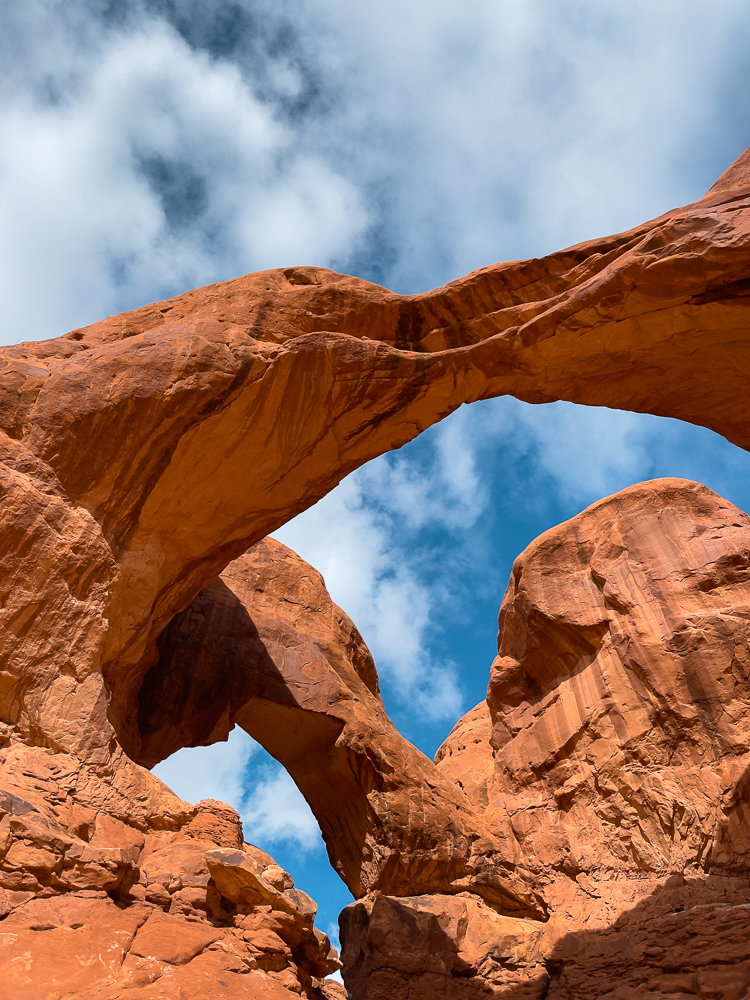
Nature is neat.
Once you’re finished with the Delicate Arch hike, there are a few other arches you can see from fairly near the parking lots. These include Windows Arch, Turret Arch, Double Arch, and Balancing Rock.
Before you leave, head out on one more (less strenuous) hike to Landscape Arch. This arch is long and thin and appears to almost defy physics. This hike is 1.8 miles and only 40 feet of elevation gain, so will be fairly easy compared to the first hike of the day!
Once you’ve finished, it’s time to pack up, fill up on gas and water, and head south for the next part of your epic grand circle road trip itinerary!
Detour Through Monument Valley
Run, Forest, run!
Take a slightly longer route to Page, AZ by driving through Monument Valley. You’ve seen this in countless photos and films (including Forrest Gump), and trust me, the extra driving time is worth it to see this beautiful area! The way the rocks rise up so high from the flat ground is amazing.
Make sure to stop at the aptly named Forrest Gump point along Highway 163 for the famous view of the road with the iconic monument valley rock formations in the background. There’s a pull off on the right side of the road where you can park and snap a photo. The drive from Moab to here will take you about 2.25 hours.
From here, drive another 2.25 hours to Page, AZ, where you’ll spend the night. We treated ourselves to Under Canvas Glamping and are so glad we did – it was such a unique stay. We got the stargazer room so we could see the stars from our bed. Just be warned that it gets a little cold at night so be prepared to stock your fire!
Note that if you do this, Under Canvas Lake Powell is in Utah, a separate time zone from Arizona. This part of Arizona is also a separate time zone from the part you just drove through (due to being on Navajo lands). It can all be a bit confusing so I recommend manually setting your phone to Page time so you don’t miss any tours or events!
Grand Circle Road Trip Itinerary: Day 6
Squeeze through a slot canyon.
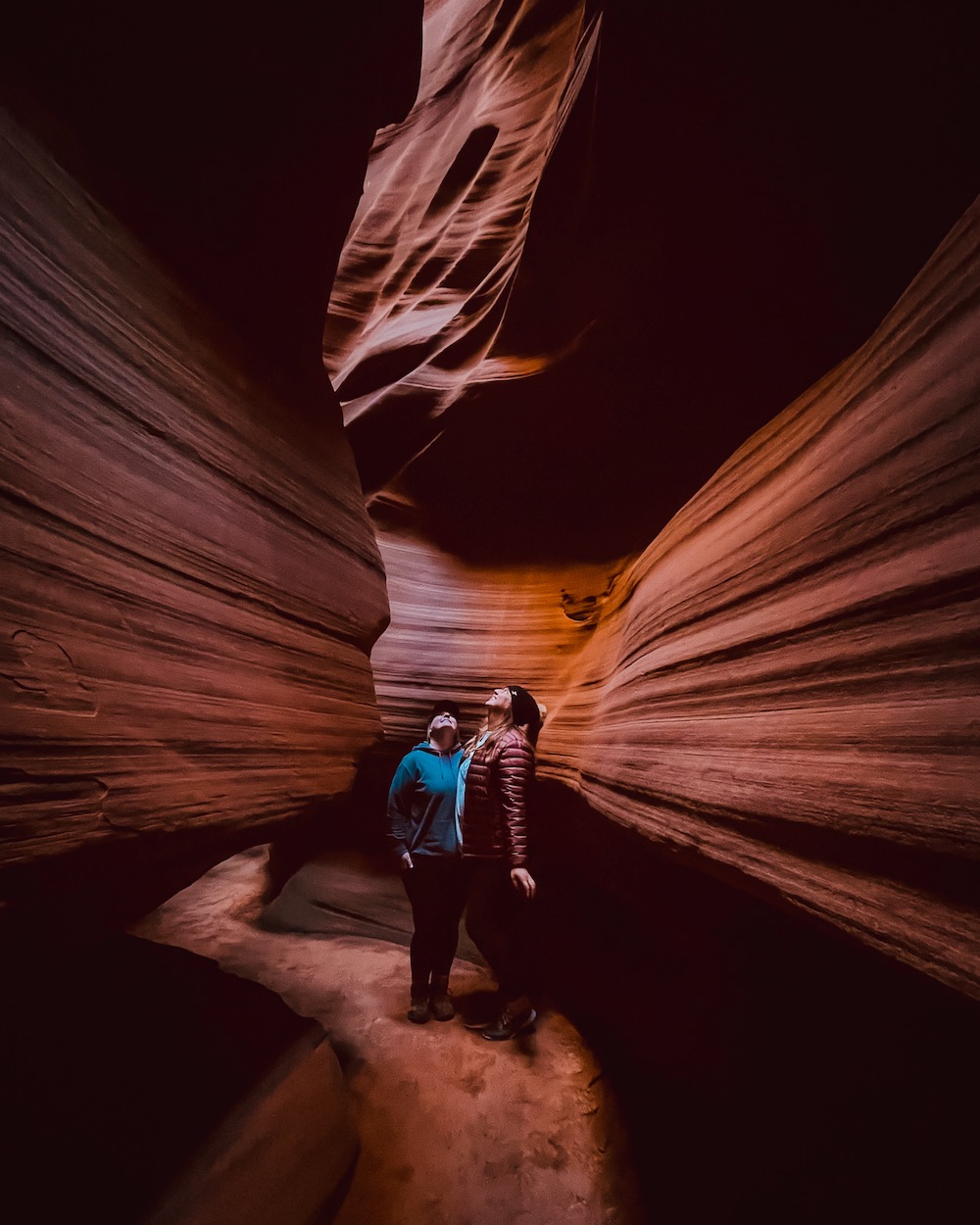
You could almost feel how mystical these slot canyons are.
Sleep in this morning (you deserve it!) before heading to a slot canyon tour. The most famous slot canyon is Antelope Canyon (specifically lower Antelope Canyon), which is on Navajo land. The canyon is sacred to the Navajo people and they are the only ones who can provide tours of the canyon. You can’t visit on your own, you must book one of these tours.
It can get a bit crowded in Antelope Canyon, but there’s nothing like it so I think it’s worth a visit. The crowds are better in recent years now that they made the canyon one-way walking only. The best time of day to visit is midday so you can see the famous light beams! Sadly in October the sun doesn’t get high enough in the sky for this, but it was beautiful nonetheless.
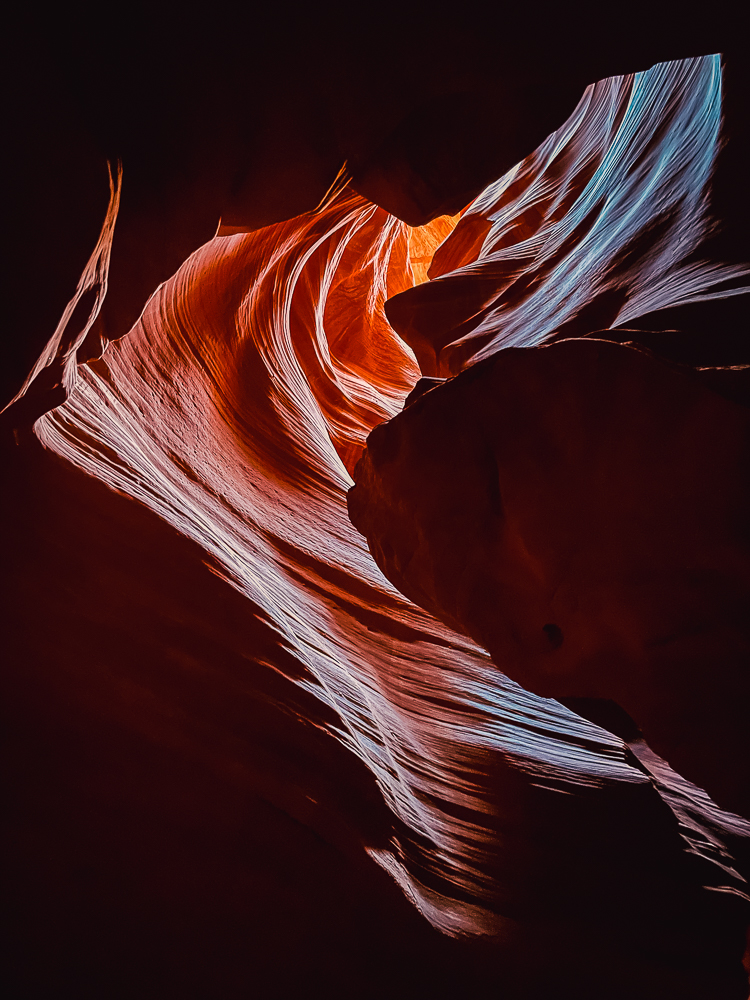
Abe Lincoln’s chin…can you see it?
Several tour companies offer package tours so you can see other slot canyons. Definitely do this so you get a contrast to Antelope Canyon, both in terms of style and crowds! Being alone in a quiet slot canyon is definitely a majestic moment.
I was worried about the slot canyons being too narrow and getting claustrophobic, but they weren’t too bad. Looking up and seeing the sky really helped!
Relax at Lake Powell
Grab lunch in Page on your way back and spend the afternoon relaxing at Lake Powell. You can rent a boat or kayak and enjoy some time on the water and in the sun!
Sunset at Horseshoe Bend
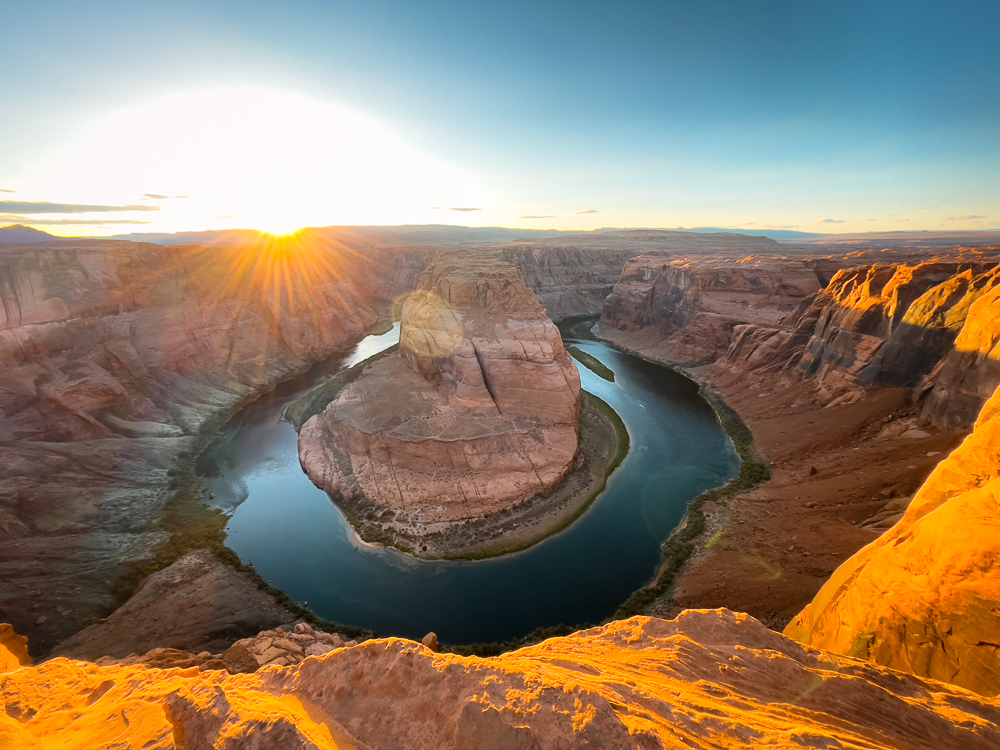
Famous, but for good reason.
Horseshoe Bend is probably one of the most famous viewpoints in the world, but honestly, it’s for good reason. This spot is just gorgeous!
The viewpoint is a short, 10-minute walk from the parking lot. While there will be large crowds, the bend is quite large and there are plenty of large rocks for you to find a spot that’s a little less busy. Get here early, bring a picnic, and enjoy a beautiful sunset as it reflects off the canyon walls and Colorado river below.
Grand Circle Road Trip Itinerary: Day 7
Explore grand canyon national park.
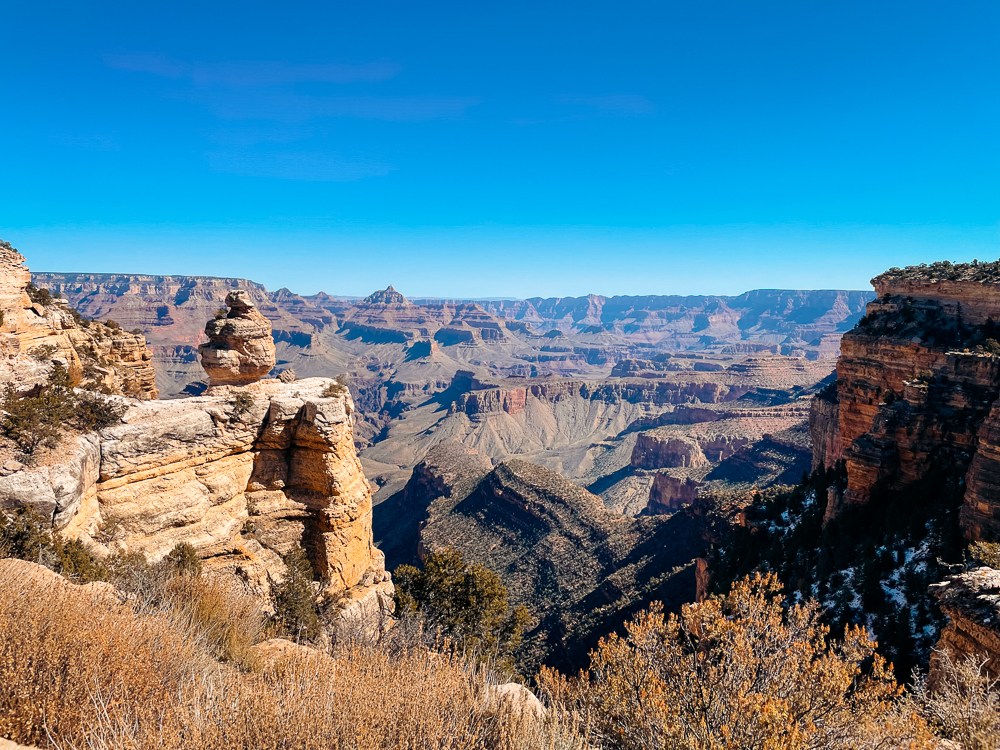
The grandest canyon of them all.
It’s time for one more national park on your last day of the grand circle road trip itinerary! Drive the 2.5 hours south to the south rim of Grand Canyon National Park for epic views of this incredible landscape. This is one of those places where pictures just can’t do it justice!
There’s no real itinerary for this section – just stop at various pull offs along the southern rim and enjoy the views!
Witness History at the Hoover Dam
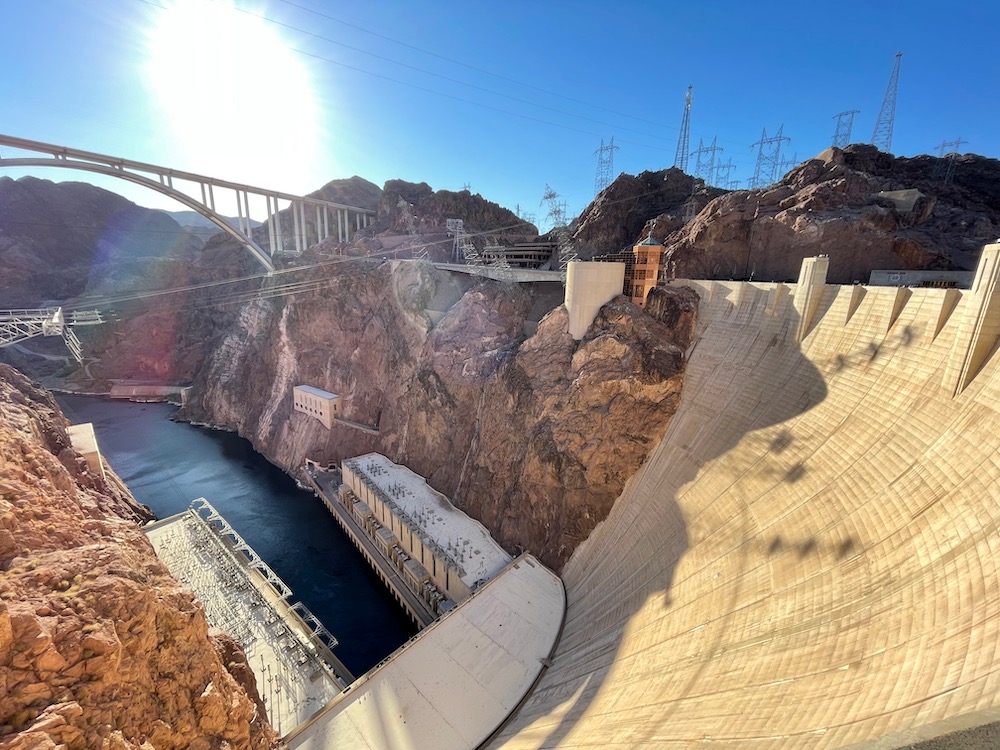
Hoover Dam!
After leaving the Grand Canyon, drive 3.75 hours west towards Las Vegas. The Hoover Dam is famous for being a depression-era feat of engineering. Conveniently, it’s also right off the highway on your way back, so it’s well worth it to stop! Depending on how much time you have, you can vary how long you spend here. We just parked and took a quick walk across the bridge, but you can definitely stay longer and learn more about the history and engineering of this massive dam.
Return to Las Vegas and Head Home
Unfortunately, it’s finally time to drive the final hour back to Las Vegas, return the rental car, and head home. It’s been an amazing trip!
LGBTQ Considerations
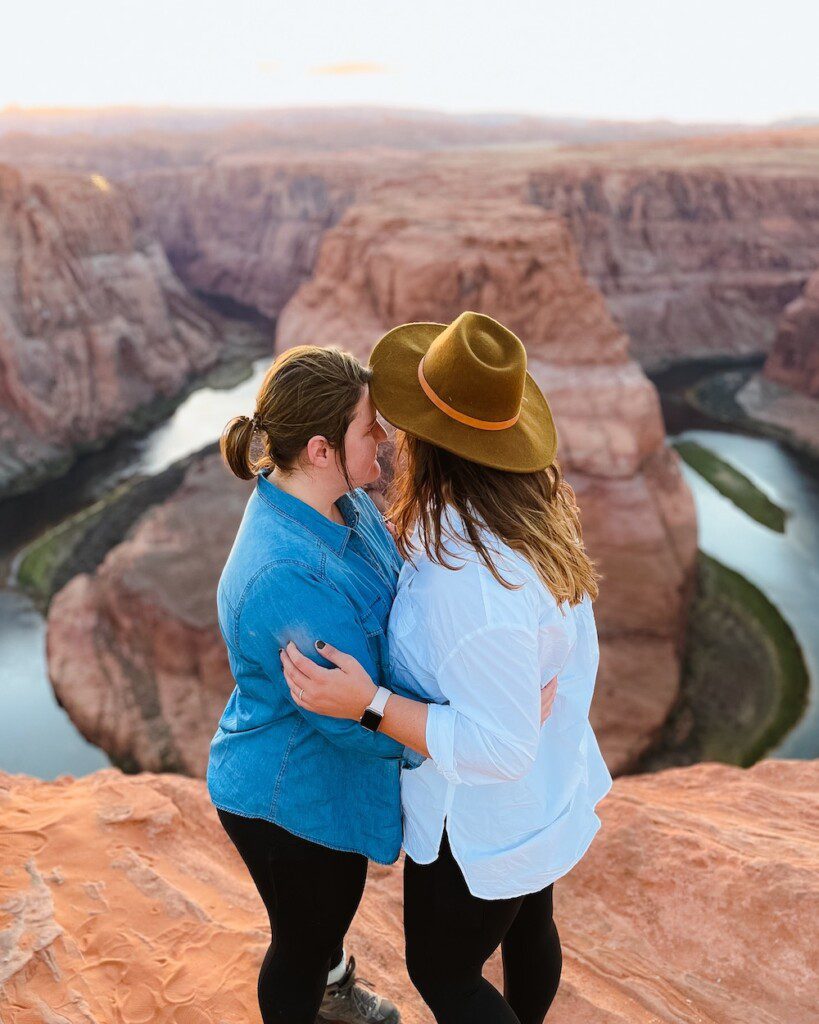
My wife and I went on this trip with another lesbian couple, and we all had an amazing time! While I’m always a little cautious in small towns, generally national parks attract a diverse crowd, which enabled us to relax, explore, and be ourselves.
Read more: Top Safety Tips for Queer Travelers
I hope you’ve enjoyed this grand circle road trip itinerary as much as I did! This is one of the most beautiful parts of the USA and being able to pack so much into one trip is just incredible.
Tell me, what was your favorite part of the grand circle road trip?
Read more: United States Travel Guide
Share This Story, Choose Your Platform!
Related posts.
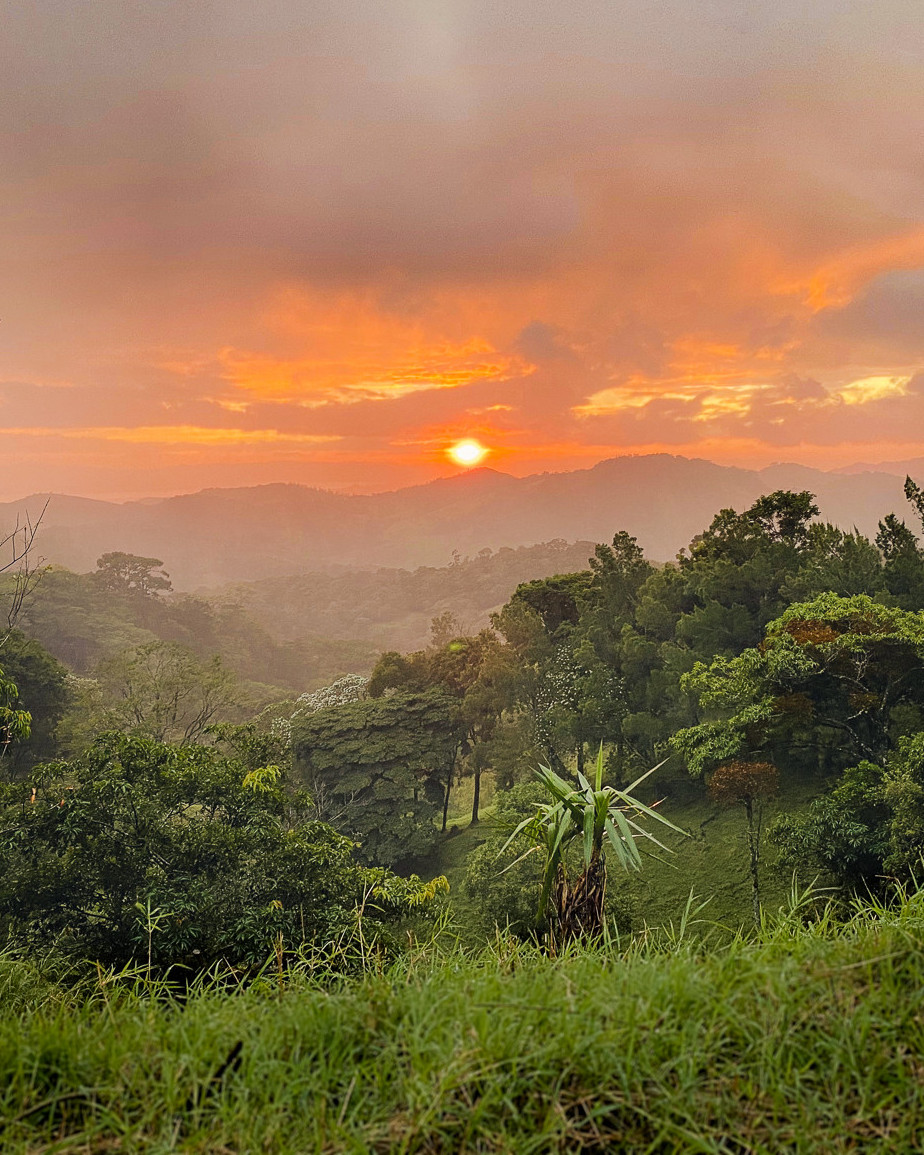
The Ultimate 10 Day Costa Rica Itinerary
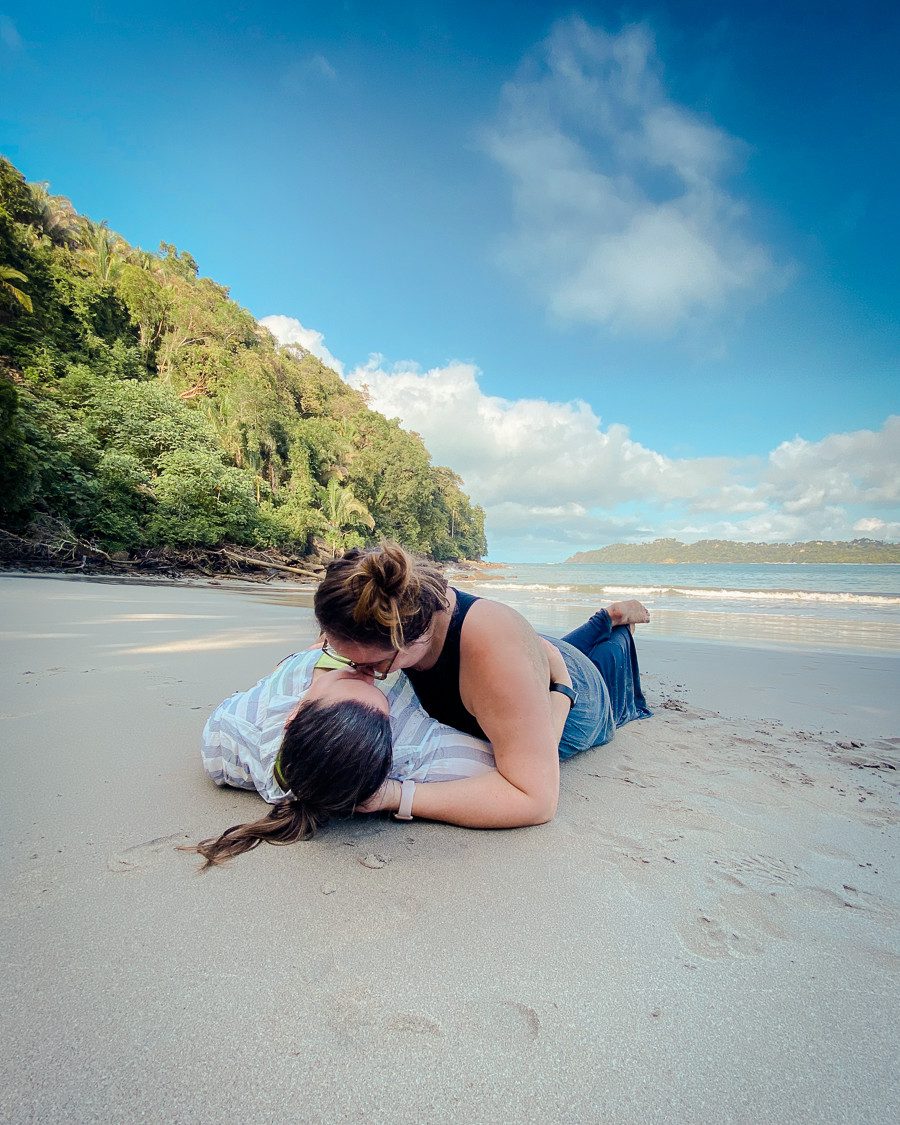
The Queer Traveler’s Guide to Costa Rica

The Best Things to Do at Indiana Dunes National Park
Hello, I’m planning a Grand Circle road trip and like the itinerary you posted. We will have 7 nights and was wondering where you would spend an extra night?
Great question! I would pick which park sounds most interesting to you and stay there! That being said, this itinerary probably spends the least amount of time in Zion – that park has so much more to offer, so if it were me, I would stay there!
Leave A Comment Cancel reply

20 Incredible National Parks Near Las Vegas
D id you know there are 20 national park units within six hours of Las Vegas? With so many national parks near Las Vegas, it makes sense to use this major vacation destination as a hub for exploring all these incredible places.
Fly into Las Vegas and then take several day or weekend trips to explore these national parks. Or better yet, rent a vehicle and embark on an epic road trip to see them all! Here is your guide to national parks near Las Vegas, with details regarding driving distance and plenty of things to do once you arrive in the parks.
Spending time in town? Here are 40 Fun Things to do in Las Vegas with kids .
20 National Parks Near Las Vegas
Zion national park.
Distance from Las Vegas : 2 hours, 40 minutes (160 miles)
Zion is one of our country’s most visited national parks, in part because it is within a day’s drive of several metropolitan areas, including Las Vegas (which also happens to be the closest). It is also an all-season destination, with the heaviest visitation coming during the scorching summer months.
For most of the year, visitors park in the town of Springdale or at the Zion Visitor Center and then take a free shuttle into Zion Canyon where the bulk of the major attractions are located.
Highlights include the Emerald Pools (which when combined with the Kayenta Trail make for a great day hike), Weeping Rock , Angels Landing (permit required), and the iconic Zion Narrows.
Hiking in the Zion Narrows involves walking (and sometimes even swimming) in the Virgin River as it winds through a dramatic canyon. Proper gear can be rented in town and weather conditions should always be confirmed with park rangers before heading out. Never hike in the Narrows when flash floods are a possibility.
Biking in Zion Canyon is a great option if you don’t want to deal with the often-crowded park shuttle. Zion Outfitters rents E-bikes, regular adult bikes, and children’s bikes.
Tubing the Virgin River in the town of Springdale is an especially popular May through July. Canyoneering is another great thing to experience in Zion. Zion Outfitter has a special Family Adventure program designed for groups with kids younger than 12 .
Here are 15 epic things to do in Zion with kids and our guide to visiting Zion in the winter .
Spend the night : Cable Mountain Lodge rooms feature full kitchens, large living areas, and plenty of space for large families in their suites.
Death Valley National Park
Distance from Las Vegas : Two hours (125 miles)
Death Valley is the closest of the 63 National Parks Service units with the official “national park” designation. Most of the park is located in California, but Las Vegas is the closest major city and many people visit Death Valley as a day trip.
What you need to know is that Death Valley is massive . It is 3,422,024 acres in size, making it the largest national park outside of Alaska. So if you want to truly explore the park, you are going to need it a multi-day trip.
The other thing you need to consider is the weather. In the summer, temperatures can reach over 120 degrees, so travel to this incredible national park is much more ideal in the winter and early spring when temperatures are much more pleasant.
Places you definitely don’t want to miss include Badwater Basin (the lowest point in North America at 282 feet below sea level), Zabriski Point , Artist’s Drive , and the Devil’s Golf Course .
If you are looking to stretch your legs and go on a hike, Golden Canyon , Mosaic Canyon , and Sidewinder Canyon are all great options for families.
Definitely make time for the Mesquite Sand Dunes which are an absolute blast to explore. Bring a snowboard and you can ride down the dunes with ease! It also fun to roll down them, run down them, and make sand angels. Or simply just wander and enjoy their beauty.
Read our complete guide to visiting Death Valley with is filled with great tips for your adventure.
Spend the night : The Ranch at Death Valley is located in Furnace Creek near the park visitor center. It has recently undergone a massive, multi-million dollar renovation and has a spring-fed pool that is a constant 87 degrees, tennis courts, basketball courts, volleyball courts, a playground, restaurant, and much more.
Tule Springs Fossil Beds National Monument
Distance from Las Vegas : 18 miles (20 minutes)
Tule Springs Fossil Beds National Monument joined the National Park System in 2014, and since it is within the Las Vegas City limits, it is considered to be an urban park.
This national monument preserves thousands of Pleistocene (Ice Age) fossils that were preserved by wetlands that were expanding and contracting in this location thousands of years ago. Much of this monument is located in the Upper Las Vegas Wash, a rather dry and unremarkable looking locale most of the year.
But what is remarkable is the number of fossils that have been found here- mammoths, bison, lions, horses, camels and sloths, all of whom lived in a wooded, riparian environment.
The best way to enjoy this monument is to sign up for a ranger-led hike which is typically 1.5 – 3 miles in length and a fun way to learn about the natural history of the park. They even offer dog-friendly Ranger-led hikes on select days!
Red Rock Canyon National Conservation Area
Distance from Las Vegas : 20 minutes (16 miles0
A mere 20 minutes west of the Las Vegas Strip, visitors can be swept into a world of hiking, rock climbing, and outdoor adventure at Red Rock National Conservation Area.
If you are visiting Red Rocks during the peak hiking season, October through May, you will need a timed reservation which must be booked in advance on the website. If you don’t have a reservation, you can still enter the park but it will need to be before 8am or after 5pm.
Take the 13-mile, one-way scenic drive from the visitor’s center and pull over at any spot that looks appealing. Just remember that if you decide you want to go back to someplace you passed, you will have to do the full loop around again to reach it.
Believe it or not, there is actually quite a bit of diversity packed into that 13-mile loop. There are areas that had towering red rock hillsides and sparse vegetation as well as canyons that are lush thanks to underground springs.
Calico Tanks is a popular, 2.2-mile trail near the beginning of the one-way loop that explores the red rock sandstone formations of the Calico Hills and leads to a hidden water pocket.
T he Willow Springs and Lost Creek area offers a mix of ecosystems, taking hikers from a creek bed up through red rocks and back down through the springs and a riparian area with a small waterfall. This area also has a large stone wall with pictographs.
The Willow Springs picnic area is a popular spot for rock climbing and bouldering. You will see amateurs learning to climb as well as more experienced climbers honing their skills.
Pine Creek Canyon is the place to head if you want hike among Ponderosa pines and towering canyon walls. This 2.4-mile trail is especially nice after a rain as it follows a creek.
Visiting Red Rock Canyon is one of our favorite outdoor activities in Las Vegas .
Lake Mead National Recreation Area
Distance from Las Vegas : 40 minutes (31 miles)
Lake Mead, the largest reservoir in the country , is a haven for boating enthusiasts and hikers, It is a truly great place to recreate just 30 minutes southeast of Las Vegas.
The lake has been in the news quite a bit lately, thanks to declining lake levels and the sudden appearance of sunken boats and even bodies dumped by the mob! But this lake, created by the construction of Hoover Dam on the Colorado River, still has over 290 square miles of water surface to explore and enjoy.
During the warm months, Lake Mead is a very popular place to enjoy boating, houseboating, jet skis, water skiing, tubing, swimming, and fishing.
One thing you might not known is that a B-29 Superfortress plane crashed into Lake Mead in 1948 and it has been at the bottom of the lake ever since. Dive companies do offer guided scuba diving trips to wreckage site.
Lake Mojave is also part of the Lake Mead National Recreation Area. It is located south of the Hoover Dam and has great boating, water sports, and swimming opportunities as well.
Mojave National Preserve
Distance from Las Vegas : One hour (67 miles)
If you have ever made the drive from Los Angeles to Las Vegas on Interstate 15 then you have driven along the northern edge of Mojave National Preserve in between Zzyzx Road and the state line. Lots of people look out at this seemingly never-ending expanse of desert and think it is a whole lot of nothing, but they wouldn’t be more wrong!
This national park preserve is home to Kelso Dunes , some of the largest sand dunes in the country which rise 600 feet above the desert floor. They are so fun to explore and it is easy to have a spot all to yourself while you hike the three-mile trail around the dunes.
These dunes are known to “sing”, making a deep sound that happens when your group heads to the top of the dunes and pushes as much sand off the top as possible. This mostly occurs during the summer, so you must be prepared for a very hot hike in order to experience it. Or, just watch the video below.
Another one of the big attractions at Mojave National Preserve is the lava tube . It was created by molten lava 27,000 years ago. There is a beam of light that shines into the lava tube at certain times of day (usually early afternoon in the summer) making it a beautiful spot for photos.
Here are 25 awesome caves in California to explore, including the lava tube .
If you are looking for a fun hike, try the 1.5-mile Hole-in-the-Wall Rings Trail . This trail takes you through Banshee Canyon and its swiss-cheese like holes in towering rock formations. The real fun is when you use rock-mounted ringbolts to climb into the rocky amphitheater at the bottom of Banshee Canyon.
Finally, if you love wildflowers as much as I do, you may want to add Mojave National Preserve to your flower-hunting list during a good rain year. The National Park Service has a great page highlighting what types of flowers you will see in different areas and the best time to see them (mostly March and April)
Spend the night : You are probably better off heading back to Las Vegas and making this a day trip since unless you are camping since there really isn’t anything close by.
Castle Mountains National Monument
Distance from Las Vegas : One hour, 45 minutes (85 miles)
Castle Mountains National Monument was established in 2016, making it one of the newer parks in the system. It protects 21,000 acres of desert northwest of the Colorado River in between Interstates 15 and 40. This is a landscape filled with Joshua trees, rare desert grasslands, and precious desert wildflowers. There is even pinyon-juniper forest at the higher elevations!
The Castle Mountains are protected habitat for a variety of wildife including for desert bighorn sheep, golden eagles, desert tortoise, gila monsters, and wild cats like bobcats and mountain lions.
This park is only accessible by dirt roads, so a four-wheel-drive, high clearance vehicle is recommended. There are no maintained trails; simply drive in and hike where you want. Here is a good article on visiting this remote national monument.
Spend the night : There is no lodging nearby. Las Vegas is your best bet.
Bryce Canyon National Park
Distance from Las Vegas : Four hours, 15 minutes (260 miles)
Bryce Canyon National Park is known for its incredible hoodoos- tall sandstone spires that have been carved by erosion resulting in scenery that looks like it is from another planet.
The Bryce Canyon Scenic Drive is 18 miles in length and has several great spots to pull off and enjoy different views of the canyon with names like Inspiration Point, Sunset Point, and Sunrise Point. The road ends at Rainbow Point , the highest portion of the park at over 9,000 feet in elevation.
The Bristlecone Loop begins near Rainbow Point and this one-mile loop trail takes you past ancient bristlecone pines, some of which are over 2,000 years old! The views from this trail allow you to see eastward for over 100 miles.
Of course you will want to make your way down into the canyon to stand next to the mighty hoodoos and get a true feel for this special space.
Our favorite hike in Bryce Canyon is the 2.9-mile loop created by combining the Navajo Trail with the Queens Garden Trail . This loop allows families to walk down into the canyon and experience the narrow sandstone walls of “Wall Street”.
Bryce Canyon one of the best star viewing locations in the United States. The clear, dry air and remote location make for ideal conditions and the parks hosts around 100 night sky programs each year.
Read our full guide to visiting Bryce Canyon National Park .
Spend the night: Three miles from the Bryce Canyon National Park visitor center is Ruby’s Inn and Bryce Canyon Grand Hotel . Both are under the Best Western Plus branding and great options for families.
Cedar Breaks National Monument
Distance from Las Vegas : Three hours, 15 minutes (205 miles)
Cedar Breaks is a high elevation park, sitting at over 10,000 feet and protecting the hoodoo-filled Cedar Breaks amphitheater which looks much like a mini-Bryce Canyon. This amphitheater is much steeper than Bryce Canyon, so hiking down into the amphitheater is not allowed.
You can also enjoy ancient bristlecone pines, summer wildflowers, and crystal-clear night skies at Cedar Breaks. Since the park is largely covered in snow for half the year, it is mainly open from Memorial Day to mid-October, but we have visited the overlook during a ski trip to Brianhead and found the views of snow-covered Cedar Breaks quite magical.
The Sunset Trail is a great hike for enjoying the views of Cedar Breaks. It is two miles in length and takes you from the Point Supreme Overlook and Sunset View Overlook.
Spend the night : We love the Brainhead Lodge which has a fun indoor pool with a waterfall, nice rooms, and a great location for skiing or exploring the national monument.
Glen Canyon National Recreation Area
Distance from Las Vegas : Four hours, 30 minutes (270 miles)
Glen Canyon National Recreation Area is home to Lake Powell , 24 million acre-feet of water resulting from the Glen Canyon Dam holding back the waters of the mighty Colorado River. I like to describe it as the Grand Canyon if it was flooded with water. It truly is that scenic.
When full, this lake that straddles the Utah/Arizona border and stretches for over 175 miles, with dozens of coves and inlets to explore. The typically hot, dry summer weather make it ideal for houseboats and water sports. Three million people visit Lake Powell each year but the lake is so vast, you will often feel like you have the entire lake to yourself.
Read our article on houseboating in Lake Powell .
Boat tours of Lake Powell are operated out of Waheap Marina that go to various locations within the lake. There is even a dinner cruise which allows you to enjoy the colors of the pastel sandstone bluffs as the sun goes down.
Float trips of the Colorado River below the Glen Canyon Dam to Lees Ferry are also available. The float trip allows you to cruise around the famed Horseshoe Bend with sandstone walls towering around you. Children as young as four can enjoy these half-day trips.
Spend the night : Lake Powell Resort is located right at Waheap Marina, where all your boat tours will depart. You can also rent powerboats from this location and explore on your own.
Rainbow Bridge National Monument
Distance from Las Vegas : Four hours, 30 minutes (270 miles) plus boat ride to Rainbow Bridge.
If you are already planning at visit to Lake Powell, then you will want to make time to visit Rainbow Bridge National Monument which is located next to Lake Powell. It is the world’s largest natural bridge that towers 42 feet high and 234 feet wide. It is an impressive sight for sure!
Unfortunately, due to low lake levels, accessing the bridge is much more difficult than it was in years past. The water level is lower than where the boat docks and restroom were placed , so the only way to reach it now is by taking a small boat that can be beached. Then you must hike 1.5 miles to the bridge. Portions of the trail are very mucky because until recently, they were under water.
Read about current conditions on the National Park Service website before heading out.
Joshua Tree National Park
Distance from Las Vegas : Three hours (187 miles)
With its towering boulders, diverse desert life, and Dr. Seuss trees, Joshua Tree is one of the national parks near Las Vegas you most certainly won’t want to miss. Here, the high desert (Mojave) and low desert (Colorado) meet, allowing visitors to see two enjoy desert environments.
Climbing around on the massive boulders that look like they have been left in piles by lumbering giants is definitely one of the park’s main attractions. You will see professional climbers scaling the boulders with their equipment, but amateurs will have just as much fun climbing around in spots like Hidden Valley and Jumbo Rocks .
Since the rocks (and everything else) can get very hot in the summer, we suggest visiting this park October through May. You may even get lucky enough to see the Joshua trees covered in a dusting of snow during the winter!
If you are looking for 360-degree views of the park, check out the hike to Ryan Mountain . It gains 1,000 feet in just 1.5 miles, but the views from the 5,461′ summit are worth all that huffing and puffing.
If you prefer a tamer hike, the trail to Barker Dam is for you! It is a 1.1-mile loop trail and there are plenty of boulders to climb around on along the way. Look but don’t touch the prehistoric rock art by the trail and keep your eyes open for bighorn sheep. They are most often spotted grabbing a drink of water around dawn or dusk.
Here is our complete guide to visiting Joshua Tree National Park .
Spend the night : There is no lodging inside the national park except for camping. Try the Joshua Tree Inn or rent a funky VRBO in the artsy little hamlet of Joshua Tree.
Here are 15 of the best national parks in California .
Pipe Spring National Monument
Distance from Las Vegas : Two hours, 50 minutes, (178 miles)
Pipe Spring National Monument protects a desert oasis where water has helped support life for generations. It has was originally an important water source for Native Americans, and then became a vital resource for Mormon pioneers in the 1860s as they set up a large cattle ranching operation in the area.
Today, this park serves as a living history museum with a nice visitor center, museum, and demonstrations of pioneer and Indian crafts as well as everyday life in the cooler hours of the summer months. There are also gardens and orchards, as well corrals with horses and longhorn cattle.
You will also want to take the 25-minute, ranger-led tour of Winsor Castle, a Mormon fort that served as protection from raiding parties in the area. It was built over the mainspring, creating a serious issue between Native American and Mormon pioneers who both wanted use of the water.
If you want to enjoy a nice view of the Arizona Strip, the piece of Arizona north of the Grand Canyon that is separated from the rest of the state, take the 1/2-mile Ridge Trail .
Spend the night : Kanab is the closest town with a choice of lodging in the area.
Grand Staircase-Escalante National Monument
Distance from Las Vegas : Three hours, 20 minutes (215 miles)
If you love slot canyons, arches, and lots of open space to yourself then you will love Grand Staircase-Escalante National Monument. This 1.7-million acre park has been the subject of some controversy over the past several years as President Trump signed legislation to shrink the monument and President Biden signed legislation to restore it to its former size.
Why is protecting these lands so important? Well, it acts as an important outdoor laboratory for several different types of scientific discovery. Many new species of dinosaur have been discovered on this land, as well as the oldest known marsupial fossils and 600 different types of bees!
The monument has also been used to better understand the hydrology on Mars and protects archaeological sites that are sacred to Native American tribes.
Take a scenic drive along Utah’s Highway 12 to enjoy the beauty of this national monument. The drive along Highway 12 is amazing any time of year but is especially colorful in the fall. Here are 10 Great Places to See Utah Fall Colors .
Hike Peek-a-boo Gulch combined with Spooky Gulch for a fun, 3.5-mile loop through two slot canyons that get very narrow at points. At some points Spooky Gulch is only 12 inches wide and the start of Peek-a-boo Gulch includes a 12-foot climb up sandstone but once you are inside the slot canyon-wow!
Hole In The Rock Road to the trailhead is gravel but rough in spots. A higher clearance vehicle like and SUV or truck is recommended (though people take cars out here all the time) and this road should not be attempted after recent rains. But if you are up for the adventure this is a hike you will never forget!
Devils Garden is another fun place to stop on Hole in the Rock Road to enjoy hoodoos and unique rock formations. Zebra Canyon is another slot canyon hike to enjoy in the area as well.
If discovering a waterfall in the desert sounds like fun, take the six-mile (round trip) hike to Lower Calf Creek Falls , where a 130-foot waterfall tumbles into an inviting swimming hole. This trail does get sun so it is best to attempt it in cooler weather or early in the morning. It is definitely one of the most popular trails in the monument.
The 4.4-mile trail to Escalante Natural Bridge crosses the river multiple times but it is easy (minus during spring runoff) and great fun for families. There are petroglyphs to enjoy alog the way as well.
Spend the night : Escalante Yurts are great place to glamp. Some units have kitchens and private bathrooms and up to five beds!
Grand Canyon National Park
Distance from Las Vegas : North Rim is three hours, 30 minutes (225 miles) and South Rim is four hours, 15 minutes (280 miles).
There are few destinations in the USA more iconic than the Grand Canyon. Visiting this vast product of millions of years of tectonic uplift and water erosion is an American right of passage.
The national park is divided into two areas-the South Rim and the North Rim. The Grand Canyon South Rim is open for business 365 days a year. It is by far the most visited rim of the Grand Canyon. There are full services, lots of lodging options, restaurants, museums, stores, and more.
The Rim Trail runs for 13 miles along the canyon’s edge. It is a great way to take in views of the canyon. Instead of walking the entire route, take advantage of the park’s shuttle bus which will drop you off at various viewpoints along the route.
The other major trail in the South Rim is the Bright Angel Trail . This trail is 10 miles long and descends 4,380 feet into the Grand Canyon. Most people hike it for a mile or two before huffing and puffing their way back up to the top. It is a strenuous trail and the weather only gets warmer the lower you go, so pack plenty of water with you!
Other ways to explore the Grand Canyon include mule trips (which must be booking way in advance), rafting trips on the Colorado River (which also book up way in advance), and helicopter tours.
Read our complete, comprehensive guide to visiting the Grand Canyon South Rim .
On the other hand, five million people visit the Grand Canyon every year but only 10% of those visitors come to the North Rim . The North Rim is higher in elevation and forested while the South Rim has more of a high desert vibe. The full-service season when lodging, restaurants, and other services are open on the North Rim is May 15 through October 15 each year.
The Bright Angel Point Trail begins at the Grand Canyon Lodge and leads you 0.7 miles to a lookout point where the views are breathtaking. There are drop offs on either side of the trail but the trail is wide.
The scenic drive at the Grand Canyon North Rim is filled with viewpoints to stop and enjoy . Some of these viewpoints include short hikes like Cape Royal and Point Imperial . There is also the trail to Cape Final which is forested until it reaches what feels like the end of the Earth, with the ground dropping several thousand feet into the canyon below.
Here is our full guide to visiting the Grand Canyon North Rim .
Spend the night : On the South Rim I recommend staying in the Bright Angel Lodge area which is the hub of activity. On the North Rim, you will want to stay in the lodging surrounding the Grand Canyon Lodge .
Grand Canyon-Parashant National Monument
Distance from Las Vegas : Four hours (137 miles)
If you truly want to enjoy Grand Canyon views without another soul around, head to Grand Canyon-Parashant National Monument. Located in northwest Arizona along the Arizona Strip, this is a park where a high clearance, 4WD vehicle is a must.
Those who come properly prepared with extra water, gas, and a spare tire will be rewarded with plenty of adventure on miles of scenic off-road adventures. None of the road here are paved.
Mt. Trumbull Scenic Loop Drive is the most popular scenic drive in the monument. You will see the Grand Canyon, Native American petroglyphs, a historic schoolhouse, and lots of Wild West land.
Other places to visit include the ruins of the Grand Gulch copper mine, Twin Point Grand Canyon Scenic Overlook, Tweeds Point on the rim of the northern Grand Wash Cliffs.
Spend the night : Camping in the monument is probably the easiest option but you can make this a day trip from St. Geroge, Utah and stay at one of the many hotels in town. We have always been happy at the Staybridge Suites .
Great Basin National Park
Distance from Las Vegas : Four hours, 30 minutes (296 miles)
Located on near the Utah/Nevada border about 300 miles north of Las Vegas (and basically out in the middle of nowhere) is Great Basin National Park.
The only official national park within the state of Nevada, Great Basin is a place to enjoy 100-mile views, ornately decorated caves, wondrous alpine scenery, trees older than Jesus, and some of the most magnificent night skies in the Lower 48 . And best of all, you won’t be sharing it with the crowds.
Great Basin National Park originally began as Lehman Caves National Monument in 1922. This marble and limestone cavern system is filled with stalactites, stalagmites, flowstone, and even cave bacon. These caves can only be seen by booking a tour online . The Grand Palace Tour is the most popular and perfect for first-time visitors.
The other major destination within the park is Wheeler Peak Scenic Drive. The mountains of the Snake Range, which include Wheeler Peak, are like alpine islands in a sea of sagebrush. At road’s end which is about 10,000 feet in elevation, several different hikes await.
The Alpine Lakes Loop is a 2.7-mile, round-trip hike that winds through an alpine forest as well two little lakes with lovely views of Wheeler Peak. The other trail you don’t want to miss is the Bristlecone Trail which leads to a grove of ancient Bristlecone pines that can live for 5,000 years.
If you continue on up the mountain one mile past the Bristlecone grove, you will reach a rock glacier; the only glacier in Nevada and one of the most southernmost glaciers in the northern hemisphere.
Due to its remote location, high elevation, and dry desert air, Great Basin National Park has some of the darkest skies in the United States. This is a premier destination for stargazing and many evening ranger programs are offered.
Read our full guide to Great Basin National Park .
Spend the night : The closest lodging can be found in the tiny town of Baker, Nevada at the Border Inn . Rooms are very simple. There is also camping inside the park.
Capitol Reef National Park
Distance from Las Vegas : five hours (327 miles)
With less than a million visitors per year (compared to nearby Zion’s 3.6 million visitors), Capitol Reef National Park is the least visited of Utah’s “Might 5” national parks.
The rewards for your drive from Las Vegas to Capitole Reef come in the form of striking red rock vistas, uncrowded trails, and orchards ripe for the picking.
Start your visit in the Fruita district where you can pick and eat in-season fruit from the historic orchards for free . Then, take the Capitol Reef Scenic Drive , stopping at the Grand Wash Trail which will lead you into a narrowing canyon with fun sandstone cliffs to climb.
If you are ready for a hike, take the 1.7 mile trail (one way) to Cassidy Arch . The trail begins about a quarter mile from the entrance to Grand Wash and winds its way up the side of the mountain, rising 950 feet until you reach the arch named for Butch Cassidy.
The scenic drive ends at the Capitol Gorge Trail, where petroglyphs and pioneer graffiti line canyon walls.
Another great trail inside the park is two-mile round trip trail that gradually climbs in elevation until it reaches the 133-foot arch known as Hickman Bridge . The bridge is impressive and the area around the bridge offers lovely shade from the often-relentless desert heat.
Read our full guide to visiting Capitol Reef National Park .
Spend the night : Capitol Reef Resort is a delightful surprise in the middle of the Utah high desert. Choose to stay in spacious traditional rooms with private patios, large teepees framed by the dramatic red rock of the Waterpocket Fold, and covered wagons circling a shared fire pit.
Navajo National Monument
Distance from Las Vegas : Six hours (360 miles)
Navajo National Monument is located about 10 miles off Hwy 160, the main highway crossing the Navajo Nation in Arizona. It protects three Ancestral Pueblo cliff dwellings in the Tsegi Canyon area.
The cliff dwellings can only toured with a ranger on Saturdays and Sundays from Memorial Day through Labor Day at 7am. The most popular is the Betatakin dwelling which is reached via a fairly strenuous, five-mile round-trip hike. These dwellings were last occupied in 1300AD.
Those with less time can visit the park museum and watch the park video before heading outside and looking at the dinosaur tracks imprinted in sandstone that are on display. Then stretch your legs but taking the 1.3-mile (round trip) Sandal Trail to an overlook with nice view of the Betatakin dwelling framed by a sandstone arch.
Spend the night : The town of Kayenta on the Navajo Nation is the closest option for lodging. There is also a campground inside the park.
Petrified Forest National Park
Distance from Las Vegas : Five hours, 35 minutes (370 miles)
Petrified Forest National Park is known for its color. The hues of color found in the petrified wood and sedimentary hillsides at this eastern Arizona park are truly unique. 200 million-year-old logs become sparkling rainbow rocks. The striated canyons of the Painted Desert and Blue Mesa testify of the beauty of the desert.
There are several short trails which are perfect introductions to the park’s highlights. There are two basic types of trails to experience within the park- those featuring the most colorful and extraordinary petrified wood logs and the other showcasing spectacular landscape views.
Walking on the short, 0.75-mile Crystal Forest Trail, expect to see lizards, birds and a small rabbits among the colorful petrified rock logs. On the one-mile Blue Mesa Trail loop you will descend into a canyon highlighted by deep shades of blue.
Spend the night : Stay in La Quinta Inn in Holbrook, Arizona which is close to the national park and has an indoor pool .
Check out this awesome Southwest National Parks road trip itinerary which includes a stop at Petrified Forest National Park.

Driving Distance and Times From Las Vegas to Nearby National Parks
Stephen Yelverton Photography/Getty Images
Lost your money at the slots? Partied too hard at the clubs? Whatever your reason for getting out of Las Vegas , there are plenty of national parks to get away to. Check out driving distances and approximate drive times and plan on a day trip—or a few days away to recover from a city that never sleeps.
Arches National Park
TripSavvy / Alisha McDarris
Distance: 471–523 miles Approximate time: 7.25–9.75 hours, depending on the route
Arches contain some of the country’s most amazing natural wonders—mammoth rocks and arches formed from erosion. Perhaps one of the most important facts about Arches is that the park is constantly evolving. In the past 30 years, two major collapses have occurred: A major piece of Landscape Arch in 1991, and Wall Arch in 2008. Both serve as reminders that these structures will not last forever—all the more reason to visit soon.
Driving directions from Las Vegas, Nevada, to Arches National Parks, Utah
Bryce Canyon National Park
Distance: 264 miles Approximate time: 4.5 hours
No other national park showcases what natural erosion can build like Bryce Canyon National Park does. Giant sandstone creations, known as hoodoos, attract more than 1 million visitors annually. Many people take to the trails, choosing hiking and horseback riding to get an up-close-and-personal look at stunning fluted walls and sculptured pinnacles.
Driving directions from Las Vegas, Nevada, to Bryce Canyon National Park, Utah
Canyonlands National Park
Distance: 545–582 miles Approximate time: 9–10 hours
In this geological wonderland, rocks, spires, and mesas dominate the heart of the Colorado Plateau cut by canyons of the Green and Colorado rivers. Petroglyphs left by Native Americans hundreds of years ago are also present. The Colorado and Green rivers divide the park into four districts: the Island in the Sky, the Needles, the Maze, and the rivers themselves. While the districts share a primitive desert atmosphere, each retains its own character and offers different opportunities for exploration and the study of natural and cultural history.
Driving directions from Las Vegas, Nevada, to Canyonlands National Park, Utah
Capitol Reef National Park
Distance: 368 miles Approximate time: 6 hours
The 241,904-acre park in south-central Utah draws more than half a million visitors per year. It protects the Waterpocket Fold, a 100-mile long warp in the Earth's crust, as well as the unique historical and cultural history of the area.
Driving directions from Las Vegas, Nevada, to Capitol Reef National Park, Utah
Death Valley National Park
Distance: 127–145 miles Approximate time: 2.5 hours
Death Valley is the largest national park unit outside of Alaska and includes more than 3 million acres of wilderness area. This large desert, nearly surrounded by high mountains, contains the lowest point in the Western Hemisphere. The area includes Scotty's Castle , the grandiose home of a famous prospector, and other remnants of gold and borax mining.
Driving directions from Las Vegas, Nevada, to Death Valley National Park, Utah
Grand Canyon National Park
North Rim: Distance: 264 miles Approximate time: 5 hours
South Rim: Distance: 252–271 miles Approximate time: 4.5 hours
About 5 million people visit Grand Canyon National Park each year, and it comes as no surprise why. The main attraction, Grand Canyon, is a mammoth gorge stretching 277 miles and showcasing amazing depths of colorful geology. It boasts some of the nation's cleanest air, and a great deal of the park's 1,904 square miles are maintained as wilderness. Visitors cannot help but be blown away by stunning views from almost any vantage point.
Driving directions from Las Vegas, Nevada, to the north rim of Grand Canyon National Park, Arizona
Driving directions from Las Vegas, Nevada, to the south rim of Grand Canyon National Park, Arizona
Great Basin National Park
Distance: 291–391 miles Approximate time: 4.5–5.5 hours
This 77,180-acre Nevada park draws only about 80,000 visitors a year, making it one of the least visited of the U.S. national parks. Among its natural features are streams; lakes; abundant wildlife; a variety of forest types, including groves of ancient bristlecone pines; and numerous limestone caverns, including Lehman Caves.
Driving directions from Las Vegas, Nevada, to Great Basin National Park, Nevada
Joshua Tree National Park
TripSavvy / Chris VR
Distance: 184–254 miles Approximate time: 3–4 hours
The 1,017,748-acre park draws more than 1.3 million visitors per year. Few areas more vividly illustrate the contrast between high and low desert.
Driving directions from Las Vegas, Nevada, to Joshua Tree National Park, California
Yosemite National Park
June through October, conditions permitting: Distance: 487–501 miles Approximate time: 8–10 hours
November through May: Distance: 488 miles Approximate time: 8.25 hours
Yosemite is home to some of the nation's most spectacular waterfalls , meadows, and ancient sequoia trees. Within its 1,200 miles of wilderness, visitors can find everything nature defines as beauty—wildflowers, animals grazing, crystal-clear lakes, and amazing domes and pinnacles of granite.
Driving directions from Las Vegas, Nevada, to Yosemite National Park, California
Alternative (winter) driving directions from Las Vegas, Nevada, to Yosemite National Park, California
Zion National Park
TripSavvy / Lauren Breedlove
Distance: 166 miles Approximate time: 3.25 hours
Located in Utah's high plateau country, the Virgin River has carved a gorge so deep that sunlight rarely reaches the bottom. The canyon is wide and completely stunning, with sheer cliffs dropping some 3,000 feet. Weathered sandstone shines red and white and creates amazing sculptured rocks, cliffs, peaks, and hanging valleys.
Driving directions from Las Vegas, Nevada, to Zion National Park, Utah.
The Best National Parks Near Las Vegas
The 15 Most Beautiful Campsites in the US
12 National Parks Within Driving Distance of Salt Lake City
U.S. National Parks by State
National Parks of the Colorado Plateau
Time and Distances from Reno to Attractions in the West
10 Crowd-Free Alternatives to America's Most Iconic National Parks
12 National Parks & Memorials Within Driving Distance of Phoenix
These Are the Most Popular National Parks in the U.S.
How to Travel from Las Vegas to Arches National Park
Science Says This Is the Perfect U.S. Road Trip
Visit National Parks Near Los Angeles
Driving To Monument Valley And Four Corners From Las Vegas
Day Trips From Las Vegas
Driving From Las Vegas to Yosemite National Park
Why Are So Many Hotels Opening Near National Parks?

Food Has A New Home…Check Out Fork Loves Spoon
Fork & Wander had so many great recipes we decided to give them their own home! Check out Fork Loves Spoon for all the great food and entertaining content you used to find on Fork & Wander.

This site contains product affiliate links. If you make a purchase after clicking on one of these links, we may receive a commission.
5-Day Itinerary of Utah National Parks From Las Vegas
If you’re planning to visit Utah’s Mighty-5 National Parks, allocate around 7-10 days to make the most of your trip. However, if you have limited time off or are in Las Vegas for work or leisure, you can still explore the parks with this 5-day itinerary. It’s important to note that Utah is a vast state, and driving is necessary to reach the parks. The total driving distance from Las Vegas to the parks is approximately 968 miles, with a total drive time of approximately 16 hours. And this distance does not include driving within the parks or taking other scenic routes. This distance only accounts for the driving you’ll need to do to reach your nightly home bases. So, use your time wisely and enjoy the stunning natural beauty on this 5-Day Itinerary of Utah National Parks from Las Vegas.
The Utah Mighty 5 National Parks are a magnificent collection of natural wonders that will take your breath away. These parks include Arches National Park, with its stunning rock formations and arches, Canyonlands National Park, with its rugged canyons and mesas, Capitol Reef National Park, with its colorful rock formations and historic homesteads; Bryce Canyon National Park, with its incredible hoodoos and amphitheaters, and Zion National Park, with its towering cliffs and narrow slot canyons. A road trip to these national parks in Utah is truly an iconic journey that offers some of the best hikes, one breathtaking observation point after another, and several national monuments along the way. Whether you’re an outdoor enthusiast, a nature lover, or just looking for a memorable adventure, visiting the Utah Mighty 5 National Parks is an experience not to be missed.
Best Time Of Year To Do This Trip
The best time of year to make this Utah National Parks road trip is fall – spring, when you will find fewer crowds. Since time is limited, avoiding the crowds of the crazy summer high season is the best way to make the most of it. Summer at these parks means a lot of tourists, heavier traffic, and higher prices. Labor Day to Memorial Day is the time to visit.
If you want to save money on your upcoming trip, consider purchasing an America The Beautiful Pass from the National Park Service. This pass will allow you to enter all the parks, each of which usually charges between $20 and $35 per vehicle. This can add up to around $150, so purchasing the pass can save you significant money. An adult annual pass can be purchased for $80, while seniors over 62 can obtain the same pass for just $20. With this pass, you’ll enjoy free access to over 2,000 recreational sites throughout the United States, making it an excellent investment for any traveler exploring the country’s natural beauty.
Day One: Las Vegas To Arches
To make the most of your first day on the trip, I highly recommend an early start and embark on your journey before sunrise. Your initial stop should be at Arches National Park, which can be easily accessed via the highway. It’s worth noting that Arches is the third most visited national park on this tour and the only one that uses a timed entry system. If you plan on visiting between April 1st and October 31st, it’s essential to reserve a specific entry time in advance. However, if your arrival is before 7 a.m. or after 4 p.m., you can avoid the reservation requirement and enter the park without hassle.
Arches National Park is an awe-inspiring terrain filled with peculiar rock formations and, of course, arches. The park offers a plethora of short hikes that are perfect for visitors with limited time. With only an afternoon to spare, here is the perfect itinerary to make the most of your visit.
Our first recommendation is to embark on the Devil’s Garden Trail, a beautiful out-and-back hiking trail spanning 1.6 miles. This trail leads to the most iconic spot in the park, Landscape Arch, which is undeniably a very crowded spot. The Devil’s Garden Trailhead is located at the furthest point along Scenic Drive in Arches and is the perfect starting point for your adventure.
Before heading to Devil’s Garden, make a few quick stops at lookout points and interesting formations. You will first encounter Park Avenue, which requires a short walk to reach the viewpoint. This lookout offers a stunning view of a canyon and is a must-see. Additionally, you will come across La Sal Mountains, Courthouse Towers, and Three Gossips lookouts, which are worth a quick stop if you have time.
As you make your way towards Devil’s Garden, you will also find great photo opportunities at The Great Wall, The Phallus Pillar, and Balanced Rock along the way. These natural wonders are a sight to behold and are perfect for capturing fantastic photos.
If you arrive early, you can venture down the road to Double Arch and Turret Arch. However, chances are these breathtaking sights will have to wait for another trip due to the lack of time. On your way back from Devil’s Garden, stop by Sand Dune Arch. A leisurely stroll along a sandy trail will lead you to this beautiful attraction. It typically takes about 30 minutes to visit Sand Dune Arch.
Our ultimate destination today is the magnificent Delicate Arch for the sunset. To get there, head back towards the park entrance using Scenic Drive and then turn onto Delicate Arch Road. If you have extra time before sunset, you must stop by the Garden of Eden viewpoint, which offers a stunning panoramic view of the entire Arches National Park. Looking for more options for sunrises and sunsets in Arches, then read my post The Best Spots For Sunrise And Sunset In Arches .
Park at the Delicate Arch parking area, our starting point for a 3-mile hike on a moderately challenging trail. The path mainly consists of uphill terrain, eventually leading us to the arch’s viewpoint. It is important to keep in mind that this hike will take approximately 2 hours, and you should make sure that you have enough time to complete it before sunset.
Looking for things to do an night in Moab, check out my post The Best Tours And Activities To Do In Moab At Night .
The must-see things in Arches in one day:
- Delicate Arch in the late afternoon (the light is best, and it’s cooler). A 3-mile hike will take 2-3 hours.
- Landscape Arch walking the 1.6-mile trail round trip. Allow about an hour.
- Balanced Rock and Park Avenue are two viewpoints that are easy to access and take little time.
Travel Tips:
Make your base camp in Moab. It is very close to Arches and Canyonlands, so plan to stay two nights here. The small town of Moab has many restaurants and a wide variety of accommodation options.
A few accommodation options:
- Moab Springs Ranch – offering both bungalows and townhouses.
- Hoodoo Moab – A Hilton Curio Collection hotel offering a more resort feel.
- Field Station Moab – A cool, more budget-friendly option.
Day Two Canyonland
Canyonlands National Park covers a vast area, much larger than the relatively compact Arches National Park. With over 330,000 acres of remote landscape, it can be challenging to explore Canyonlands fully in just one day. However, if you only have one day to spend in the park, it’s recommended that you focus on exploring the Island in the Sky district. The park entrance is about 30 miles from Moab, making for an easy drive.
Let’s explore some scenic spots and go on a few brief hikes today. Begin your day at Mesa Arch, but remember that it can get quite busy, so arriving early is best. The parking lot is limited, so arriving early will save you time and avoid inconvenience. Mesa Arch is just a quick walk of less than a mile round trip. The perfect time to visit is sunrise, as it offers a breathtaking view that’s truly unforgettable.
As you go through the stunning scenery of Canyonlands National Park, be sure to include the White Rim Overlook in your itinerary. This hike is relatively easy, stretching just under 2 miles round trip and taking around an hour to complete. The highlight of this hike is undoubtedly the breathtaking views it offers, making it well worth the effort.
What sets the White Rim Overlook apart from other popular viewpoints in the park, such as Grand View Point, is its relative lack of crowds. This means you can take your time to soak in the stunning vistas without feeling rushed or jostled by other visitors.
Of course, if you’re feeling pressed for time or simply not up to the hike, you can skip the White Rim Overlook and head straight to Grand View Point. However, if you have the opportunity to take in this impressive vista, I highly recommend you do so.
Before you head back to the visitors center and Shafer Canyon Viewpoint, check out Buck Canyon Overlook, a quick and enjoyable stop that’s well worth the detour.
Finally, two more stops to consider on your way back include Whale Rock and Aztec Butte. These hikes are relatively short, taking just 1.5 hours combined, and offer unique views and experiences. However, I recommend Aztec Butte for its fascinating geological formations and rich history, if you only have time for one.
The Shafer Canyon Viewpoint is truly breathtaking. It only requires a short walk to reach a spacious plateau that offers panoramic views of the White Rim. In the distance, you can even see Dead Horse Point State Park. To cap off your day, be sure to visit the Visitor Center viewpoint on your way out of the park.
If you want to immerse yourself in all that Canyonlands National Park has to offer, consider joining a 4×4 jeep tour departing from Moab. This option is especially great because it allows you to access remote areas within the park that are otherwise inaccessible to most travelers. With several tour companies to choose from, you can opt for a 4-hour or an 8+ hour tour, both of which will take you on a journey into the heart of the park. Along the way, you’ll get to explore the breathtaking Needles area of the park, which is home to some of the most stunning and unique landscapes you’ll ever see.
The must-see things in Canyonlands in one day:
- Mesa Arch – try to arrive early to avoid the crowds.
- White Rim Overlook – This short hike is a better choice than Grand View Point.
- Shafer Canyon Viewpoint – Offering breathtaking views of this vast park.
After a day of exploring Canyonlands, you will return to Moab for another night.
Day 3 On The Road To Capitol Reef
Rise and shine…we have some traveling to do today. The journey from Moab to Capitol Reef National Park takes around 2 hours, most of the day will be spent traveling on Highway 24, which cuts through the park. It’s a picturesque drive from Moab. Looking for info on how to spend 1 perfect day at Capitol Reef, then check out my post The Perfect Itinerary For One Day In Capitol Reef .
The first destination for today is Hickman Bridge, a hike that is roughly 2 miles long and takes nearly 2 hours to complete. The hike leads to the back section of a canyon, where you can catch a glimpse of the Hickman Bridge. It’s a unique perspective of yet another arch.
Make a stop to view the fascinating petroglyphs on your itinerary. This is a must-see attraction on your route to the renowned Gifford Homestead in the park’s charming Fruita district. The homestead is truly a gem, as it’s one of the few remaining historic buildings and is famous for its tasty pie. To get there, all you need to do is continue heading south on Scenic Drive, and you’ll soon come across the park fee station. If you prefer to avoid paying the entrance fee, stay on Highway 24. The scenic drive spans around 8 miles and is widely considered one of the park’s most iconic routes, so take your time and soak in all the stunning sights along the way.
If you’re looking for a great hike in the area, the Cassidy Arch and Grand Wash trail is a must-visit spot. The Cassidy Arch trail leads to one of the park’s most beautiful photo spots. This hike is a moderate 3.3-mile out-and-back trail that will take you through stunning red rock formations and offer you stunning views of the surrounding area.
If you’re up for more adventure, you can also take the Grand Wash trail, a dry canyon surrounded by towering walls. This hike is a bit longer, at just over 4 miles round trip, but it’s well worth the effort. You’ll be surrounded by some of the most stunning scenery in the area.
Sunset Point is a must-visit spot for a beautiful end to your day. This short hike is less than a mile round trip, and it will take you to a breathtaking viewpoint where you can take in the area’s stunning beauty. The view from Sunset Point is genuinely awe-inspiring, and it’s the perfect way to end your day in the park.
Plenty of towns nearby offer comfortable accommodations if you’re looking for a place to spend the night. Torrey and Escalante are great options, offering a range of hotels, motels, and vacation rentals.
Get more details about Capitol Reef and Bryce Canyon in my post, Drive Moab To Capitol Reef To Bryce Canyon National Park .
The must-see things in Capitol Reef in one day:
- Hickman Bridge – a short but rewarding hike.
- Cassidy Arch – one of the most photographed spots in the park.
- Scenic Drive – 8 miles of stunning scenery.
Here are some accommodation suggestions:
- Capitol Reef Resort is a funky property with traditional rooms and teepees or Conestoga Wagons. It is located in the town of Torrey.
- Yonder Escalante is a quirky property with deluxe cabins, Airstreams, campsites, and a drive-in movie theater. It is located in the town of Escalante. Read more about this great place to stay in my post, Where To Stay Bryce Canyon and Capitol Reef, Check Out Yonder Escalante .
Day 4 Bryce Canyon
It’s another early morning, depending on where you chose to spend the night, it is a 1-2 hour drive to Bryce Canyon. Bryce Canyon National Park is a relatively small park that can be easily explored in just one day. It’s like stepping into another world with its amazing rock formations and towering hoodoos. These hoodoos are tall and thin spires of rock, and Bryce is home to more of them than anywhere else on Earth.
To begin your adventure in this park, head over to Sunset Point. This overlook will surely ignite your desire to explore more. Take a stroll along the Rim Trail on your way to Sunrise Point. As you walk, you’ll have ample opportunities to take in various scenic viewpoints.
If you’re looking for an easy trail to start with, try the Queens Garden/Navajo Look Trail. This trail will take you down into the breathtaking garden of hoodoos. By combining this trail with another, you’ll eventually end up back at the rim. Remember to check out Inspiration Point, Bryce Point, and Rainbow Point from here – they’re all fantastic viewpoints.
Consider Peekaboo Look Trail and Fairyland Look Trail if you’re up for more hiking. The former is a 5-mile trail that takes you through a picturesque valley filled with pink and orange hoodoos. The latter is a more challenging 8-mile hike that will take you further away from the crowds.
Tips for a trip to Bryce Canyon include getting there early. Not only do you avoid the crowds of mid-day, but you will also experience the best light in the early morning, making your photos and memories more fabulous.
Bryce does not offer great accommodation choices, so we are driving onto Springdale at the entrance to Zion for our overnight stay. This town offers many options for hotels and dining.
The must-see things in Bryce Canyon in one day:
- Queens Garden Trail – gives you an up-close experience with the hoodoos.
- Inspiration Point and Bryce Point – offer stunning views.
Suggestions for accommodations in Springdale:
- Desert Pearl Inn is located on the banks of the Virgin River and offers upscale accommodation.
- Hampton Inn and Suites is a conveniently located option.
- Autocamp Zion is just outside of Springdale and is a luxury Airstream resort.
Day 5 Zion and Back to Las Vegas
If you’re a fan of the great outdoors, Zion National Park should be on your list of must-visit locations. This stunning park is a treasure trove of natural wonders that will leave you in awe. With so much to see and do, you could easily spend a week exploring all this picturesque park offers.
Zion National Park is divided into two distinct areas: the Kolob Canyons and the Zion Canyon Scenic Drive. The scenic drive is where you will spend your time in the park, and it starts at the visitor center and ends at the Temple of Sinawava. The drive is a breathtaking experience that takes you through some of the most awe-inspiring vistas you’ll ever see.
However, as the most visited park among the 5, Zion can get quite crowded. To manage the crowds and preserve the park’s fragile ecosystem, visitors must take the shuttle to explore the scenic drive from February to November. Parking is available in Springdale, and the town operates a shuttle service that will take you to the park entrance. Once there, you must join a queue for another shuttle to take you to the park. Please note that the shuttle queues can be long, especially during peak season, so it’s best to plan your visit accordingly.
If you’re planning a visit to Zion National Park, hiking is undoubtedly the top activity you should engage in. With only a single day to spare, choosing your adventure wisely is important. While the most popular hike is the exhilarating yet treacherous Angels Landing, you should note that a permit is now required as of 2022.
However, if you’re someone who shares my fear of heights, try out the Observation Point trail instead. This trail provides breathtaking views of the entire canyon, and you can even get a bird’s eye view of the Angels Landing trail from your summit.
Another iconic trail is the Narrows Hike, where you’ll hike through a stunning slot canyon in the Virgin River. It’s an experience like no other, but I recommend renting gear in Springdale for your safety and comfort. The footwear package includes canyon boots, neoprene socks, and a hiking pole, which will undoubtedly make your hike more enjoyable and safer, especially when dealing with cold and slippery rocks.
Consider adding short hikes to Weeping Rock or the Emerald Pool Trail to your list of options. Zion National Park offers various hikes, ranging from easy to challenging.
Another option is to rent bikes in Springdale, which will allow you to avoid the shuttle lines and bike directly into the park. Bikes are allowed on the Scenic Drive Road, allowing you to take in the sights and even hike a few trails while experiencing the park from a unique perspective.
For more details on biking in Zion National Park, see my post Essential Guide To Biking In Zion National Park .
The must-see things in Zion in one day:
- Angels Landing – a daring hike.
- Hike The Narrows – an iconic hike up the Virgin River.
- Observation Point – one of the highest point in Zion.
A Whirlwind Tour
After a tiring day, it’s time to head back to Las Vegas. The drive from Springdale to Las Vegas takes a little over 2.5 hours. You could even catch a red-eye flight that night. However, I recommend checking into a Vegas resort and relaxing by the pool for a day or two. You earned it on this whirlwind road trip.
Looking for other itineraries from Las Vegas, check out my post 7-Day Las Vegas, Grand Canyon, Sedona Itinerary .
Travel Resources
- HOTELS Booking.com and Expedia.com are great resources for accommodations around the world. Book almost any hotel directly from these links.
- TOURS The best places to book tours and activities are Viator or Get Your Guide . From great food tours to guided hiking adventures to local walking tours, you will find great experiences to add to your travels here.
- FOOD EXPERIENCES EatWith is a great resource for authentic culinary experiences with passionate locals worldwide. Connecting travelers with hosts in over 130 countries, providing unique, intimate, and immersive experiences in private homes and exclusive venues.
- TRAINS Trainline is Europe’s leading train and coach app. They work with over 210 rail and coach companies to help their customers travel to thousands of destinations across 45 countries.
The links above contain product affiliate links. We may receive a commission at no additional cost to you if you make a purchase after clicking on one of these links. But your support of Fork & Wander is greatly appreciated!
Tim is the founder of Fork & Wander and the food site Fork Loves Spoon. After nearly 35 years of creating two businesses, one a marketing and design firm and the other a high-end boutique retail store, he has decided to pursue his passion for food and travel. Having traveled extensively, he is bringing his experience to Fork & Wander.
Similar Posts

Things To Do In The Columbia River Gorge During A 3-Day Visit
The Columbia River Gorge is an outdoor enthusiast’s dream. It’s vast, it’s wild, and it has something for nearly…

Can’t Decide Where to Go, Is Travel Planning Too Hard…Join The Club!
I committed to myself that 2023 would be the year of travel, and so far, I have only one…

13 Amazing West Coast National Parks From North To South
Embark on a journey through the West Coast’s breathtaking landscapes and diverse ecosystems as we explore the 13 stunning…

Resorts To Villas Where To Stay In St John, USVI
St John is located in the United States Virgin Islands (USVI) and is one of the best tropical escapes…

7-Day Las Vegas, Grand Canyon, Sedona Itinerary
If you’re considering a 7-day trip to Las Vegas, Grand Canyon, and Sedona, you’re in for an unforgettable adventure!…

A Guide to 9 Artsy Towns For Art Lovers In America
So many US cities have bustling art scenes. And yes, you have the obvious choices, New York City, Los…
Leave a Reply Cancel reply
Your email address will not be published. Required fields are marked *
Save my name, email, and website in this browser for the next time I comment.
This site contains product affiliate links. We may receive a commission if you make a purchase after clicking on one of these links.
Email: [email protected]

The Best 5 Day Road Trip from Las Vegas
In Destinations , Traveling Atlas , United States by Brandon Copeland September 20, 2018 2 Comments
Why You Should Take a Road Trip out of Las Vegas
Las Vegas is an obvious destination for a bachelor party or a wild getaway, but it also functions as an incredible landing pad for a road trip. That being the case, we highly advise experiencing the “thrills” of Vegas AFTER the road trip, that way you aren’t feeling groggy and ill inspired before jumping in the car.
McCarran International Airport in Las Vegas is home to 11 different car rental services and it is open 24 hours a day. Therefore, you can shop around to get a decent deal for a car and be able to pick it up whenever you arrive, no matter the hour.
We rented a large SUV because we were traveling with 4 people and everyone’s camping gear had to fit in the back. The SUV was absolutely perfect; if you are worried about space, upgrade if the price difference isn’t too much, it’s worth it. We definitely suggest getting a car that has a GPS installed because when your cell phone service goes out, the car’s GPS will be able to lead you onward.
Our flight arrived into Vegas around midnight; we picked up our car from the airport, and stayed in an affordable Airbnb that was $100 dollars ($25 when split between 4 people!) just for the night in the Southeast of Las Vegas. This was great because we were able to get a good night sleep, go shopping at a super market in the morning to stock up for the first leg of the trip, cook breakfast, and pack sandwiches for the car ride.
Day 1: Drive from Las Vegas to the Hoover Dam and the Grand Canyon
On the morning of our first day, after we did our shopping and finished breakfast, we checked out of our Airbnb and hit the road. Our first stop was to pick up our camping gear from Desert Adventures . Their rentals were very reasonably priced and the location was ideal for a road trip from Las Vegas, located Southeast of Las Vegas.
Camping Rental List for 4 People
- 2 Tents (First 2 days – $40, Each additional day – $5 per tent)
- 4 Sleeping bags (First 2 days – $18, Each additional day – $2 per sleeping bag)
- 4 Sleeping pads (First 2 days – $10, Each additional day – $2 per sleeping pad)
- 1 Cookset Basecamp (First 2 days – $20, Each additional day – $5 for the set)
- 4 Folding chairs (First 2 days – $5, Each additional day – $2 per chair)
- 1 Roll table (First 2 days – $10, Each additional day – $2 per roll table)
Once we had the car masterfully packed up, we headed for our first fun stop of the road trip; the Hoover Dam. Located just over a half an hour east of Las Vegas, the Hoover Dam is a must see. We drove across the dam (keep your eyes on the road – you’ll be back on foot!) and found a parking lot about a 10 minute walk away.
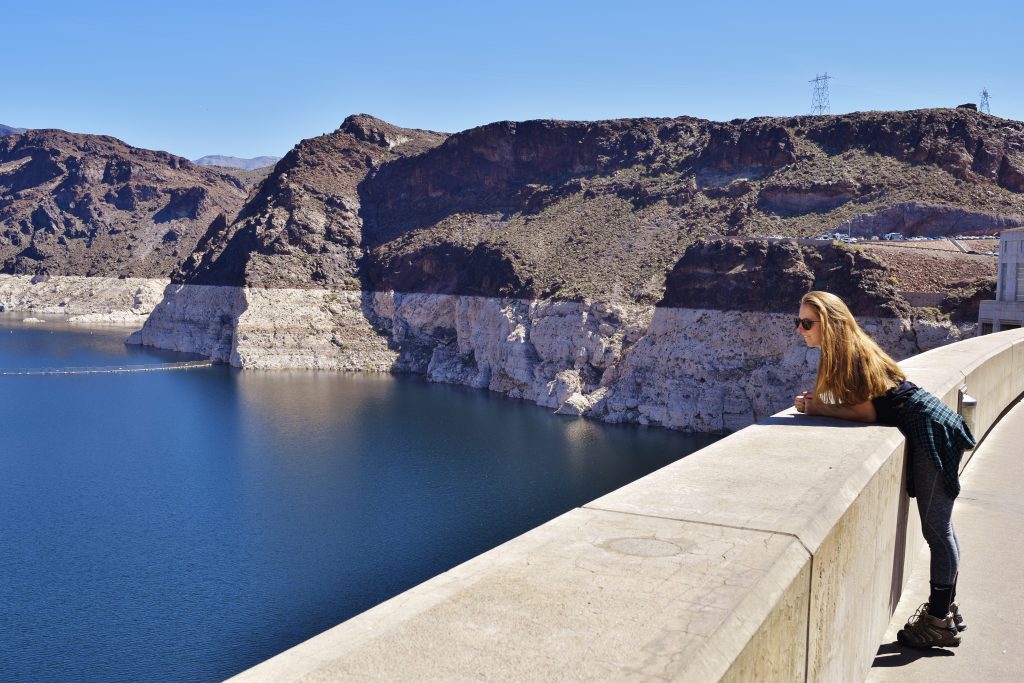
There are plenty of companies where you can buy tours of the Hoover Dam, but we decided against it – we just wanted to walk around and soak in the immense mass of concrete. A tour would have been amazing but we were all just too excited to get to the Grand Canyon.
Once we had our fill of pictures, we walked back to the car and began the 4 hour drive to the Grand Canyon. To break up the drive, we impulsively made a stop at an amazing town called Williams which is located around Historic Route 66. The feeling of nostalgia was alive in this now relatively quiet town, but I could only imagine what it must have been like in its hay day.
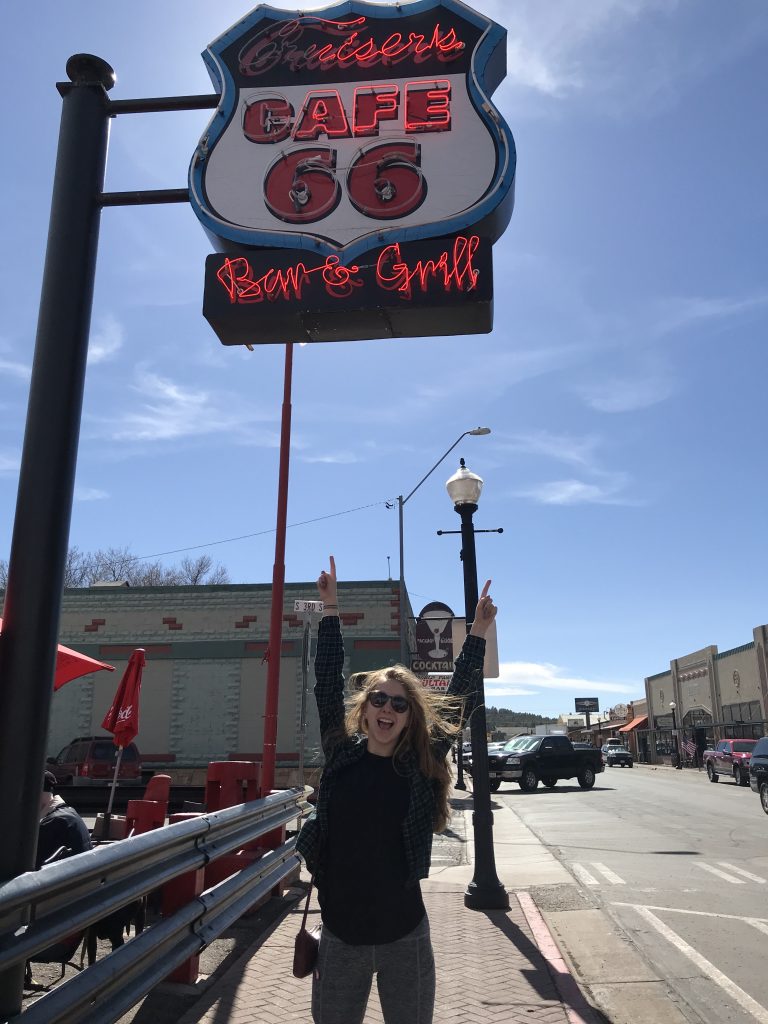
In the town, we found Grand Canyon Brewing Company which is one of the coolest breweries any of us had visited. The brewery taproom was decorated like a lodge with beautiful woodwork, a fireplace, and had a mini river running through the middle of the room. However, our favorite part of the brewery was their prices – coming from New York it was so affordable! We all vowed to go back one day.
The rest of the drive was only an hour, and we made it just in time for a sunset hike to Shoshone Point. We spent two nights in the Grand Canyon, hiking during the day and sitting by the campfire at night telling stories. If you want more information on camping and hiking in the Grand Canyon, click here .
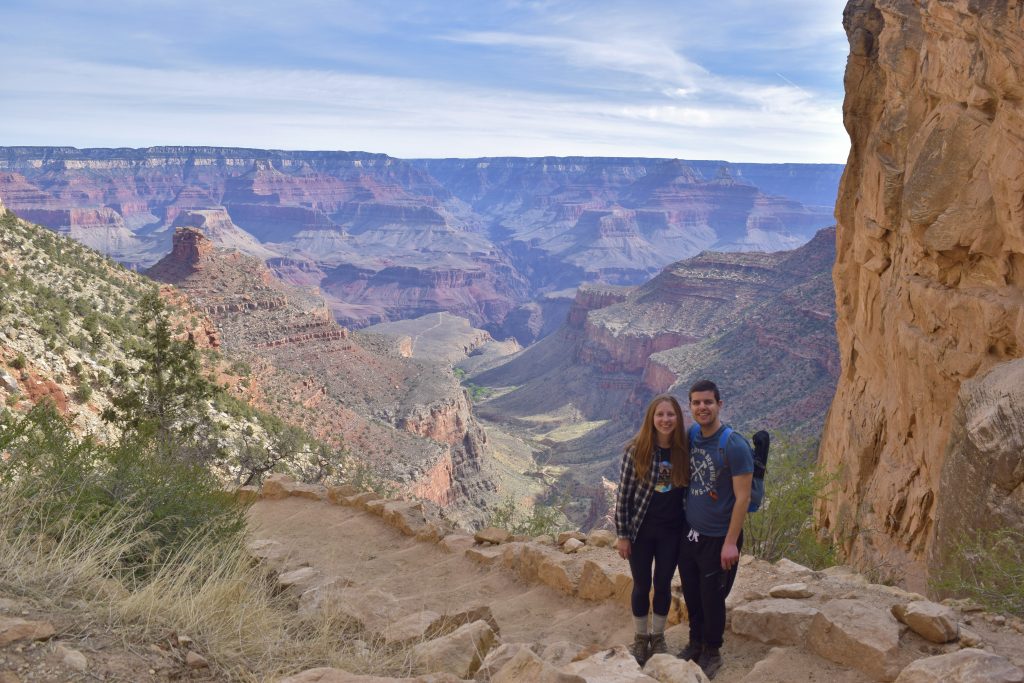
Day 3: Drive from Grand Canyon to Bryce Canyon
After spending two incredible nights at the Grand Canyon, we broke down our tents, jammed the car full (less successfully than the first day when everything was nicely packed) and headed out. We took one last look at the Grand Canyon at sunrise and then ventured on to our next destination; Bryce Canyon.
The drive between the Grand Canyon and Bryce Canyon is about 5 hours, so similar to the first day we added a stop, this time Antelope Canyon which is 2 and a half hours from the Grand Canyon South Rim and is located very near Page, Arizona. This is where we ran into our first hiccup.
If you are planning on visiting Antelope Canyon, book a tour ahead of time . To see Antelope Canyon, you must be on a tour due to the limited space available within the canyon. We were not aware of this and were unable to book a tour for the same day. We were bummed out, but thankfully there is another natural wonder only ten minutes away; Horseshoe Bend!
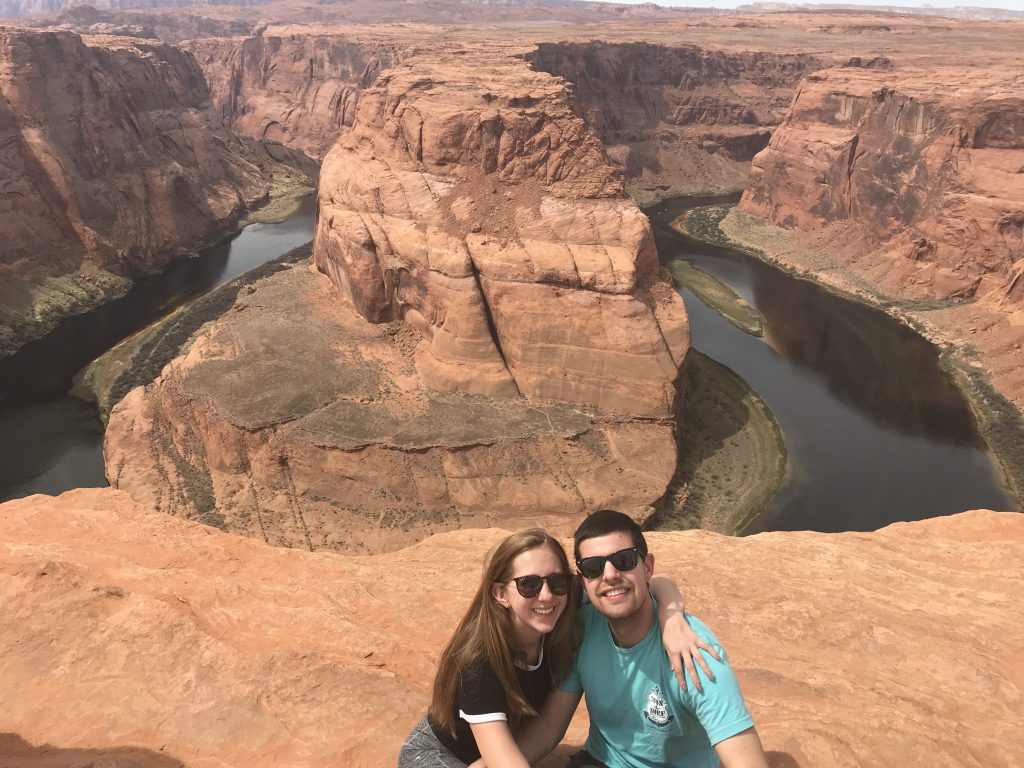
We drove over to Horseshoe Bend which is free to the public and you are not required to book a tour. There is a large parking lot where you can leave your car (if it’s full you can park on the side of the road) and take the small hike up to the bend. We spent about an hour there taking pictures and walking around, which is all the time you really need to sufficiently see it all.
From Horseshoe Bend we decided to take a stop in Page, Arizona at State 48 Tavern to have a beer and a bite to eat. We sat at the bar and had a nice, relaxing stop which was much needed before jumping back in the car for the 2 and a half hour drive to Bryce Canyon. If you want more information about how to spend one full day and night in Bryce Canyon, click here .
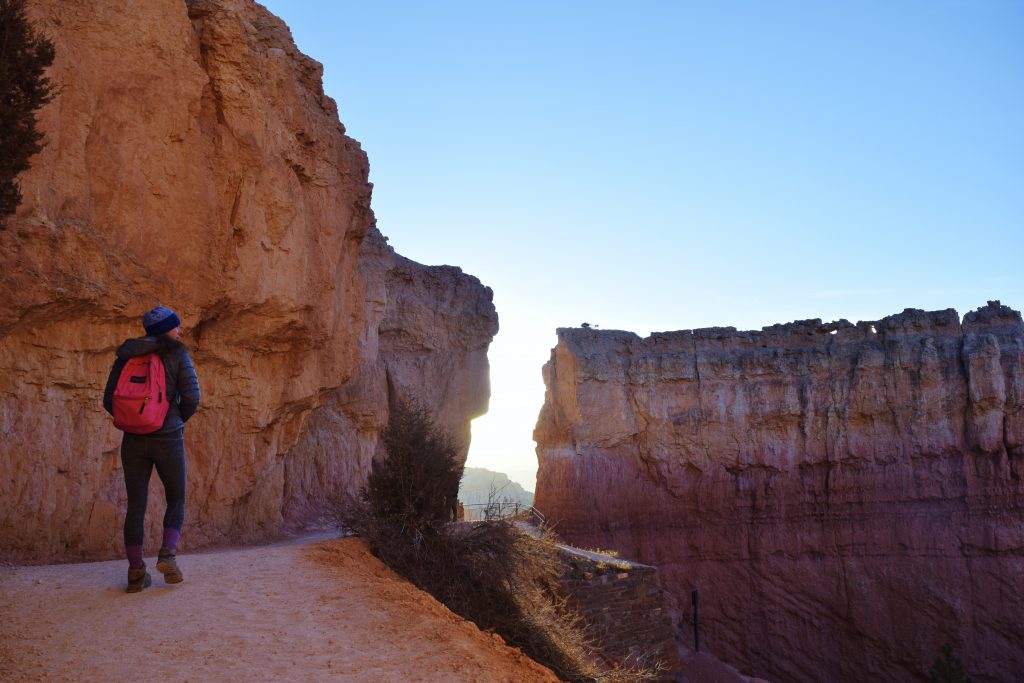
Day 4: Drive from Bryce Canyon to Zion Canyon
After spending a full day in Bryce Canyon on the 4 th day, we headed to Zion Canyon for our last national park stop of the road trip. We were comfortable spending a good portion of the morning in Bryce Canyon because the drive is only an hour and a half to Zion.
Entering Zion from the east on Route 9 is an experience you will never forget. Between the unforgettable cliffs rising all around you to the 1.1 mile Zion-Mount Carmel Tunnel which is literally carved through a mountain. You’ll want to be awake for this one! (If you’re driving, you should always be awake, guys – this was meant for weary passengers.)
We spent two nights in Zion and went on many incredible hikes! If you would like more information on camping and hiking in Zion over 2 days, click here .
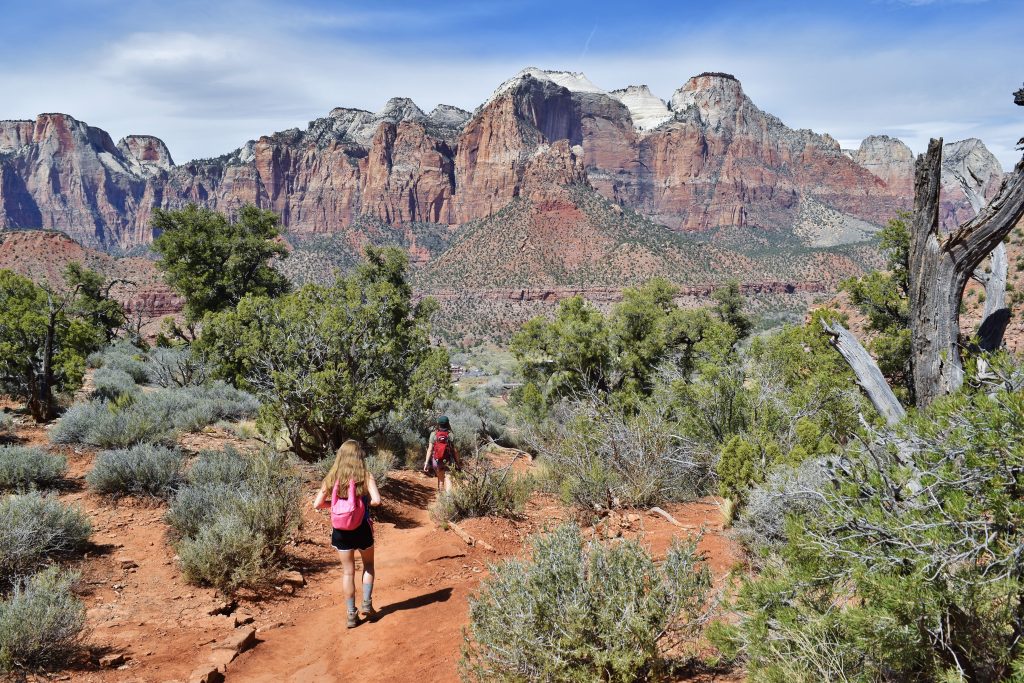
Day 6: Return to Las Vegas
We don’t really count day 6 as part of the road trip because while it’s just the journey back to Vegas which is a short 2 and a half hour drive. This will either begin your Las Vegas adventure or it will mean going back home. The last thing we had to do was return our rental camping equipment and drop off the car back at the airport. Successful road trip through three of the most amazing national parks in the US!
To make our flights out to Las Vegas worthwhile, we added 4 nights in Las Vegas to the end of our trip. Looking back, 4 nights may have been excessive in Sin City – I think we would have survived with just 2 nights.
Helpful Tips for Your Road Trip from Las Vegas
- Always have water with you, even if you have been told that a campsite has water. In our experience in late March / early April, water was scarce in campgrounds and we had to rely on gallon jugs from the store. Also, bring plenty of water on your hikes – it gets scorching hot.
- Make sure to fill up on gas whenever you are about to go a long stretch of the journey because gas stations are few and far between. As long as you manage your gas well you shouldn’t have any problems, none of the drives are terribly long as long as you break them up.
- Rent camping gear if you plan on camping in the parks – it is very affordable and then you don’t have to worry about trying to get your tent poles through security at the airport.
Pin it to Pinterest
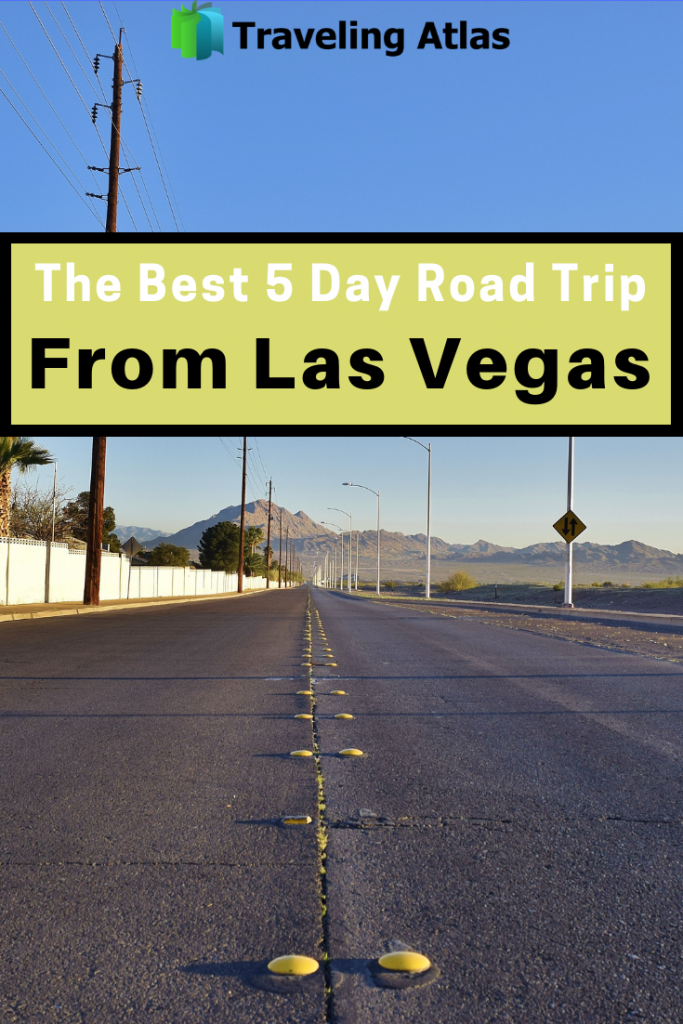
Thank you for sharing your trip and such good tips and pointers! We are heading out there in March, and planning a similar trip.
Hope you enjoy!
Leave a Comment Cancel reply
This site uses Akismet to reduce spam. Learn how your comment data is processed .
- Outdoor Adventure
- National and State Parks
The Best Itinerary For A Scenic, Unforgettable Road Trip To Utah's 5 National Parks
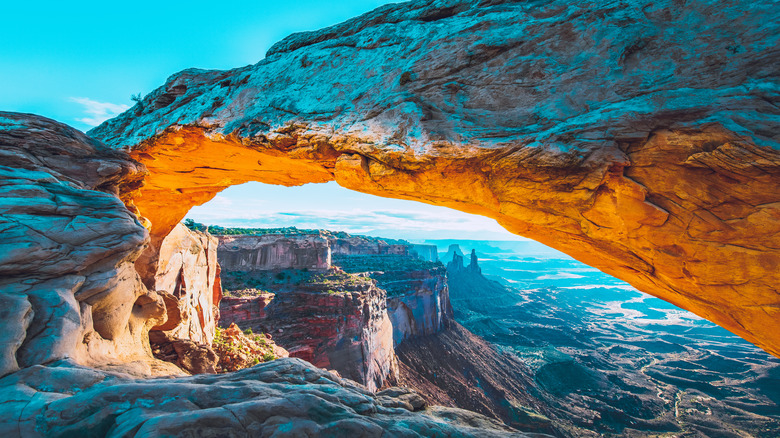
Utah's "Mighty 5" national parks are like a close-knit family, always trying to top one another in a friendly game of sibling rivalry. Zion, Bryce Canyon, Capitol Reef, Canyonlands, and Arches all have distinct personalities, made possible by their unique attributes: gorgeous canyons, otherworldly hoodoos, insightful pioneer history, captivating vistas, and imposing arches, respectively. Ten million visitors pass through them each year, and there's something for every kind of traveler.
Accessible viewpoints may tempt the indoorsy out of their air-conditioned cars, while outdoorsy types have their pick of several of the best National Park trails that are only for experienced hikers . The total driving distance to link them together, from Zion in the south to Arches in the north, is about 350 miles. Therefore, by the time someone in the back seat whines, "Are we there yet?" the answer will probably be "yes." The drive itself is an attraction, and each park has its own crown jewel of a scenic drive.
To get the most out of it all, Redditors sing the praises of GuideAlong, an app that narrates the sights as you drive, keyed to your GPS location (there's a discounted bundle for The Mighty 5). Zion National Park is closest to Las Vegas and our pick for the best place to start. Prefer Salt Lake City? Just reverse the order of our eight-day itinerary. Make it a loop, and you can include a stop at Horseshoe Bend, another much-photographed mesmerizing natural wonder .
Days 1 to 3: Zion — with and without crowds
Zion National Park is within close driving distance of Las Vegas . If it's your first stop, you might wonder if it's crowded in the summer. The answer is "yes." Is it too crowded? That's subjective, and it all depends on your mindset. If you stay positive, you'll soon trade smiles with strangers as you wade through the famous Narrows, score a hard-to-get permit, and hoof it up the crazy-scary trail to Angel's Landing. Hot tip: The view from Observation Point is even better than the one from Angel's Landing, and the hike there is a little more rigorous but a lot safer.
If you're tempted by the shoulder seasons, fall can be glorious, but spring runoffs close down the famous canyon hikes, so that might not be the best time to plan a visit. Our advice? Just go when you want. The park operates two shuttle routes in peak season, one through the park itself, stopping at viewpoints and trailheads, and another to the major hotels nearby, so you can easily spend two days exploring.
Day three takes you away from crowds to Zion's other entrance at Kolob Canyons. An hour away along the road to Bryce Canyon, Kolob is blissfully undiscovered. Book a trip with a professional outfitter, and you can try canyoneering here. Options range from gentle, introductory half-days to trips that'll have you rappelling down red rock walls in a wetsuit to plunging into pools of icy green water.
Day 4: Bryce Canyon has that hoodoo voodoo
What is a hoodoo? A spire-like geological formation formed out of soft rock walls by rainwater. Bryce Canyon National Park is home to thousands upon thousands of them, each as unique as a snowflake. Think of hiking through veritable forests made of stone. Believe us, Bryce Canyon's Amphitheater (pictured above) is every bit as stunning as that more famous Southwest hike that has become nearly impossible to do , the Wave.
The easy, must-do hike here is the Navajo Loop, which starts at Sunset Point and loops down into the Amphitheater and back, packing a lot of splendor into a short 1.4 miles. One of these is the much-photographed Wall Street, a set of switchbacks that ping back and forth between towering rock walls. It might seem like the canyon is teeming with as many pedestrians as you'd see on New York's Wall Street, but press on, as many of the selfie-stickers will turn back here.
If you are still game, add on the Peek-a-boo Loop, thick with magical stands of hoodoos, or if you are brimming with energy and confidence, tackle the magnificent Fairyland Loop, an 8-mile, challenging hidden gem. You may only need a day in Bryce Canyon, but be sure to leave enough daylight for yourself at the end of your exploration. This will help you to enjoy the 122-mile drive along Scenic Byway 12 to Capitol Reef, which is considered the best scenic drive in the state by reviewers.
Day 5: Will Capitol Reef will be your favorite?
This park is a sleeper hit among visitors, with many who tour the Mighty 5 calling Capitol Reef National Park "the mightiest of all." One highlight is the Fruita Rural Historic District, a lush, green valley filled with fruit trees and a smattering of historic buildings surrounded by soaring sandstone cliffs. Grab a slice of pie made from locally grown apples at the Gifford Homestead. Or, pick your own fruit – cherry, apple, peach, or pear, depending on the season – and take a stroll on a boardwalk to see some 1,000-year-old petroglyphs.
Then go pitch your tent on grass, under the shade of a tree, because the campground here is a veritable oasis. If that is, you scored a reservation — This is one of the 10 most difficult campgrounds in the country to book. Plan your visit for springtime, when the fruit trees have blossomed, and be prepared to swoon at the loveliness of this rural scene.
On your way from Capitol Reef to Canyonlands, make time for a stop at the wonderful Goblin Valley State Park, the Western state park that has you covered for wild outdoor adventures . If you didn't get a reservation at Fruitas, you can spend the night here at a superb campground. It offers some of the most dramatically sited glamping yurts we've ever seen, tucked among groves of goblin-shaped boulders.
Days 6 to 7: Canyonlands — on and off the beaten path
If your screen-tired eyes crave sweeping vistas, you'll appreciate Canyonlands National Park's Island in the Sky, a sandstone mesa overlooking dramatic geological formations and the elegantly snaking Green and Colorado Rivers. This is a great driving loop through the least-visited of the Mighty 5, with lots of turnouts where you can get out to gaze or take a short hike. "The viewpoints ... surpassed most of the rim viewpoints at Grand Canyon for me," writes one Redditor on r/NationalParks. This is where you will find the 0.6-mile trail to Mesa Arch, where the rising sun sets the red rock arch aglow as it rises through the span's elegant curve. This is such a popular photo-op that the parking lot can fill up well before dawn.
You can see the elegant sandstone spires called the Needles from the Island in the Sky, but it's magical to wander among them, so make this day two. The ranger-recommended hike to Druid Arch involves some scrambling and even a climb up a permanently affixed ladder, but it covers a huge variety of terrain. But there is an even better way to see remote Canyonlands: bumping along dirt roads in a jaunty jeep. Book an adrenaline-fueled 4x4 adventure tour, an experience that consistently gets rave reviews. Or, if you're truly intrepid, rent a 4x4 in Moab on your own. You'll need one to get to the trailhead for the Maze, Canyonlands' dangerous yet splendid bucket-list hike .
Day 8: Arches is a geological wonderland
Arches National Park contains over 2,000 of its namesake rock formations, and we'll never get tired of trying to see them all. These sandstone arabesques are fascinating, maybe because their swoops and curves seem full of motion, yet paradoxically, they've been standing still for thousands of years. Arches and Canyonlands are only 26 miles apart, and nearby Moab makes a perfect base for the last few days. For a side trip, an underrated state park with views like the Grand Canyon is just 30 miles away.
Arches uses a strictly timed reservation system that fills up three months in advance. But don't despair because there's a workaround: Arrive before 7 a.m. or after 4 p.m., and it's perfectly legal to drive right in. You'll want to go early anyway because sunrise at Delicate Arch is not to be missed. "One of the coolest things I've ever seen," a Redditor writes in r/NationalParks. "Watching the scenery go from blue to purple to red to orange is incredible."
At an area called Devils Garden, dense with arches, spires, and rock fins, you'll find the surprising Double O Arch. It's a whimsical delight that somehow makes you want to laugh out loud, and the awe-inspiring Landscape Arch is 6 feet wide and 300 feet long. You started at dawn, so end with a ranger-led hike through the slot canyons of Fiery Furnace, which gets its name from its electric crimson glow at sunset. A perfect end.
Recommended

Vegas to National Parks to Vegas
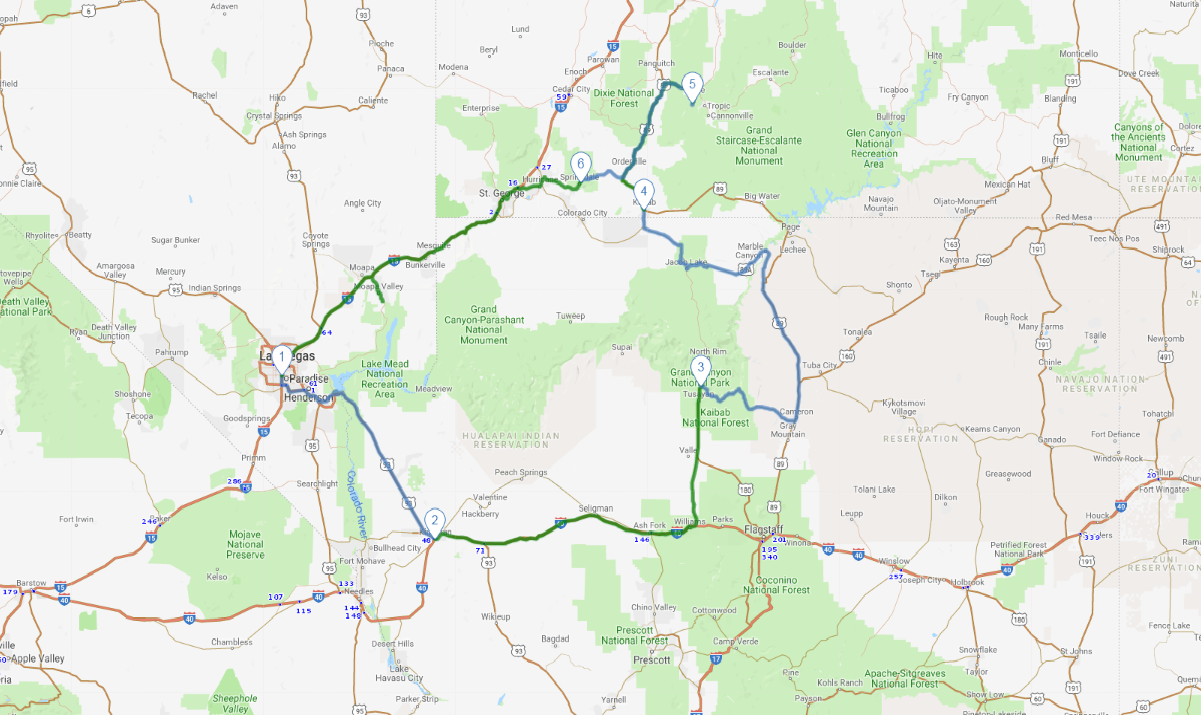

Road Trip from Las Vegas to Arches National Park
If you're looking to leave the glittering neon lights of Las Vegas behind and set off on a stunningly scenic drive from Las Vegas to the breathtaking landscape of Arches National Park with its red rock formations, then this the perfect road trip for you.
The 540-mile road trip from Austin to Denver takes 10 hours to drive. Stops include Flagstaff, Boulder, Kingman and Moab, plus Hoover Dam, Lake Mead, Zion National Park, Grand Canyon, Dixie National Forest, Bryce Canyon National Park and Canyonlands.
The drive to Arches National Park is packed full of stunning views, from pretty villages and history-rich towns to incredible parks, mountain views and world-famous sites. Read on to learn about the best routes and places to visit along the way to make the most out of your trip.
How far is Arches National Park from Las Vegas, and how long will the road trip take?
There are two distinct routes you can follow from Las Vegas to Arches National Park - namely north or south. The quickest of the two takes you north past Bryce Canyon National Park and covers a distance of 540 miles. Without stopping, this route will take 9 hours and 50 minutes.
Our Southern Route takes you via Flagstaff and the epic Grand Canyon. It's a slightly longer option in order to pack in as many fantastic attractions as possible, spanning a distance of 810 miles, it'll take you 13 hours and 20 minutes of non-stop driving to complete.
As this is a scenic road trip, we'd recommend spending three to four days and including a couple of fantastic overnight stops en route. This way you'll get longer to hike or watch a sunset or two at the beautiful locations you'll pass and divide the drive into manageable chunks.
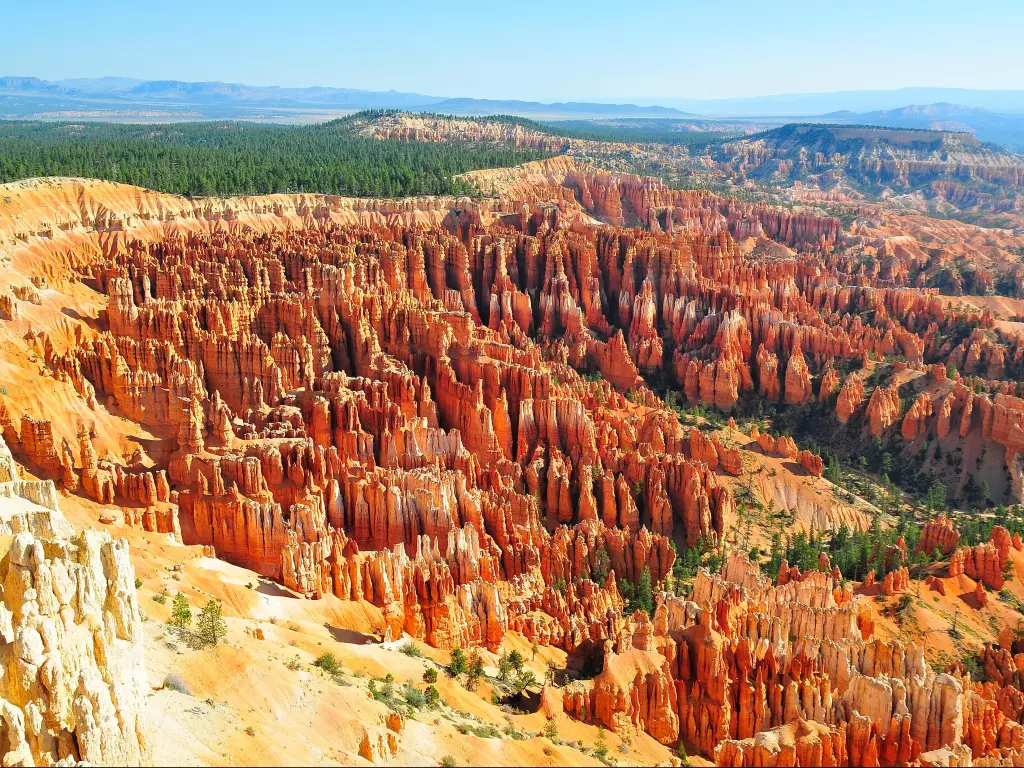
Best road trip route from Las Vegas to Arches National Park
The best route from Las Vegas to Arches National Park really will depend on your preference for places to visit along the way, as there's not a big difference in time or distance.
Our Northern Route is technically quicker, depending on how long you wish to explore the breathtaking natural landscapes encountered on the way. Every stop on the journey is filled with geological masterpieces and mountainous grandeur.
It is also a spectacular experience for the committed hiker and intrepid explorer, where you'll discover incredible views at Zion National Park and Bruce Canyon National Park, to name just a few. This is definitely an outdoor lover's paradise though, as there are less urban visits.
If you'd prefer to mix culture-rich towns with stunning parks, then you may find our Southern Route more appealing. Though this route is longer, it has more of a balance of indoor and outdoor attractions, making it a great year-round option.
Taking you through Flagstaff and Kingman, you can get your hit of historic and cultural vibes before exploring the iconic Grand Canyon or taking in the view of Hoover Dam and Lake Mead.
You might need to make a reservation for a timed-entry permit while visiting Arches National Park. Please check the national park's website for up-to-date information.
How to drive from Las Vegas to Arches National Park
The map above shows our suggestions for the best road trip routes from Las Vegas to Arches National Park. Keep reading for detailed descriptions of both routes, where to stay on either, and the best things to do on the way.
The Northern Route
Leave Las Vegas on Interstate 15 (I-15) North to Crystal, passing the stunning Valley of Fire State Park and Desert National Wildlife Range further west.
Cross into Arizona and then quickly into Utah towards Zion National Park, a stunning place to explore with mountains, waterfalls and incredible hiking trails.
At Mt Carmel Junction follow US-89 North where you can visit Dixie National Forest to the west and Bryce Canyon National Park to the east.
You will then drive through Cannonville to Boulder, where you can visit the nearby Grand Staircase-Escalante National Monument or Capitol Reed National Park.
Follow UT-24 and either detour to Fish Lake Hightop if you'd like a waterside stop or continue east to I-70 and near Canyonlands National Park. Head south towards Moab where you'll reach your destination of Arches National Park.
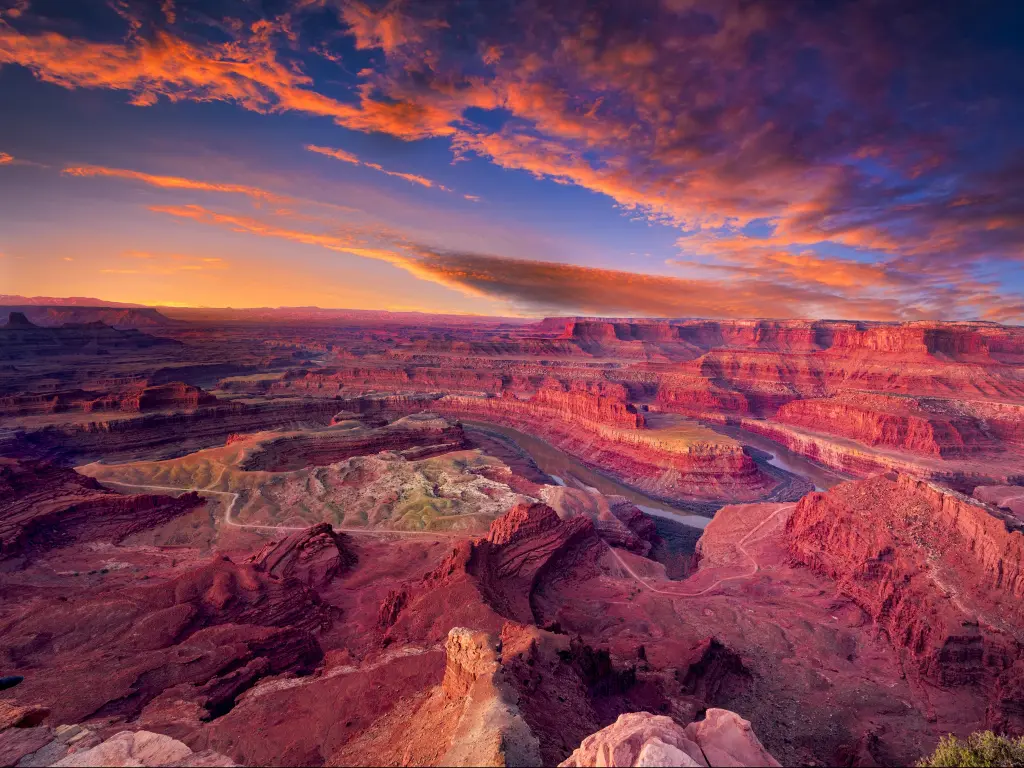
The Southern Route
Our alternative route takes you from Las Vegas on I-11, passing Sloan Canyon National Conservation Area and to Hoover Dam where you can stop and explore stunning Lead Mead.
Continue south on US-93 to Kingman, before taking the interstate east to Flagstaff, passing several towns and driving through Coconino National Forest.
At Flagstaff, you can drive to the South Rim of the Grand Canyon, through Kaibab National Forest, or continue north on US-89 and detour to the Grand Canyon just before Cameron.
Either way, you'll pass Wupatki National Monument as you drive north towards Vermilion Cliffs National Monument at Marble Canyon.
Follow the road towards Page, where you can visit Lake Powell and then join AZ-98 and US-160 East towards White Mesa. Pass Canyons of the Ancients National Monument and Canyonlands National Park before reaching Moab and Arches National Park.
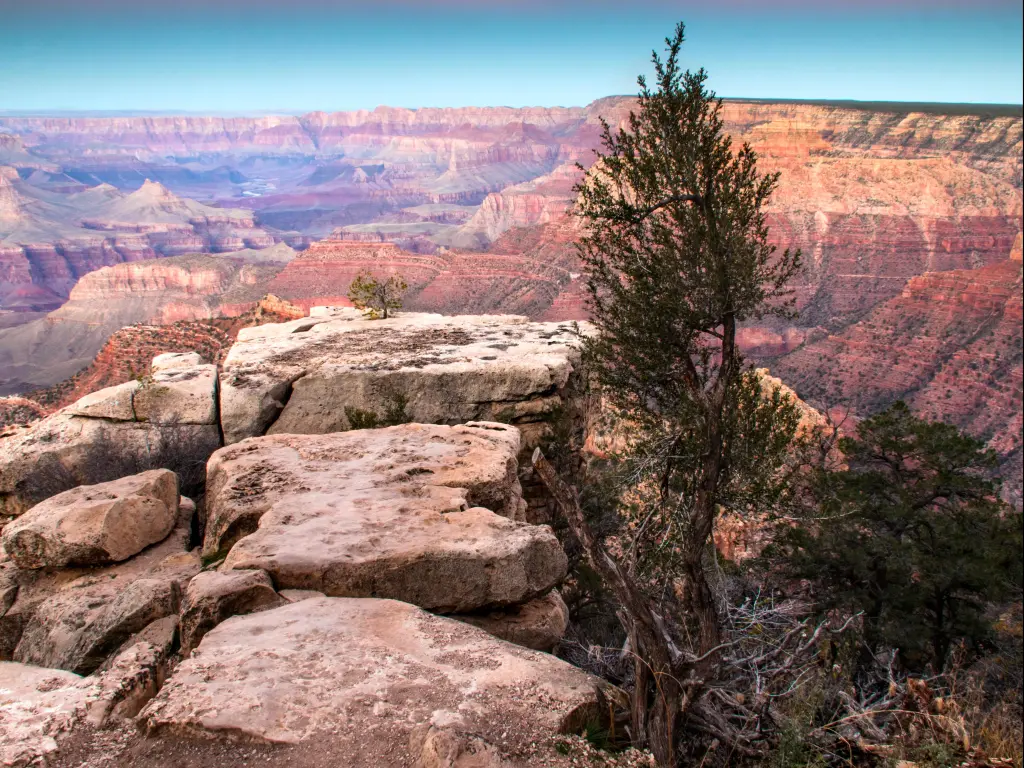
Best places to stop between Las Vegas and Arches National Park
Despite only being a short drive from Sin City to Arches National Park, you'll still have plenty of great overnight stop options that you can plan. Here are a couple of our favorite places to rest at, which offer great attractions and fun things to do while visiting.
Enjoy Utah's hospitality at Panguitch
If you decide to follow the Northern Route to Arches National Park, then an ideal halfway point if you're looking to split the journey over two days is the town of Panguitch.
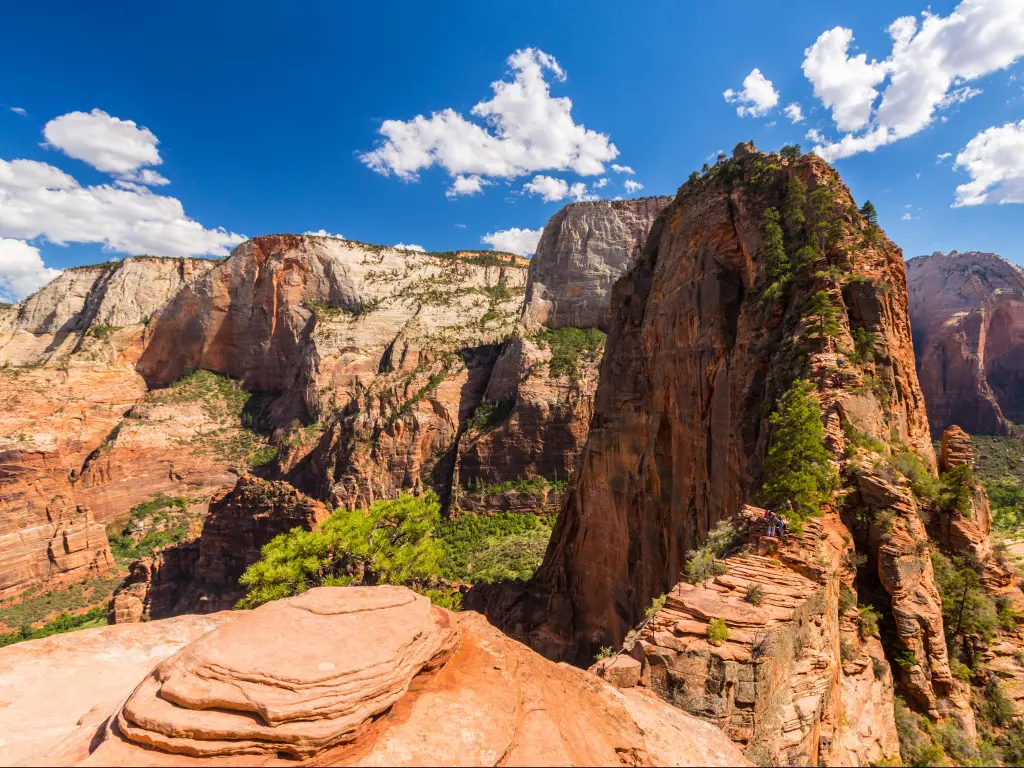
There are a couple of nearby places to stop, but for a cozy and convenient rest we'd recommend The Panguitch House . Expect clean and bright rooms and a welcome hot breakfast every day. It has free parking and is just a short walk to the historic city of Panguitch.
You'll get an authentic western experience at this home-from-home resort. If you don't feel like traveling far, there are beautiful gardens to explore and even an outdoor dining area.
Being located so close to Bryce Canyon National Park and Zion National Park you might want to venture out though if you're looking to spend some time hiking at these great locations or hunting for a spectacular sunset view.
Other great attractions close by include Panguitch Lake where you can enjoy camping, fishing or boating, and Cedar Breaks National Monument which is a stunning natural amphitheater of crumbling red cliffs.
Stunning views at Flagstaff
Known as the gateway to the Grand Canyon, Flagstaff is a real highlight on our Southern Route . And just four hours from Las Vegas, it also makes a perfect first stop en route to Arches National Park.

Flagstaff itself is a beautiful town which offers stunning mountain activities and outdoor natural beauty. It is a training ground for many Olympic US teams due to its seasonal climate, meanwhile the town itself is a vibrant place to explore with many restaurants and shops.
Another great nearby site is Wupatki National Monument, an age-old pueblo that was home to the Anasazi and Sinagua tribes. Plus of course, visiting the epic Grand Canyon or the lesser-known Walnut Canyon is a must!
Stop at High Country Motor Lodge and you won't be disappointed . Located on the historic Route 66, this stylish hotel will provide for all your relaxation needs. It has free parking, a gym, a pool, a sauna and a chic restaurant and bar where you can unwind after a long day of site seeing.
Not only does this great hotel make a convenient stop on your road trip, but it's a great location for visiting the Grand Canyon and still within walking distance to Flagstaff's popular downtown.
READ MORE - Click here for great hotel options
Stay at the gateway to Arches National Park
While you can't stay within Arches National Park itself, the closest town Moab offers a fantastic base to explore. Nestled among the mountains, Hoodoo Moab, Curio Collection by Hilton features rooms which boast majestic views , fantastic amenities and free parking.
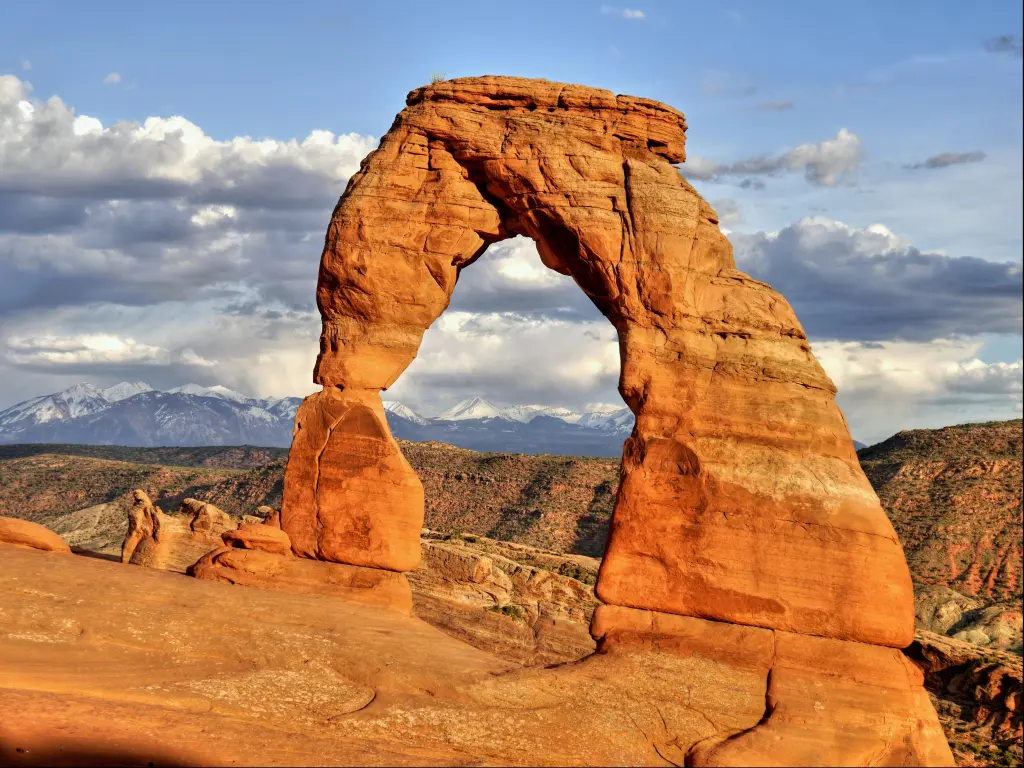
Located in Moab and just two miles from Arches National Park, this 4-star hotel is also just a short drive from Canyonlands National Park and Castle Valley.
After exploring these stunning parks, you can relax by the hotel's fabulous outdoor pool (with views!) or enjoy a meal at the onsite restaurant. Moab itself is surrounded by mountains, scenic rivers and forests, making it a stunning destination in its own right.
Things to see on a road trip from Las Vegas to Arches National Park
Both routes to Arches National Park offer a huge variety of great towns, national parks, forests and lakes to explore. If you're limited on time, we've set out a list of the highlights you'll pass along the way which will help you plan your own epic adventure.
Both Routes
- Kaibab National Forest - Come here for great hiking trails, camping, fishing or just to admire the forest before exploring nearby Grand Canyon.
- Grand Canyon National Park - This world-renowned and historic site is full of magnificent landscapes: canyons, mountains, cinder cones and basalt flows. It also contains archaeological remains of ancient humans. It is an area not to miss.
- Moab - A gateway to Arches National Park, as well as being close to Canyonlands National Park, Moab is a city in Utah that's surrounded by mountains. Make sure to visit the dinosaur tracks at Bull Canyon Overlook or discover Native American rock art, or simply enjoy a hike.
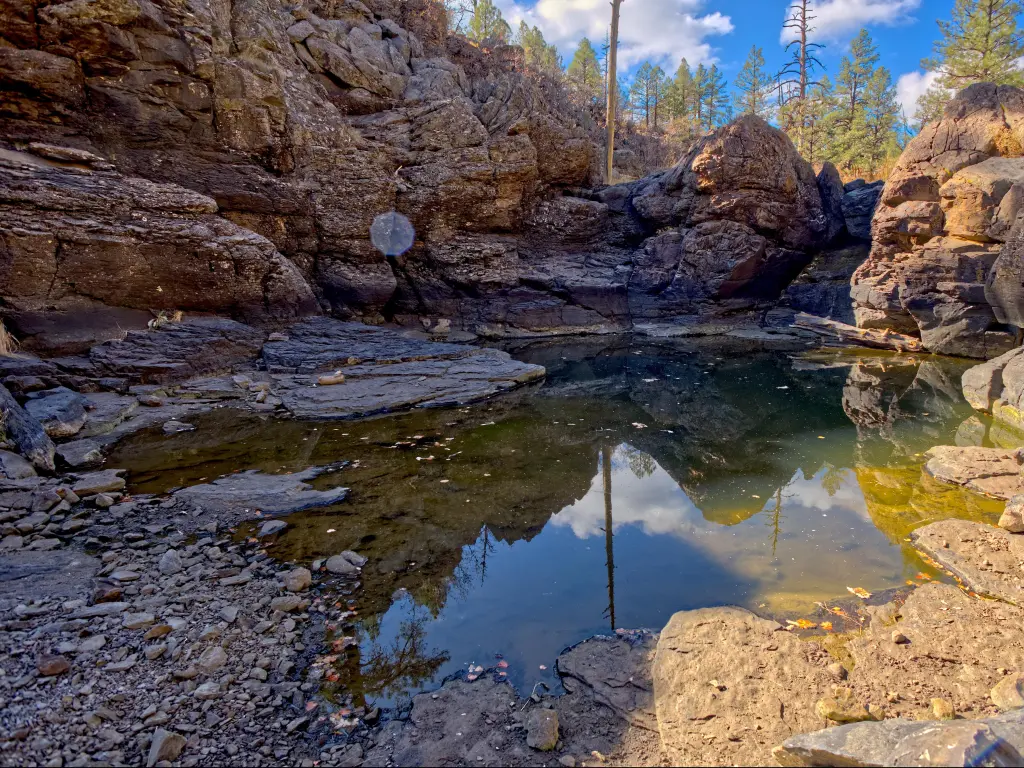
- Valley of Fire State Park - This stunning park features striking and beautiful red rock formations. As well as offering stunning views, there are great hiking trails to follow and 2,000-year-old petroglyphs to spot.
- Zion National Park - This stunning nature preserve is a hiker's dream with its red cliffs and forest trails that follow the Virgin River revealing waterfalls and hanging gardens. If you'd like to hike up to Angels Landing, you will need a permit and will need to make a reservation. Check the Zion National Park's website for more details.
- Dixie National Forest - Soak up nature's beauty in this two-million-acre nature reserve filled with mountains, lakes and Ponderosa pines. It is a great place to hike, camp or fish.
- Bryce Canyon National Park - This unusual reserve is known for its expanse of red hoodoos or natural pointed rock formations. It also has spectacular lookout points.
- Grand Staircase-Escalante National Monument - This monument is a geologist's dream. With its plateaus and the stunning Willis Canyon, it is a wonderful place to walk or drive and see nature's majesty.
- Capitol Reef National Park - Explore this hidden treasure packed full of cliffs, canyons and hiking trails for all abilities. There's also a fantastic view from Panorama Point and petroglyphs to enjoy.
- Boulder, Utah - This town intersects with the Burr Trails. There are ancient remains from Indian tribes and beautiful natural landscapes such as the Vermillion Cliffs and Devils Garden.
- Capitol Reef National Park - This desert park surrounds the Waterpocket fold. It is known for its white sandstone domes and other striking natural rock formations.
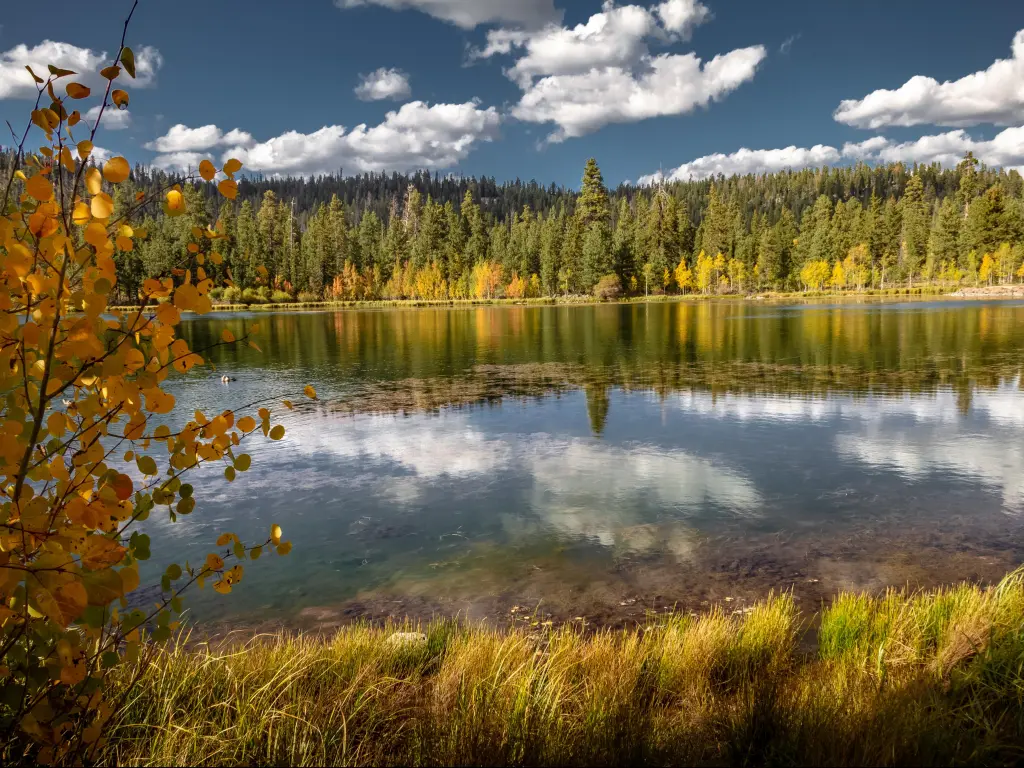
- Hoover Dam - This Great Depression-era concrete dam is located in the Black Canyon and is the largest reservoir in the US when full. It is a sight to see.
- Lake Mead - A stunning reservoir created by the Hoover Dam, Lake Mead is well worth a visit. Despite its water level dropping, you can still enjoy a boat ride, hike or admire the landscape around the reservoir.
- Kingman, Arizona - This city located on the famous Route 66 is home to numerous museums that give the visitor an understanding of the history of the area. It's a great stop to relax in an urban setting and learn about the west's history.
- Flagstaff - Known as the gateway to the Grand Canyon, Flagstaff is a great town to explore and offers mountain views, great restaurants and several fantastic sites within a short drive away.
- Coconino National Forest - With red rocks and pine forests, Coconino National Forest is a diverse and fascinating place to explore. Expect mountains, canyons, rivers and streams and enjoy great hikes, fishing or even a swim!
- Wupatki National Monument - The national monument in Arizona was once home to a thriving community. The Pueblos and other formations at the Wupatki National Monument are a striking imprint on the landscape and make for a really interesting visit. i
- Vermillion Cliffs National Monument - These stunning red cliffs are home to endangered California condors. Its views and wave-like rock formations are also not to be missed.
- Monticello, Utah - This city is located on the Old Spanish Trail route and is known for its hiking trails, archaeological sites and places of education.
- Canyonlands National Park - The dramatic landscape of Canyonlands National Park is definitely worth a visit. Discover towering rock pinnacles and remote canyons, enjoy a mountain bike hike or simply admire the view around this incredible site.
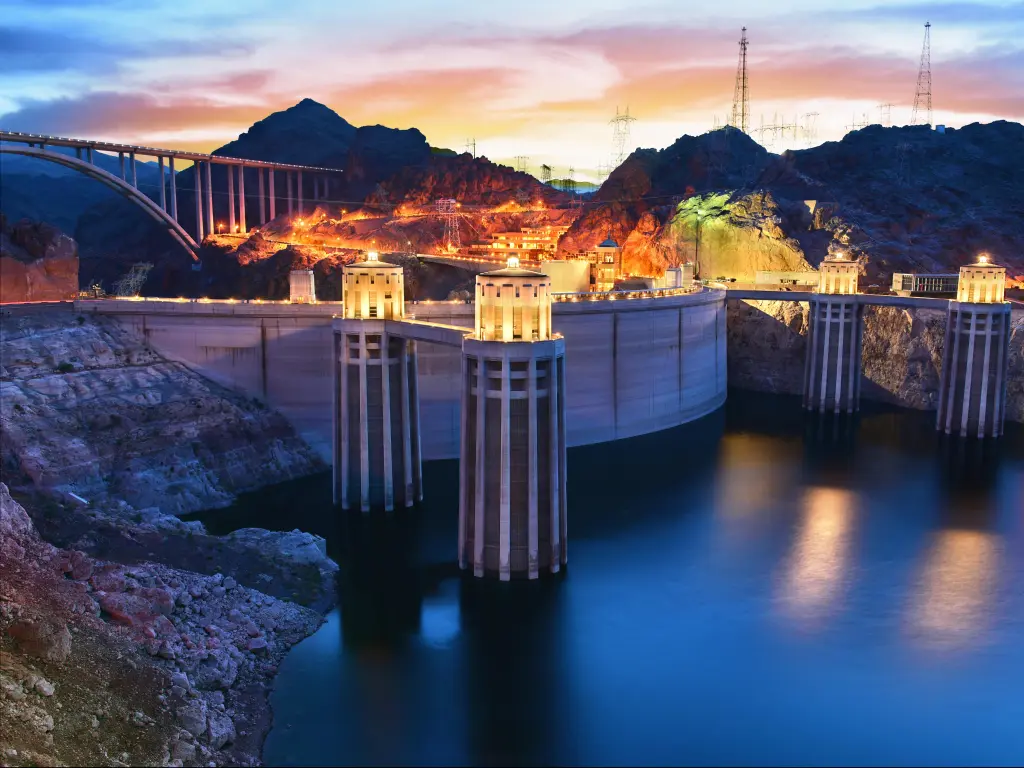
Best time to go on a road trip from Las Vegas to Arches National Park
While you can visit Arches National Park year-round, the best time will likely be determined by your preference of temperature and whether busy crowds are a dealbreaker.
During the summer months temperatures in this part of Utah can be quite drastic—at times over 100 degrees Fahrenheit. The heat will not only draw large crowds, but you'll find the temperature really challenging if you're hoping to enjoy some hiking along the way. You also need to watch out for flash flooding.
In comparison, winter can be a great time to visit. With fewer crowds and cooler temperatures averaging between 30 and 50 degrees, you'll get to enjoy the tourist hotspots without compromising on the view.
That said, the low temperatures and potential for snow can make trails dangerous to traverse and you might experience closed roads and parks along the way.
The shoulder seasons of spring and fall tend to be popular seasons to visit this area. Early morning and late afternoon, during this time of year, are great for avoiding heavy crowds, meanwhile, you'll get treated to stunning blossoms or fall foliage in the forests along the way.
Join our email list!
By joining our email list, you give LazyTrips permission to use your email for sending you newsletters, emails and updates including for marketing purposes. Your email will not be provided to third parties.
Related posts
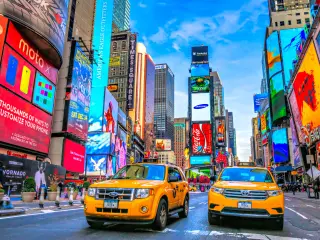
Already have an account? Log in
National Geographic content straight to your inbox—sign up for our popular newsletters here

5 lesser known national parks to add to your bucket list
These more remote U.S. parks, from Alaska to American Samoa, are kept well away from the bustling crowds.
The national parks in the United States are chosen for their natural, historic, and cultural values and are specially designated by an act of Congress or executive order. They vary in size from a single home—the smallest site is Thaddeus Kosciuszko National Memorial in Pennsylvania— to larger than the size of Switzerland, as is Wrangell–St. Elias National Park and Preserve in Alaska.
Some of the sites that become national parks might not be the most trodden; some may take a little more exploration to find. Here are five of those kinds of parks.
Hot Springs National Park

This park’s pine-, oak-, and hickory-forested mountains encircle the northern edge of the city of Hot Springs, Arkansas, which is centered over 43 thermal springs and 26 miles of hiking trails. Congress created Hot Springs Reservation in 1832, 40 years before it established Yellowstone.
Even before official park designation in 1921, Hot Springs had become a destination for curing health issues such as nervous disorders and arthritis. Seeping through Ouachita Mountain rocks as rainwater more than 4,000 years ago, the fossil water is heated to an average temperature of 143°F (62°C) by the natural heat of Earth a mile underground. Artesian pressure forces the water up through a fault to the base of Hot Springs Mountain.
Each day the reservoir collects about 700,000 gallons of water. In addition to bathing, visitors come to tour eight ornate, late Victorian-era bathhouses—many in the Spanish colonial style—along Bathhouse Row.
Indiana Dunes National Parks

With its 15 miles of shore under the constant sculpting forces of Lake Michigan’s wind and waves, Indiana’s only national park has high sands from which visitors can see the skyline of Chicago across the lake.
The phenomenon of singing sands, which may occur once a month under optimal conditions, can be heard from 30 feet away. It’s caused by the quartz crystals, moisture, and friction from footsteps, which creates a clear, ringing sound.
Trails lead through the park’s dunes, wetlands, prairies, and forests, home to more than 1,100 species of vascular plants. The park also shelters more than 60 historic structures, including houses from the 1933 Chicago World’s Fair.
Theodore Roosevelt National Park

Tucked away in southwestern North Dakota, with the South and North Units 70 miles apart and the tiny Elkhorn Ranch Unit in between, this isolated park offers wind-scoured, multicolored badlands; hundreds of species of wildflowers; and an unexpected amount of wildlife, including wild horses, deer, elk, pronghorn antelope, bighorn sheep, and bison, the species that Theodore Roosevelt—hunter, conservationist, and namesake of the park— helped save from extinction.
Roosevelt acquired Elkhorn Ranch in 1884 and returned repeatedly to raise livestock and pursue “the strenuous life.” His experience later inspired him to protect 230 million acres of park and public lands nationwide. Although conservation is a cornerstone of Roosevelt’s presidential legacy, some of his policies uprooted and devastated Native Americans, including the Three Affiliated Tribes—the Mandan, Hidatsa, and Arikara Nation—who once inhabited this parkland.
Gates of the Arctic National Park and Preserve
Unlike any other national park, this giant park is entirely above the Arctic Circle. In the northern park during winter, the sun doesn’t rise for nearly a month; in summer the sun doesn’t set for nearly two months.
Beneath thousands of caribou paths, melting permafrost soaks the tundra in summer, watering a wealth of Lilliputian plant life from underground. By August, autumn cooling and snow turn the lush carpet of plants a brilliant scarlet and gold. Looking across the vast tundra can be disorienting. With few visual cues, distant grizzlies look like nearby ground squirrels.
The park approximates the wonders of the Great Plains before settlement: Wolves chase moose through the dwarf willow, grayling flit through pellucid waters, sandhill cranes strut along the riverbanks, and huge herds of caribou migrate through—their leg ligaments clicking like castanets—in an uncountable blur.
National Park of American Samoa

Closer to New Zealand than the United States, American Samoa (“sacred earth”) is the most farflung and usually the least visited in the National Park System.
The park units are on portions of Tutuila, Ta’ū, and Ofu, three of the islands that make up the only U.S. territory south of the Equator. The park protects a paleotropical rainforest and more than 350 species of native birds; its only native mammal is a bat.
A third of the park is marine waters, with 250 coral species and 950 species of fish. Fishing is world-class, and Ofu Island has a protected reef for snorkeling and diving, along with a famous white-sand beach. Warm and humid, Samoa has a wet season that runs from November through April.
Fuel their curiosity with your gift
Related topics.
- NATIONAL PARKS
- NATIONAL FORESTS
You May Also Like

How a wild river became a national park—and sparked a movement

Can the Selfie Generation Unplug and Get Into Parks?

Explore otherworldly realms in this national park
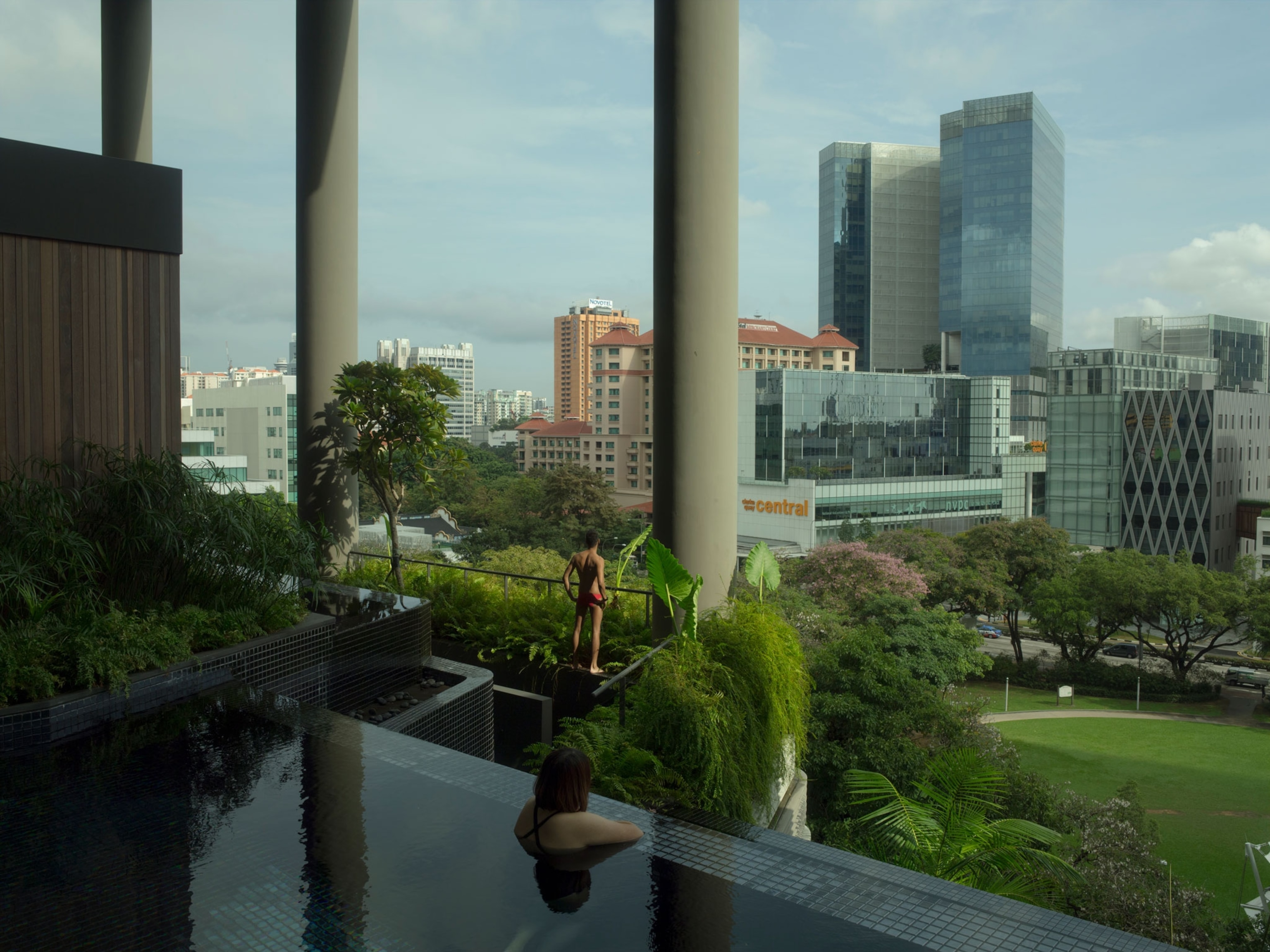
Nature really is good medicine. Science can explain why.

1 million acres of ‘sacred’ land near Grand Canyon are receiving new protections
- Environment
- History & Culture
History & Culture
- Gory Details
- Mind, Body, Wonder
- Adventures Everywhere
- Terms of Use
- Privacy Policy
- Your US State Privacy Rights
- Children's Online Privacy Policy
- Interest-Based Ads
- About Nielsen Measurement
- Do Not Sell or Share My Personal Information
- Nat Geo Home
- Attend a Live Event
- Book a Trip
- Inspire Your Kids
- Shop Nat Geo
- Visit the D.C. Museum
- Learn About Our Impact
- Support Our Mission
- Advertise With Us
- Customer Service
- Renew Subscription
- Manage Your Subscription
- Work at Nat Geo
- Sign Up for Our Newsletters
- Contribute to Protect the Planet
Copyright © 1996-2015 National Geographic Society Copyright © 2015-2024 National Geographic Partners, LLC. All rights reserved

IMAGES
VIDEO
COMMENTS
10-Day Las Vegas National Parks Road Trip: Logistics Car Rentals. For our road trips, we typically like to pick up rental cars from a nearby airport (there's often more availability at the airports compared to rental car shops in town). For this road trip, aim to pick up a rental car from the LAS airport. ...
Distance and Travel time from Las Vegas to Zion. Distance from Las Vegas to Zion: About 160 miles. Travel time from Las Vegas to Zion: around 2 hours 40 minutes drive. If you have time, spend a night or two inside the park, but even if you only have time to drive through Zion, do it.
Las Vegas to Joshua Tree National Park. 215 miles. 3.5 hours. Visiting Joshua Tree National Park on a road trip from Las Vegas is a timeless Nevada to California road trip. Located in southern California, both families and solo travelers alike will enjoy Joshua Tree's peaceful desert beauty and starry dark skies.
Distance between Bryce Canyon National Park and Las Vegas. The distance between Bryce Canyon National Park and Las Vegas is about 270 miles. This means that it would take around 4 hours to drive from one location to the other. However, the drive is definitely worth it because of the amazing scenery along the way.
Joshua Tree National Park. 🚗 190 miles ⏱️ 3 hours, 40 minutes. See the quirky Joshua trees and rugged rock formations at Joshua Tree. Explore the park's unique desert landscape, hike among towering Joshua trees, and marvel at the stunning rock formations and star-filled night skies.
2. Zion National Park. Closest City: Springdale, Utah. Distance from Las Vegas: 2 Hours 30 Minutes / 160 Miles. Zion National Park is the closest of Utah's "Mighty 5" national parks to Las Vegas. Located 2.5 hours from Sin City, Zion National Park makes for the perfect weekend getaway.
Day three: Drive to Capitol Reef National Park. Day three of your 5-day Utah National Parks road trip from Las Vegas is another packed one. Start your day early and make the 2-hour drive to Capitol Reef National Park. Capitol Reef is famous for its unique geology, famous petroglyphs, and beautiful orchards.
Passes are good for one year and can be bought online or upon entry into national parks. Southern Utah & Northern Arizona Road Trip. LAS VEGAS TO WILLIAMS - 216 MILES. DIRECTIONS: Head south on the 93 and then east on the 40 until you reach Williams. It should take about three and a half hours.
The combination of natural wonders and cultural encounters makes it a must-visit National Parks Close To Las Vegas. Death Valley National Park - National Parks Close To Las Vegas. Distance from Las Vegas: About 120 miles northwest of Las Vegas (Furnace Creek Visitor Center) Route: Take US-95 N and then follow signs to Death Valley
It's a great day out if you're searching for a 3-hour long road trip from Las Vegas with incredible views or something to add to your itinerary visiting other Utah national parks. Cedar Breaks National Monument is a natural amphitheater that spans over 3 miles with a depth of 2,000 feet offering an absolutely stunning view.
1.2 Where to Stay. 1.3 What to Pack for a Road Trip from Las Vegas. 2 The Best Road Trips from Las Vegas. 2.1 Grand Canyon National Park. 2.2 Joshua Tree National Park. 2.3 Death Valley National Park. 2.4 San Francisco. 2.5 Los Angeles. 2.6 Zion National Park.
Six national parks, three state parks, numerous national monuments, and countless off the beaten path surprises: this is the ultimate Southwest road trip. ... Stop One: Las Vegas, Nevada. My Southwest road trip itinerary has you starting in Las Vegas for a variety of reasons: the first being that renting a car in Vegas is loads cheaper than ...
United States. Phone +1 760-786-3200. Web Visit website. The closest U.S. National Park that you can reach from Las Vegas is Death Valley, just 120 miles away across the state border in California. To reach the Visitor Center in Furnace Creek, it's only a two-hour drive from Las Vegas and can be done in a day trip.
Private Day Tour to Zion National Park From Las Vegas by Detours American West. Zion National Park is located in southern Utah and is about 2.5 hours from Las Vegas. Zion National Park is a beautiful nature preserve with steep cliffs, beautifully colored rocks, and endless scenic routes. Zion is Utah's first national park.
Read more: The Ultimate U.S. National Parks Guide. Grand Circle Road Trip Itinerary: Day 1 Arrive in Las Vegas. 4x4s make driving through the off-road section of Capitol Reef National Park a breeze. The easiest way to start your grand circle road trip is from Las Vegas. There are plenty of flights to this airport (including many budget airlines ...
Distance from Las Vegas: 2 hours, 40 minutes (160 miles). Zion is one of our country's most visited national parks, in part because it is within a day's drive of several metropolitan areas ...
Length. Day 1: Las Vegas to Zion National Park. The first day of your RV adventure will take you to Zion National Park, a natural wonderland of red cliffs, narrow canyons, and cascading waterfalls. The drive from Las Vegas to Zion National Park only takes around three hours, so you'll have plenty of time to enjoy the park.
Great Basin National Park. Located 4.5 hours from Las Vegas, Great Basin National Park is located in east-central Nevada just past the Utah border. It is a diverse park that is home to the 13,063-foot Wheeler Peak and the Lehman Cave, which offers tours to see the stalactites and stalagmites.
TripSavvy / Alisha McDarris. Distance: 471-523 miles. Approximate time: 7.25-9.75 hours, depending on the route. Arches contain some of the country's most amazing natural wonders—mammoth rocks and arches formed from erosion. Perhaps one of the most important facts about Arches is that the park is constantly evolving.
Distance from Las Vegas: 218 miles. Driving time: 3 hours and 21 minutes. Joshua Tree National Park is such a great park to visit on your Vegas trip! Whether you like adventure such as rock climbing or bouldering, or just want a scenic drive and some simple hikes, Joshua Tree National Park will keep you entertained.
The drive from Springdale to Las Vegas takes a little over 2.5 hours. You could even catch a red-eye flight that night. However, I recommend checking into a Vegas resort and relaxing by the pool for a day or two. You earned it on this whirlwind road trip. Looking for other itineraries from Las Vegas, check out my post 7-Day Las Vegas, Grand ...
Successful road trip through three of the most amazing national parks in the US! To make our flights out to Las Vegas worthwhile, we added 4 nights in Las Vegas to the end of our trip. Looking back, 4 nights may have been excessive in Sin City - I think we would have survived with just 2 nights. Helpful Tips for Your Road Trip from Las Vegas
Utah's "Mighty 5" national parks are like a close-knit family, always trying to top one another in a friendly game of sibling rivalry. Zion, Bryce Canyon, Capitol Reef, Canyonlands, and Arches all have distinct personalities, made possible by their unique attributes: gorgeous canyons, otherworldly hoodoos, insightful pioneer history, captivating vistas, and imposing arches, respectively.
12 National Parks Near Las Vegas to Visit This Year. ... I've taken two previous road trips from Vegas to Zion National Park and am dying to hop back in the car for my third! Zion National Park is located just less than 3 hours away from Las Vegas. The national park spans more than 150,000 acres and includes canyons, cliffs, rivers, and forests.
192.0 miles: 3 hours, 32 minutes. The red-hued Zion-Mount Carmel Highway leads you from the park toward I-15 and Las Vegas. After exiting Zion National Park, the route passes several tiny communities before entering the town of Hurricane. This makes a great stopping point to stretch your legs before the 2-hour interstate jaunt to Vegas.
13 hours 20 minutes. There are two distinct routes you can follow from Las Vegas to Arches National Park - namely north or south. The quickest of the two takes you north past Bryce Canyon National Park and covers a distance of 540 miles. Without stopping, this route will take 9 hours and 50 minutes. Our Southern Route takes you via Flagstaff ...
These more remote U.S. parks, from Alaska to American Samoa, are kept well away from the bustling crowds. The Gates of the Arctic National Park, in Alaska, is one of the marvels of the U.S ...